Sardine garum
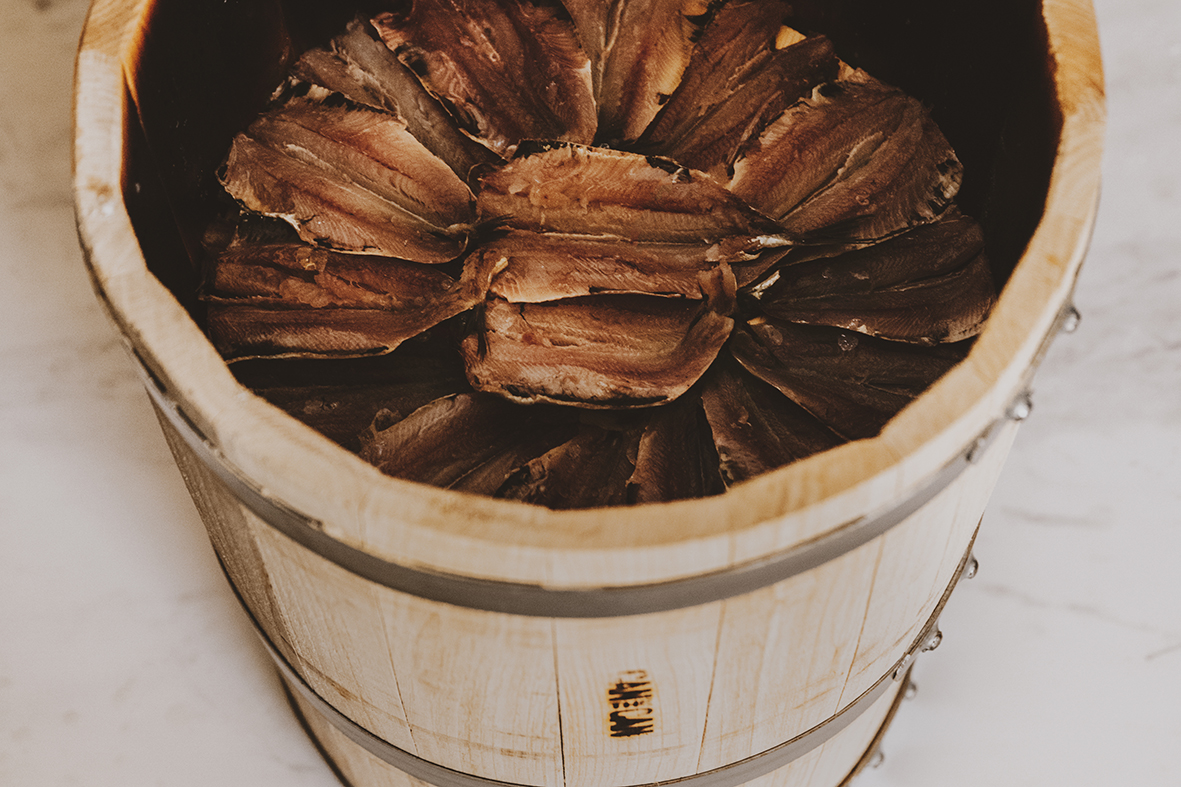

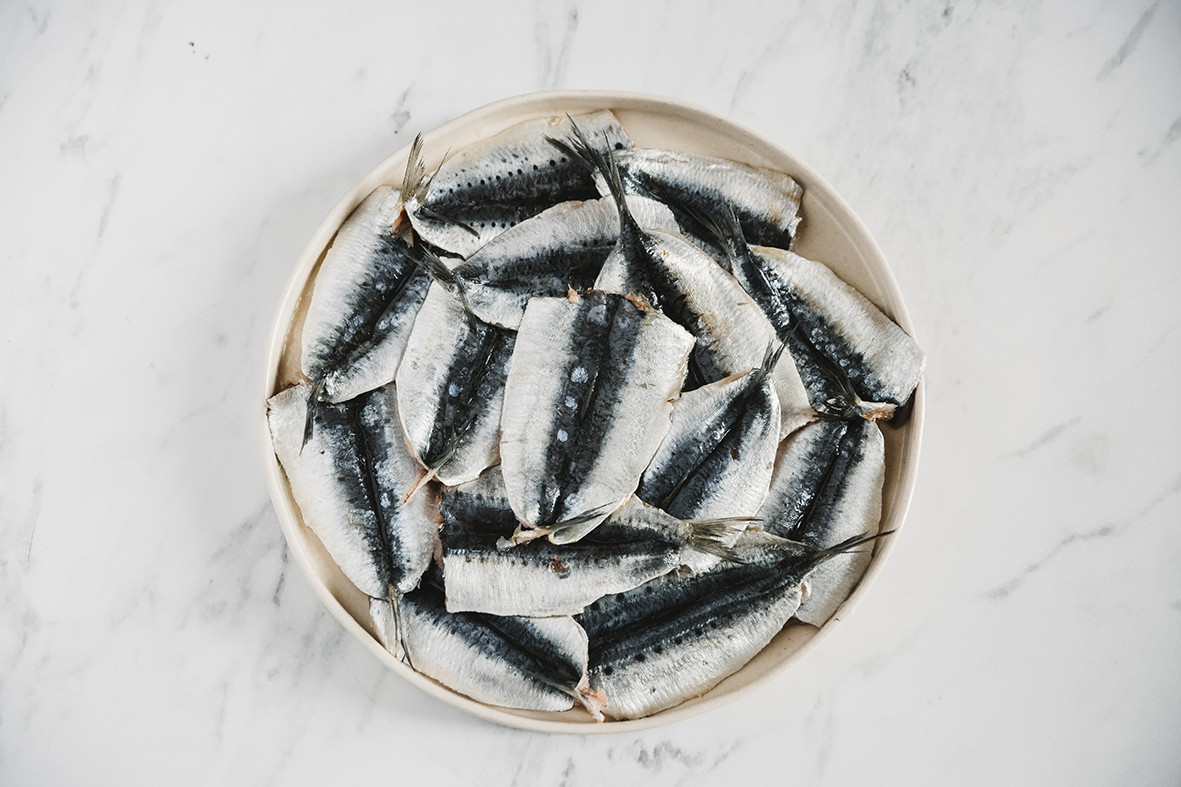
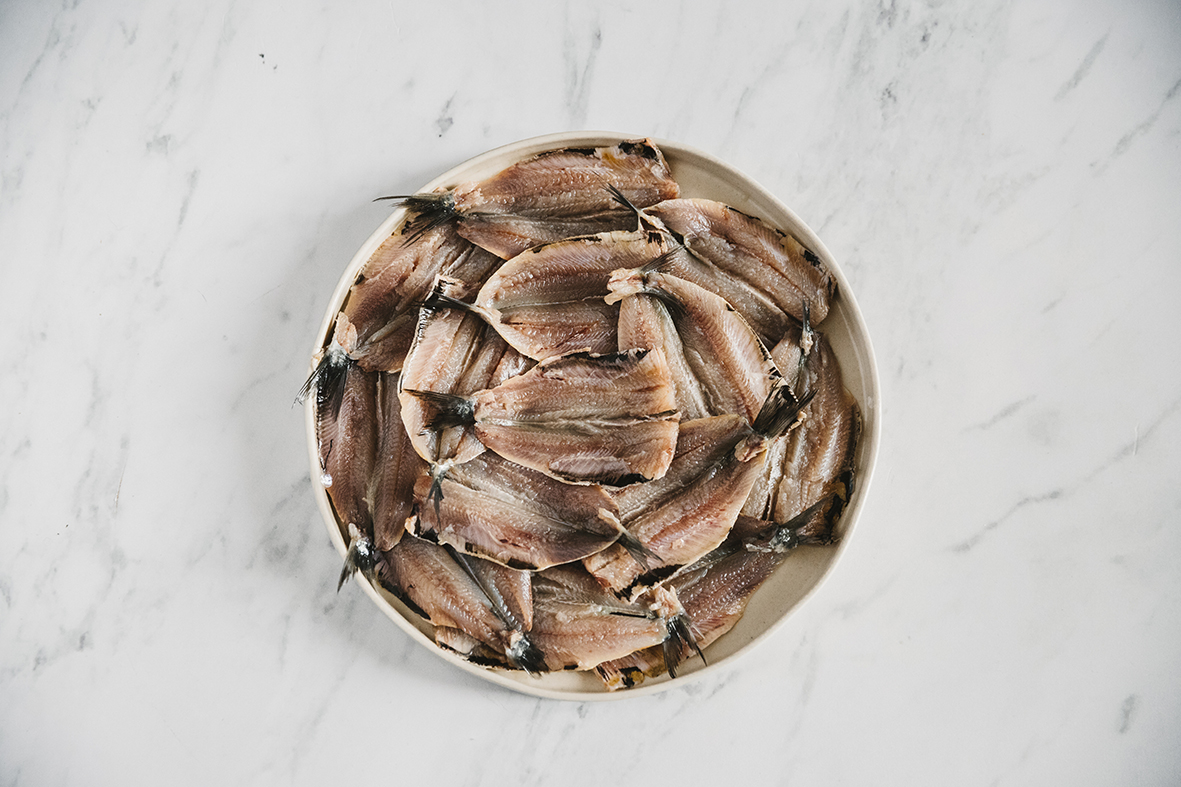
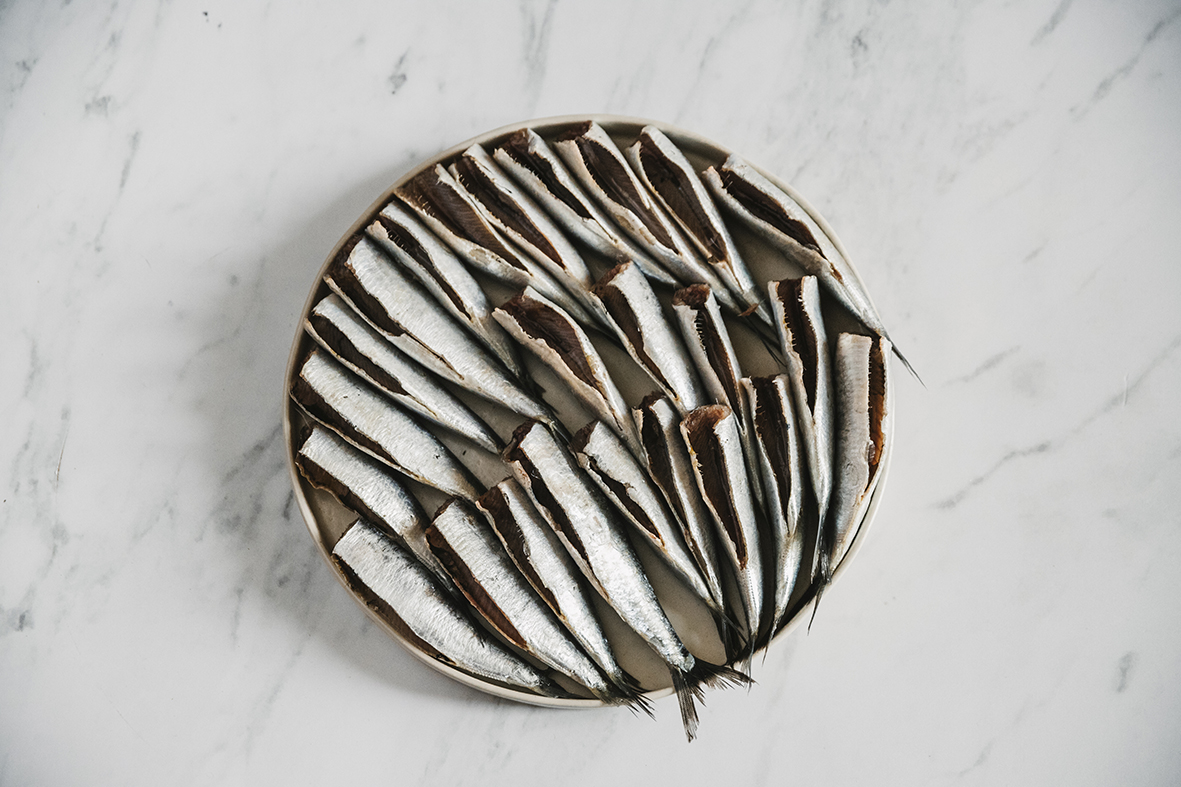
Now you have to wait for time to have its effect
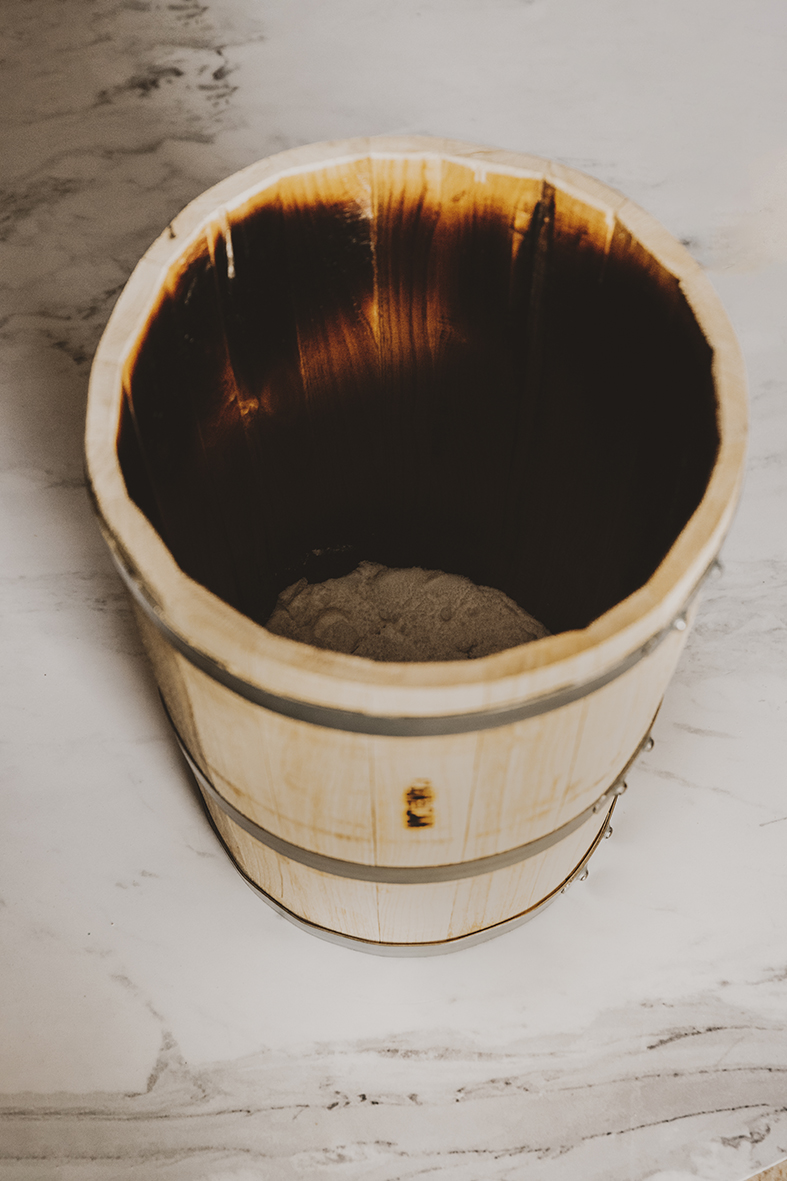
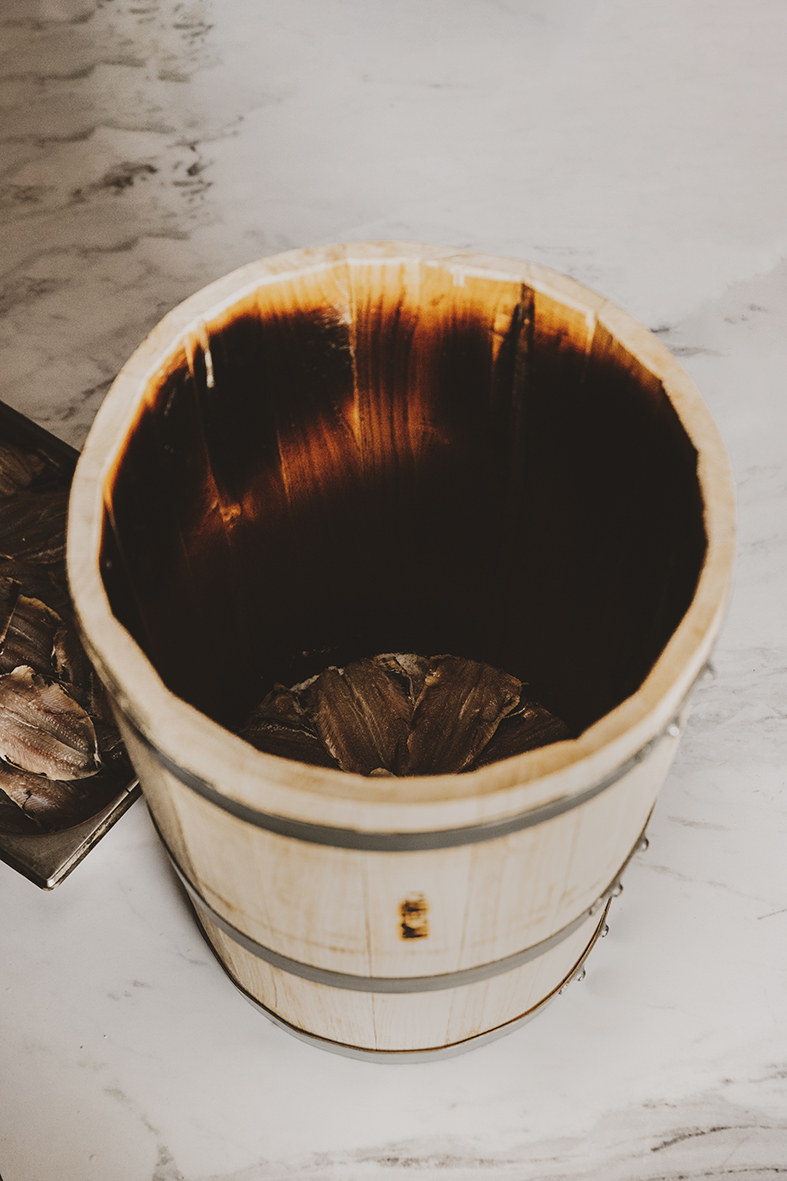
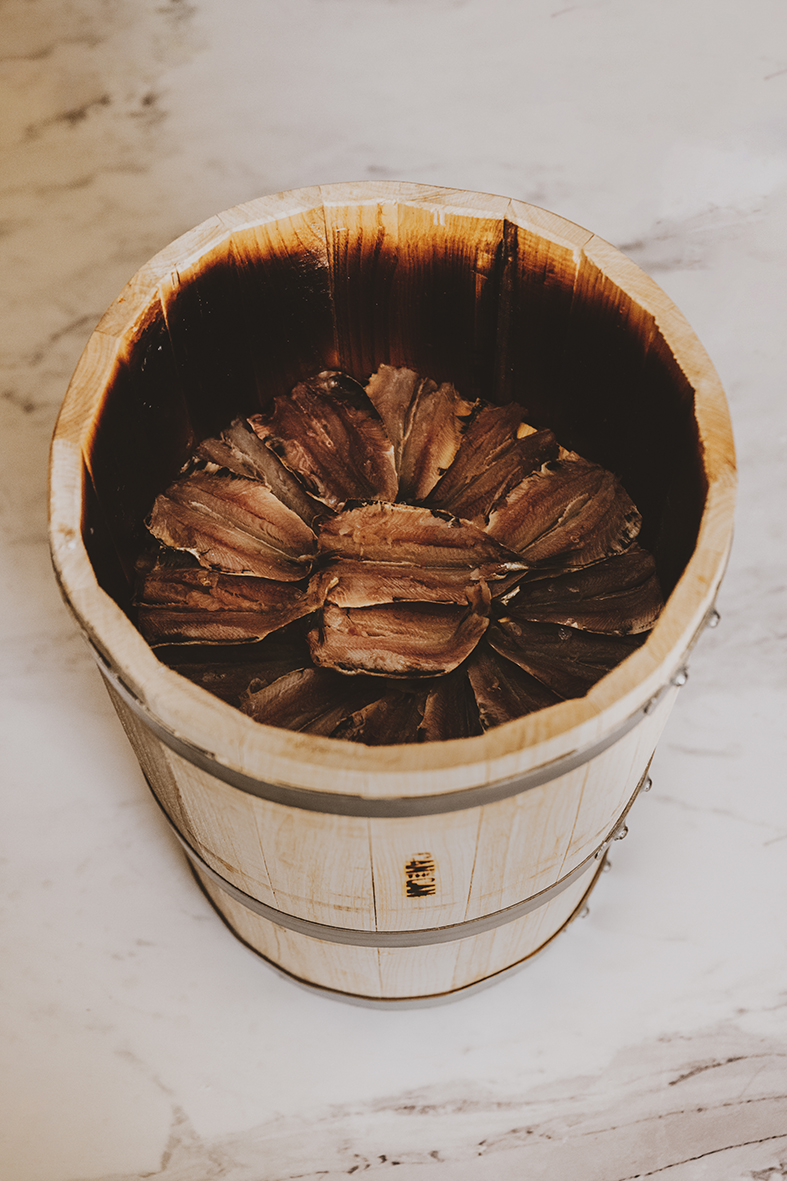
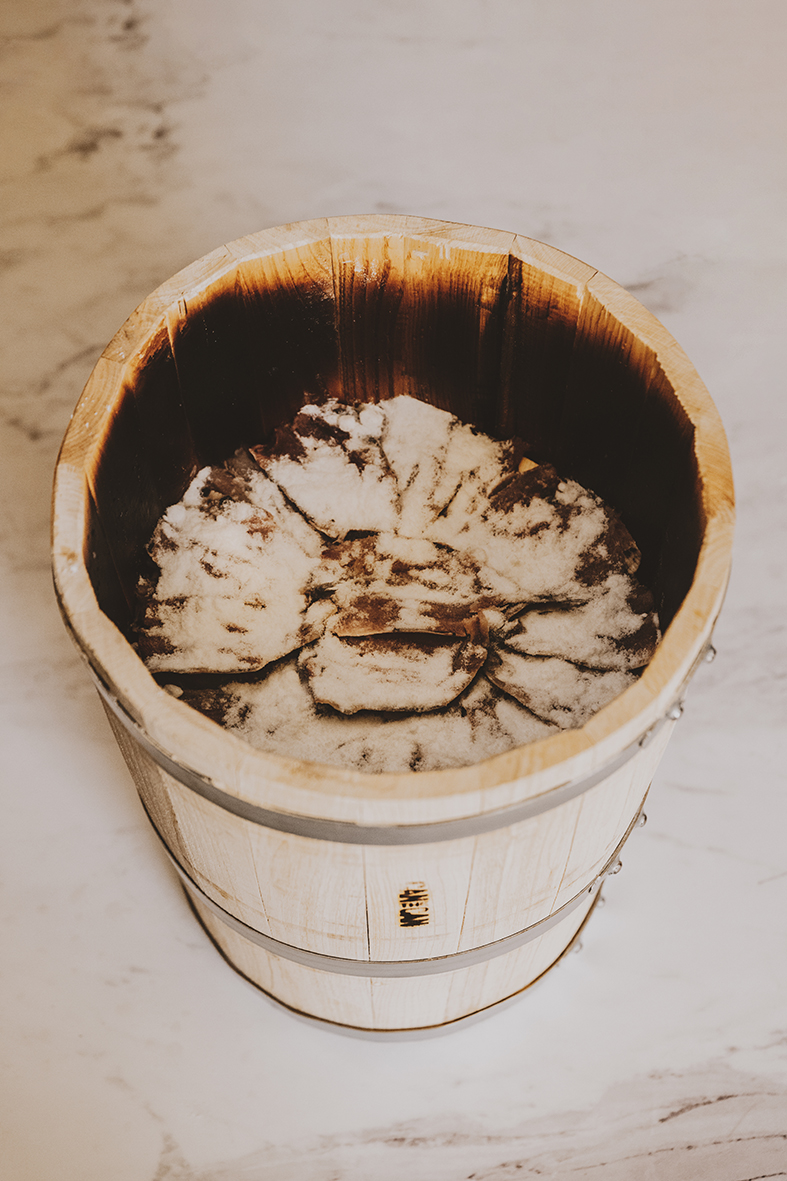
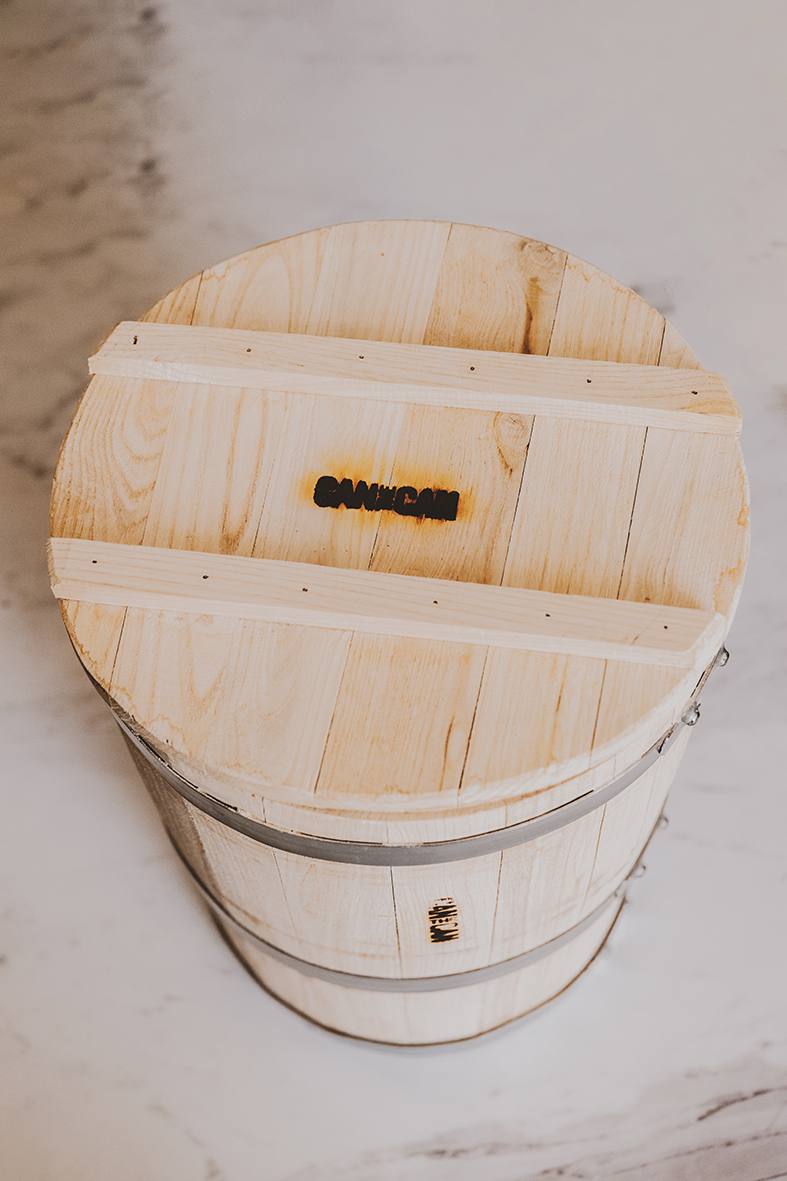
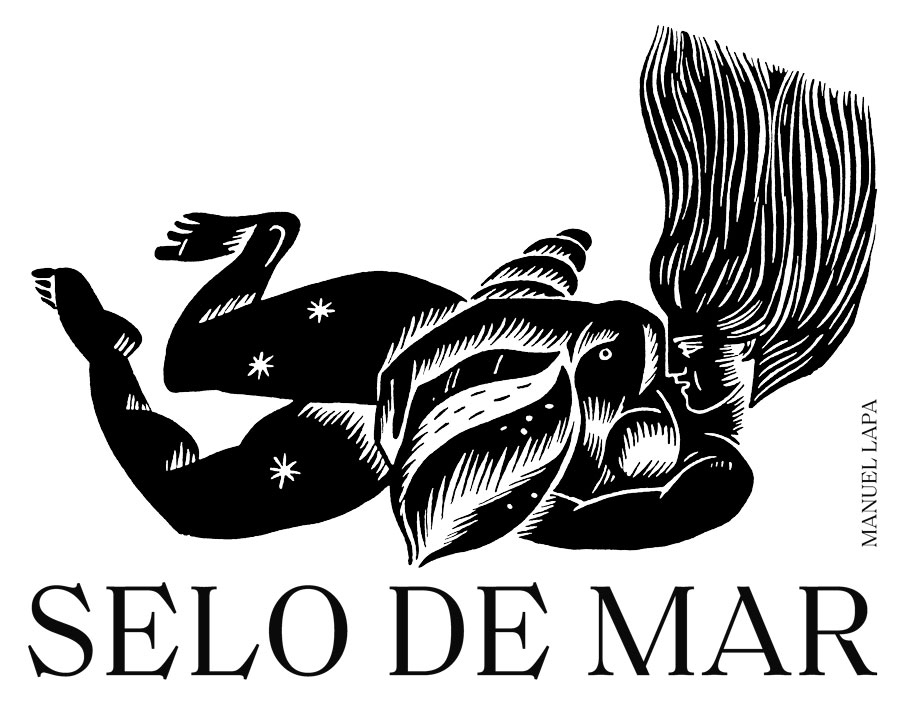
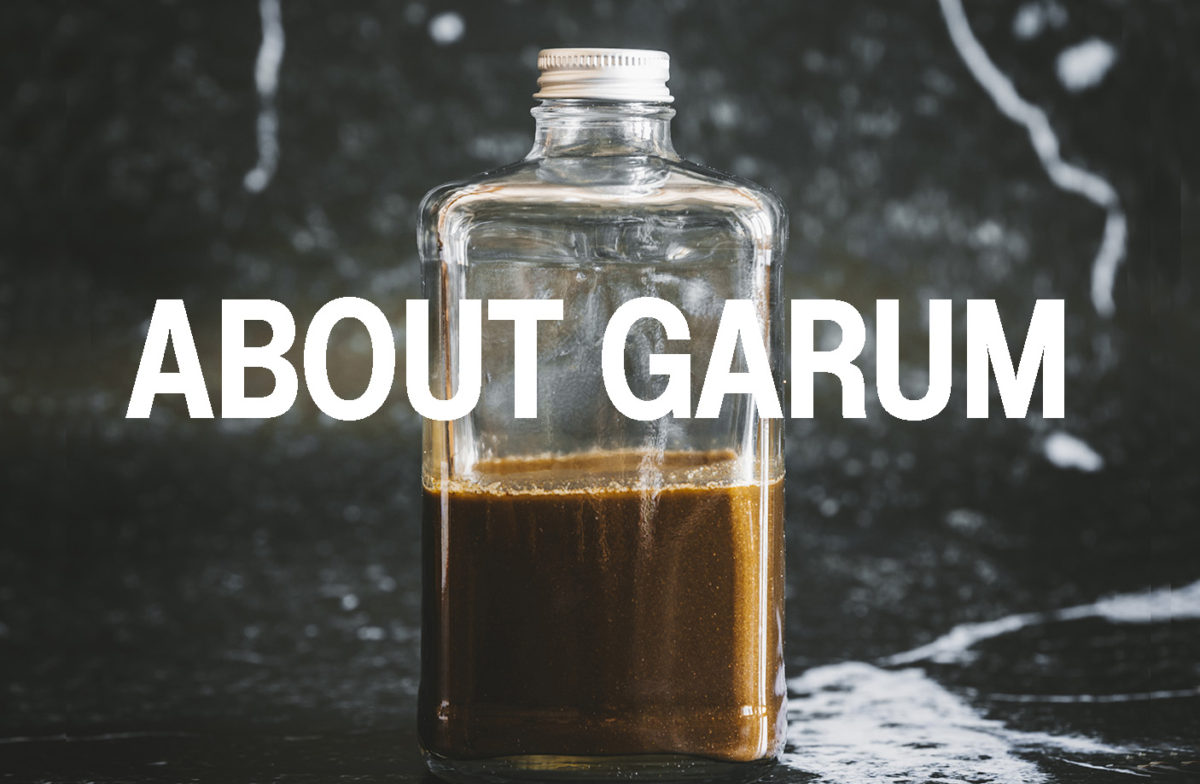
Garum was arguably the Roman’s favorite condiment. Made from rotted, fermented fish guts, it was a type of fish sauce produced across the empire. Ancient sources describe the different types of garum and how it was made.
The generic name GARUM is normally used to define a series of products of different composition and consistency, such as sauces and pastes obtained through fermentation in brine, through enzymes, part of fish or all of them.
The picture of fish sauce that emerges from the ancient literature is complex. The ancient writers who discuss these products do so without the precision we need and often contradict each other sothat a precise understanding of which sauce corresponds to which recipe, production process or name is less than clear in Sally Grainger
The highly proteic garum enhanced the flavor and was very appreciated in classic times. It could be obtained from different types of fish - anchovies, mackerel, tuna, morays and others - which determined quality and price.
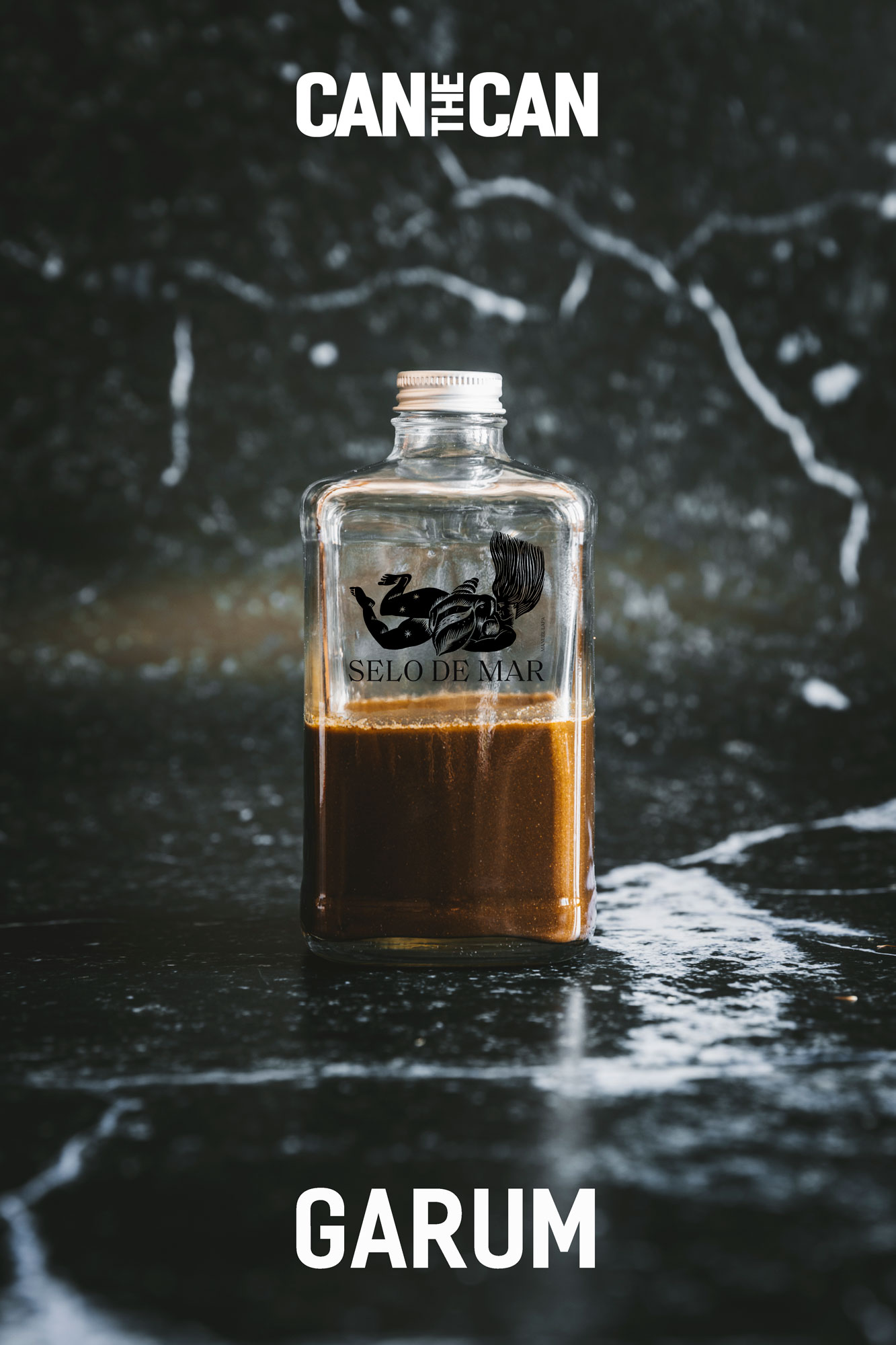
We tried to summarize in general terms the most common designations and what they correspond to, based on the works that can be accessed through the attached links.
In Search of Garum. The “Colatura d’alici” from the Amalfitan Coast
(Campania, Italy): an Heir of the Ancient Mediterranean Fermented Fish
Sauces. Alfredo Carannante, Claudio Giardino, Umberto Savarese
Originally realized with a not well identified ichthyic species whose Greek name was garos (from which came the name of the sauce, garon, in Greek), the Roman garum was produced from different species of fish: Isidore states “ex infinito genere pisciorum”. However, many other species, among which morays, eels and grey mullets, were used to produce garum, sometimes realized through the fermentation of different species together.
The best garum nigrum was produced from mackerel (Scomber scombrus Linnaeus 1758)
In the 1st century A.D. the garum sociorum, produced in Spain from the maceration of mackerel, was considered the best garum. Its cost was comparable only to that of the best perfumes (with a thousand sesterces you got two congi, equivalent to about six liters). Marcus Valerius Martialis (1st centuryA.D.) praises the luxury of the garum produced from the first blood spurted from mackerel just slaughtered, considered a particularly luxurious and appreciated present.
The muria was produced from tuna (Thunnus thynnus Linnaeus 1758), but also anchovies (Engraulis encrasicolus Linnaeus 1758) were at the basis of a valuable kind of garum.
Other times the garum was produced only with fish entrails, such as those of the tuna, mixing some entrails with blood and the fat abdominal fascia, the so-called “buzzonaglia". The origin of this product might be traced back in the recycling of fish rejects such as entrails, blood and fat parts, and whole smaller fish which were more difficult to keep.
The quality of the garum derived not only from the species and the parts used, but also from the filtering process. At the end of the maceration, in fact, the garum was filtered through baskets and different qualities were obtained: the limpid flos gari (“flower” of garum) obtained from the first filtered liquid and the liquamen gari, less valuable liquid part, with solid elements, obtained from the filtering of the roughest deposits.
The general product made from preserving fish with salt. Later becomes interchangeable in word use with liquamen. Earlier sources indicate that this particular classification was made from blood and innards of larger fish, such as tuna and mackerel.
In Apicius, liquamen is the universal term for the primary fish sauce and even when we find garum, with two exceptions, it is part of a compoundterm directly transliterated from the Greek : όıνογαρον (oenogaron = oenogarum) and therefore referring to the original whole fish sauce.
Besides those two qualities ( Flos Gari e Linqumen) another one must be added: the “flos flos gari”, “the cream”, whose origin and the species used, usually mackerel or tuna, were always specified.
The paste collected in the filters, often containing fish bones, was called allec (with the variations of hallec, hallex o allex), word which originally meant “putrefaction” or “dregs”, and represented the worst product often given to the slaves as companage. The allec, however, could also derive from the production of the best qualities of garum; in this case, the product resulting from the filtering after the maceration of the entrails, blood, or chosen pieces of mackerel or tuna, was considered valuable and was served seasoned with salt and pepper, wine and carrots, to stimulate the appetite before meals.
Moreover, there were luxurious variations of allec, produced from oysters, eggs of sea-urchin, sea anemones and mullet livers.
The best garum was obtained without adding other ingredients, but there were several varieties obtained adding vinegar (oxygarum), oil (oleogarum), wine (oenogarum), water (hydrogarum), honey (melligarum / mellogarum)
Apicius, in his famous treatise about cuisine, gives a recipe of oenogarum to dress tubers, composed by spices, liquamen, honey and little oil, and another recipe of oxygarum used as a digestive sauce, composed by a mixture of spices kneaded with honey and diluted with liquamen and vinegar.
adding vinegar
adding oil
adding wine
adding water
adding honey
Today in the village of Cetara, on the Amalfitan Coast, a fish sauce which presents strong resemblances with the ancient garum is produced: the “colatura d’alici” whose name means “filtering of anchovies”. The “colatura” is an amber-coloured liquid obtained from the process of maceration of the anchovies under salt.
In the first centuries of our era the production and the commerce of garum were important elements for the economy; after the Roman Empire fall the economical scenery in the Mediterranean changed. Nevertheless, the production on small scale of pickle fish continued with different destinies as it can be seen in all the cultural realities heirs of the Romans.
In Byzantium, in the 10th century, the Geoponica, an important collection of books about agriculture promoted by Constantine VII Porphyrogennetos (913-959 A.D.), were drawn up. In this work a recipe is given for the production of garum, significantly “in pot”: “Put in a container entrails of fish and small fish with salt and leave them in the sun mixing frequently. When the pickle has been obtained filter everything in a basket, where the solid part, the allec, remains. Those who want to use this garum soon without leaving it in the sun, can boil it filtering carefully the pickle two or three times, until the filter is clean. The best granum is called “haimation” and it is made with tuna entrails, gills, serum and blood. They are left to ferment in the salt for about two months, in a pot. Then the pot is holed and the garum is stilled.”
In the medieval Islamic cuisine although a lot recipes byApicius and a lot of cuisine from the Roman times were used, the garum was substituted by a new product widely mentioned by Iraqi gastronomes since the beginning of 9th century: the murri. The murri was very different from the garum: it was a powder of fish dried in the sun and salted, diluted in sweet wine with oregano and put in ferment in an oiled amphora with quince apples and pieces of onions. It also existed a kind of murri produced from toasted cereals, with a simpler and faster processing.
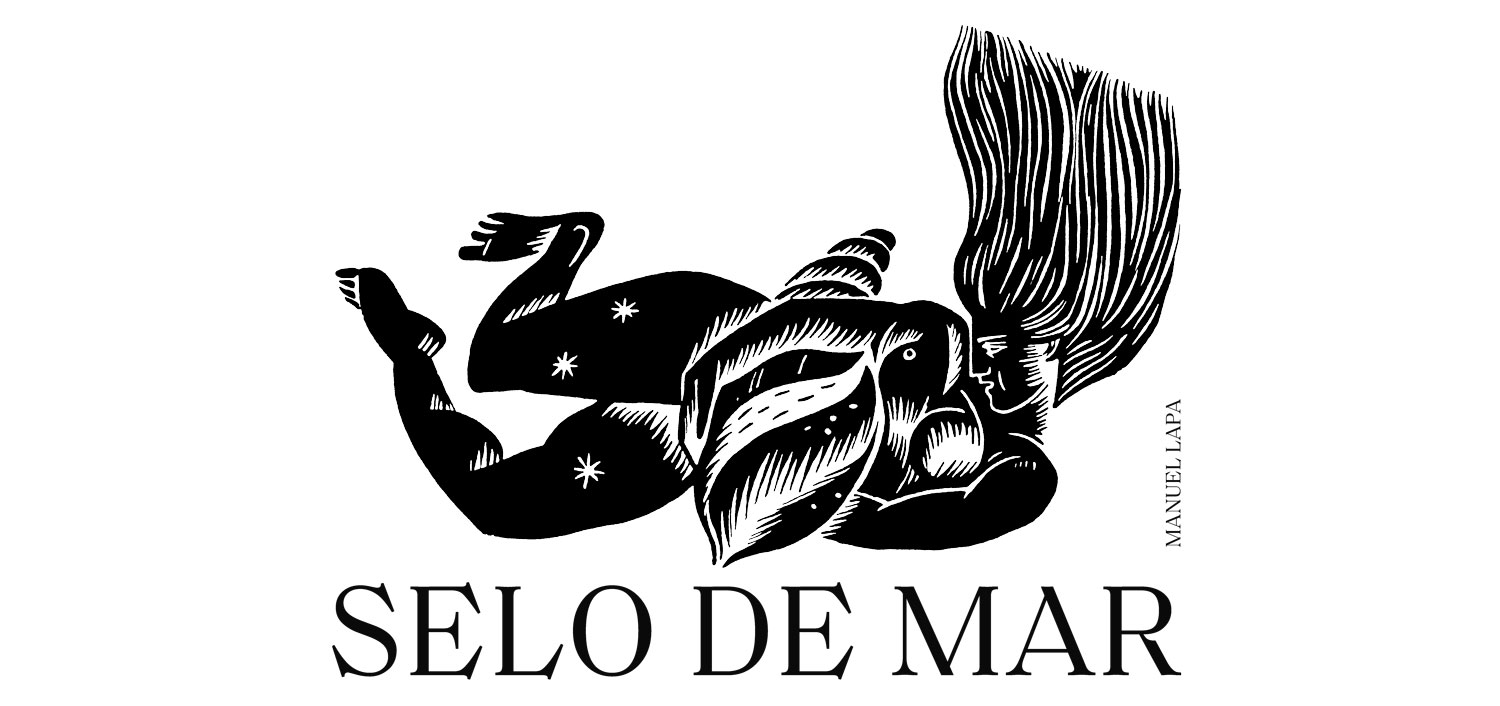
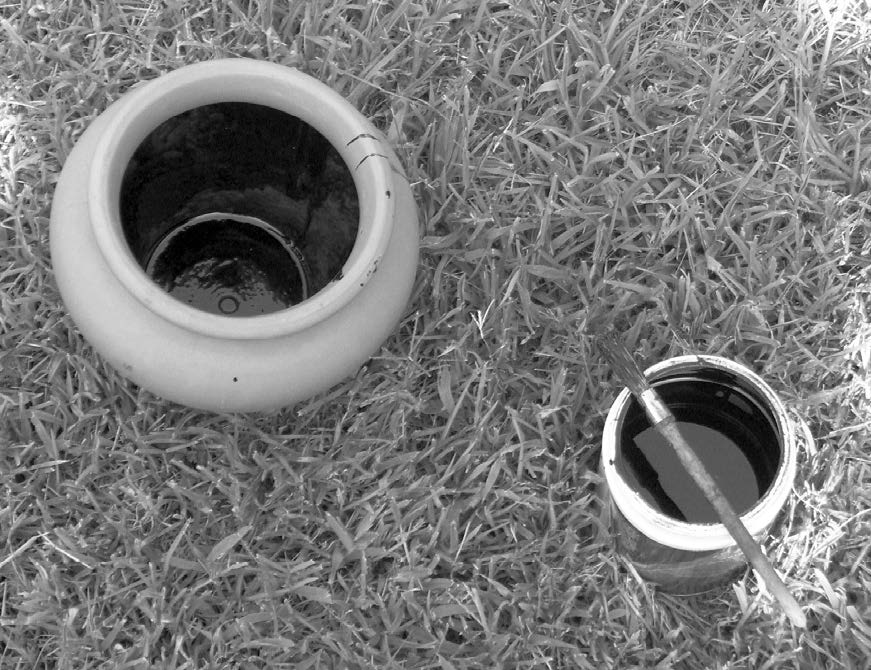
De gustibus non disputandum – Cicero
In this article, after a brief description of garum and its history, a preliminary experiment based on Martialis’ recipe provides a taste of past.
When Rome came into contact with the Greek world, a great amount of information, culture, technology and grandeur entered the then rural roman way of living.
It is in fact from the second half of the III century BC that Greek influence in many aspects of life was acknowledged by the ancient authors.
Among these, we find influences on cuisine and cooking. Garon, as it was known among the Greeks, was a culinary preparation made mainly of fish, salt and herbs and was in use in Greek cuisine from at least the 5th century BC (Pliny, NH XXXI, 93). The production and trading of garum lasted for at least one millennium: its taste could be called a golden thread of the Ancient World.
But what was it like? And, more importantly, what was it that made it taste like itself? It is to answer these questions that this project came to life. In this article we will illustrate the first steps taken for searching the answers. The analysis needs to be carried on deeper and wider, many written sources have to be read (and found!), many archaeological finds are there to be researched: we are perfectly aware of the fact that this is just a beginner’s log.
A brief history of garum production, fortune and trade will be given in the first part. In the second part methodology and specific information from written sources will be discussed and in the third the preliminary experiment will be illustrated.
In the conclusions problems, variables and further experiments will be analysed.
In his Liber de Agricultura Cato (between the 3rd and 2nd century BC) refers to allec, which seemed to have been a paste obtained by the working of fish, herbs and salt.
The etymology of such a term appears to find its roots in the word putrescence (Dosi, Schnell 1984: 181). Interestingly, he refers to it when describing food needed by the family who run a rural farm once the olives run out (Cato, LVIII).
Because of the amount of nutritive substances (such as amino acids, nitrogen, and many different trace elements), garum and allec were quite important in the mainly vegetarian diet of ancient Rome (Hubert 2001).
Garum was a liquid or semi liquid sauce obtained by the decomposition of fish and herbs in salt. According to Pliny, it was at first obtained from one selected kind of fish which might be compared to anchovies. Common garum, on the contrary, was created by the decomposition of fish entrails in salt. Its exotic taste entered firmly into the roman world in the time of Apicius and was considered a fundamental ingredient to many recipes. The liquid garum (another term used to indicate it is liquamen) was so popular that it was also added to fruit jams (Dosi, Schnell 1984: 210).
Many archaeological remains witness the importance of the product.
The Atlantic coast of Spain and Morocco, as well as the Mediterranean coasts and the Black Sea were sites of production of garum. The centres of industry in the transformation of fish, in which tuna and other fish was cleaned and salted, were also the sites in which salt was extracted (see Purpura 1982). These industries consisted of a series of cocciopesto (lime mortar with crushed pottery) covered vats (called cetaria) in which the fish was worked and, probably, entrails, salt and herbs were left in the sun for transformation into garum. Usually, amphorae sherds found nearby the vats help to give an idea of the duration of the production. The most famous garum was made only with mackerel and was produced in Spain (Pliny NH XXXI, 94) and sold all over the empire in Dressel 7-9 amphorae (Purpura 1982). The north African coast was rich in this sort of industry which produced a typical amphora to contain the sauce. The African amphorae sherds for garum trade can be found across the empire from Severian times and a sign of change in the market trends of that time (Purpura 1982).
Thiis mode of production is not so common on the Tyrrhenian coast of Italy. Scholars believe the reason for this can be found in the garum officina (garum’s factory) found in Pompeii. Even though Pliny acknowledges Pompeii as a famous site for the production of garum (NH XXXI, 95), the witnessed procedure differs slightly from the others. Here the mixed ingredients were left to ferment in dolia, not in vats, but were sold in amphorae as the other garum (Salza Prina Ricotti 1999).
An interesting note of the edictum de pretiis by Diocletian (301 AD) states two different prices for the first liquamen and the second liquamen (III, 7), probably reflecting a difference in quality.
The production of garum was carried on until the 5th century AD in Morocco, and the consuming of garum is witnessed into the early medieval times and later (8th century AD, Salza Prina Ricotti 1999, Purpura 1982 footnote 10; Encyclopaedia Romana under “Garum” states that there is trace of production of garum as late as 1345 AD).
It seems therefore that production of garum was strictly linked with the industry of fish transformation: it actually used the same facilities. But this is not the only production witnessed as another method used dolia to obtain the same product.
Th e curiosity about the taste of such a famous and renown ingredient lead us to approach garum from the experimental perspective. The first aim of our experiment was to be able to evaluate variables which may affect garum’s taste. To attempt a reconstruction of a “taste” might be considered as rather an impossible mission. Experimental archaeology has already demonstrated in the past decades how an “accurate” reconstruction is not only impossible to obtain, but also does not necessarily improve our knowledge of the past. We can imagine, therefore, how subtle the results could be when the object of the experiment is not an object but a taste, which certainly lacks both materiality and assessment measurements which can aid the evaluation. This theme has entered many times into the discussion of those who participated in the experiment, and lead sometimes to a great discouragement for the task. Even so, after having eviscerated the problem in many ways, we decided that experimental methodology could be a great help in such an attempt. The preliminary experiment on garum production was therefore planned to assess the variables and their consequent relationship. An organoleptic evaluation of the final product was programmed to have a standardised description of the taste, useful to provide a comparison for further experiments.
As the starting point should be the archaeological record but we did not find any convincing sources and studies made on the subject.
In popular books the stereotypes of garum being a putrescent and morbid thing were not sustained by experiment on actually making or tasting it according to the ancient procedure (Dosi, Schnell 1984: 28, 246). On the contrary, in the same source, the experimental approach in the creation of garum was gladly encouraged, as the importance of that ingredient was evident both by written and material sources (ibidem: 254). The information about taste was limited to a link to nuoc-mâm, an oriental preparation still in use. The origin of it were referred to as an error made in the conservation of fish, ending in some sort of not-toobad waste (ibidem: 210).
Even the ancient world seems to be split into those who liked garum and those who did not. Martial refers to garum made only with the blood of freshly killed mackerel as a sumptuous gift (Xen. XIII, 102), but points out also that common garum had a terrible smell. Apicius, on the other hand, gives a recipe to change the smell of garum with the aid of herbs and honey (Apicius De Re Coquinaria, I, 6). The first liquid was called gari flos (flower of garum). The most appreciated was called garum nigrum and was sold in small jars. The banqueters could use it as they pleased directly on the table (Dosi, Schnell 1984: 212).
As we said, allec was the remaining paste after all the liquid has been extracted, but some scholars say that originally allec was garum at the midfermentation point. In recipes allec was used as an appetiser.
At some point, it seems to become an independent preparation, as we can also read about allec made only with one type of fish or molluscs.
Let us move to consider present day information about fish sauces of that kind. As we said, nuoc mân from Vietnam and naam-pla from Thailand are the closest existing sauces to ancient garum.
To make it, fish and salt layers are alternatively put into an earthenware big jar with a percentage of 20% salt on the total. The jars are then closed with a mat and left to ferment from one to three months.
The first extracted sauce is the best quality. Then subsequently adding brine and filtering produce second and third quality choice sauce. The obtained liquid is put into glass bottles and exposed to sunlight to acquire a clear caramel colour. As it is today, different hues were associated with different qualities of sauce (see above, garum nigrum).
The process of transformation from solid to liquid, is not, as it was thought commonly, decomposition or fermentation. If the percentage of salt is kept 20% or higher, the process of fermenting stops at a certain point and gives way to what is known as autolysis, an actual maturation of the compound (Hubert 2001, Purpura 1982, footnote 7). The presence of viscera probably aids the process because of the presence of active enzymes (Rovere et al. 2008, “garum”). The knowledge of this biochemical process lead modern garum-makers to obtain good results with a yogurt-maker in which heat can be kept controlled (Wunderlich’s webpage).
An Italian product, called “Colatura di Alici”, is quite similar to the ancient garum made with anchovies collected in spring and summer, it is created by the fish being put under pressure with salt. The raw fish is cleaned of entrails and put in salt for at least 24 hours. It is then transferred to wooden barrels between layers of salt. The closing cap is then charged with extra weight and the resulting liquid collected in glass bottles and left for four or more months exposed to sunshine to gain concentration. After this, the liquid is then put again in wooden barrels with anchovies and then collected from a little opening.
It is then ready in December. Its use is traditional for Christmas’ eve on non-salted pasta (Colatura di Alici webpage).
Written sources that illustrate the “recipe” for making garum are very few and very late. No one states the quantities, and the most accurate are those of the Geoponica collection, dating to medieval times (Curtis R. I. 1991: 194). We decided therefore to start from a late source that seemed to be sufficiently clear to elaborate a proportion of the ingredients. This source comes from a collection of works made in medieval times and its supposed author is Gargilius Martialis as quoted from Dosi Schnell 1982 and Gozzini Giacosa 1992. Gargilius Martialis, a writer from the third century AD, in “De medicina et de virtute herbarum” writes:
“Use fatty fish, for example sardines, and a well-sealed (pitched) container with a 26-35 quart/litre capacity. Add dried aromatic herbs possessing a strong flavour, such as dill, coriander, fennel, celery, mint, oregano, and others making a layer on the bottom of the container; then put down a layer of fish (if small leave them whole, if large use pieces); and over this add a layer of salt two fingers high. Repeat these three layers until the container is filled. Let it rest for seven days in the sun. Then mix the sauce daily for twenty days. After that time it becomes a liquid (garum)” (Gozzini Giacosa 1992: 27).

Fig. 1 Brushing the vase with pine tar
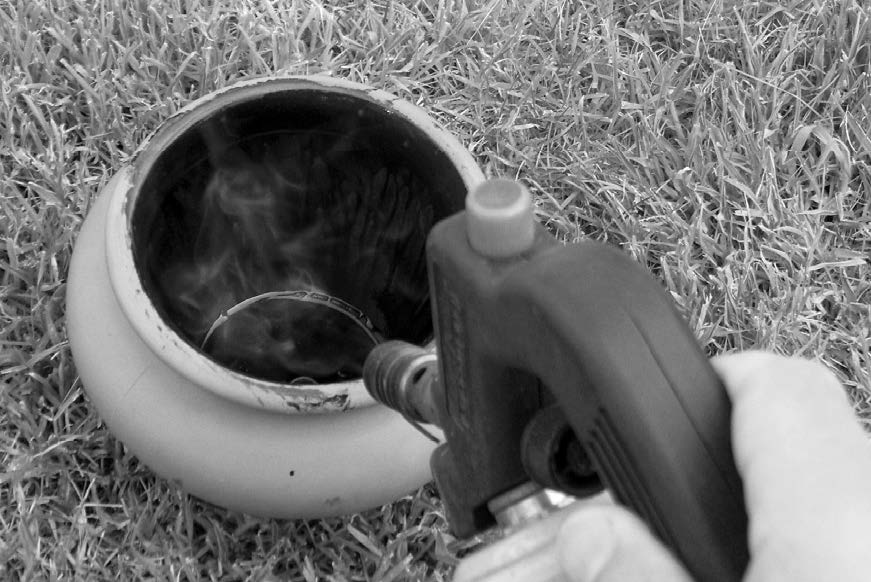
Fig. 2 Hardening the tar with a gas flame
Since our aim was to assess the variables included in the process, we decided to scale down the quantities and to adapt them from an industrial standard to a more family like method of making garum. The container used was an earthenware vase of 2,7 lt. capacity at the brim. The vase was tarred to prevent leaking (this method had been used since Cato’s times). Tar was considered an important part of the experiment, not only because of the impermeability needed for the procedure of fermentation, but also because it was thought that the resulting taste could be aff ected by the use of vegetable tar. The chosen one was natural pine tree tar, spread onto the inner surface of the vase with a brush (Fig. 1).
To harden the tar, a common flame device was used (Fig. 2).
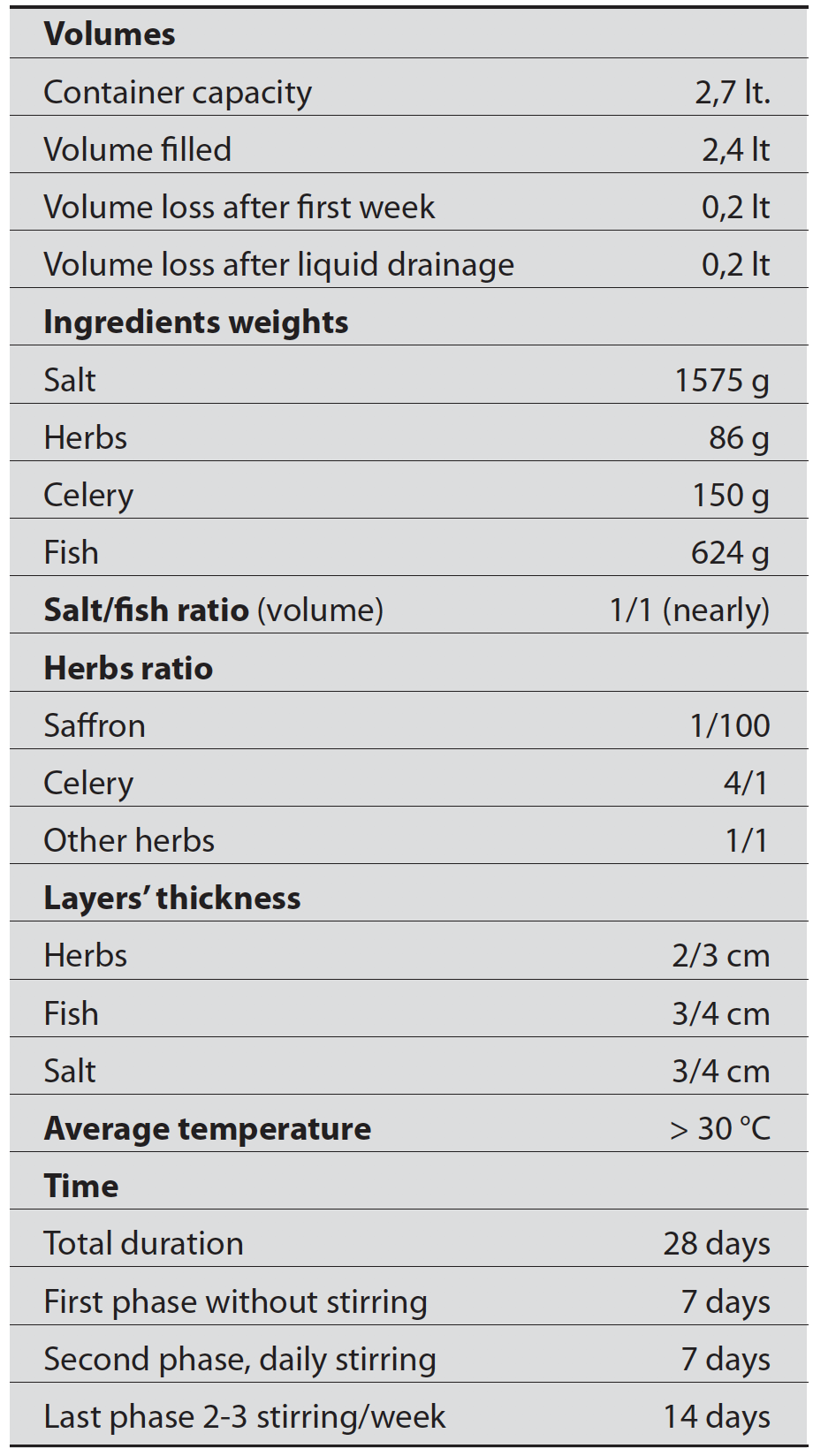
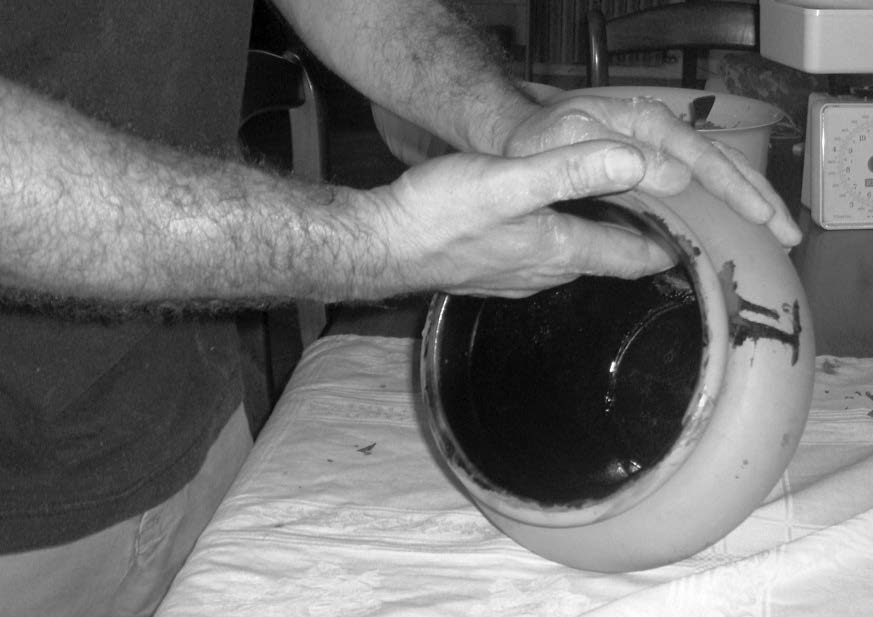
Fig. 3 A subtle olive oil layer to ensure impermeability
Subsequently, for ultra-safety of impermeability, it was isolated with a veil of olive oil (Fig. 3).
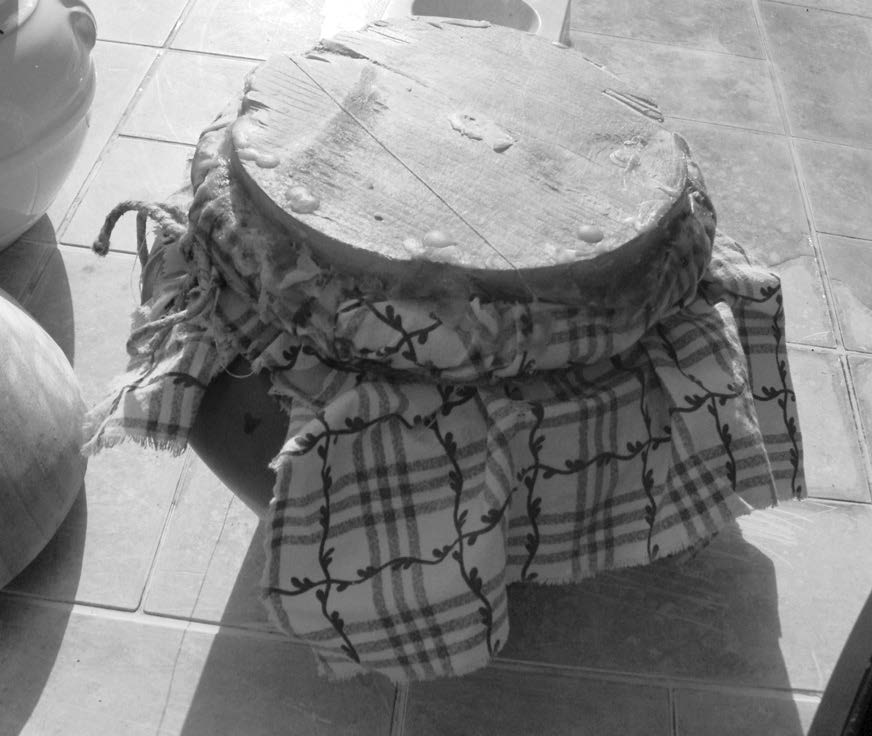
Fig. 4 Closing the vase
Subsequently, for ultra-safety of impermeability, it was isolated with a veil of olive oil (Fig. 3). During the experiment, it was clear that a soft er way of hardening the tar, possibly with embers, would have produced a more reliable result and avoided damage to the vase. To prevent insect contamination, a wooden cap wrapped with a cotton cloth was prepared to be put on the brim of the vase (Fig. 4).
Beeswax was considered to be the best material to be used to seal the cap. This system was very useful as it permitted an easy re-opening each time mixing was needed.
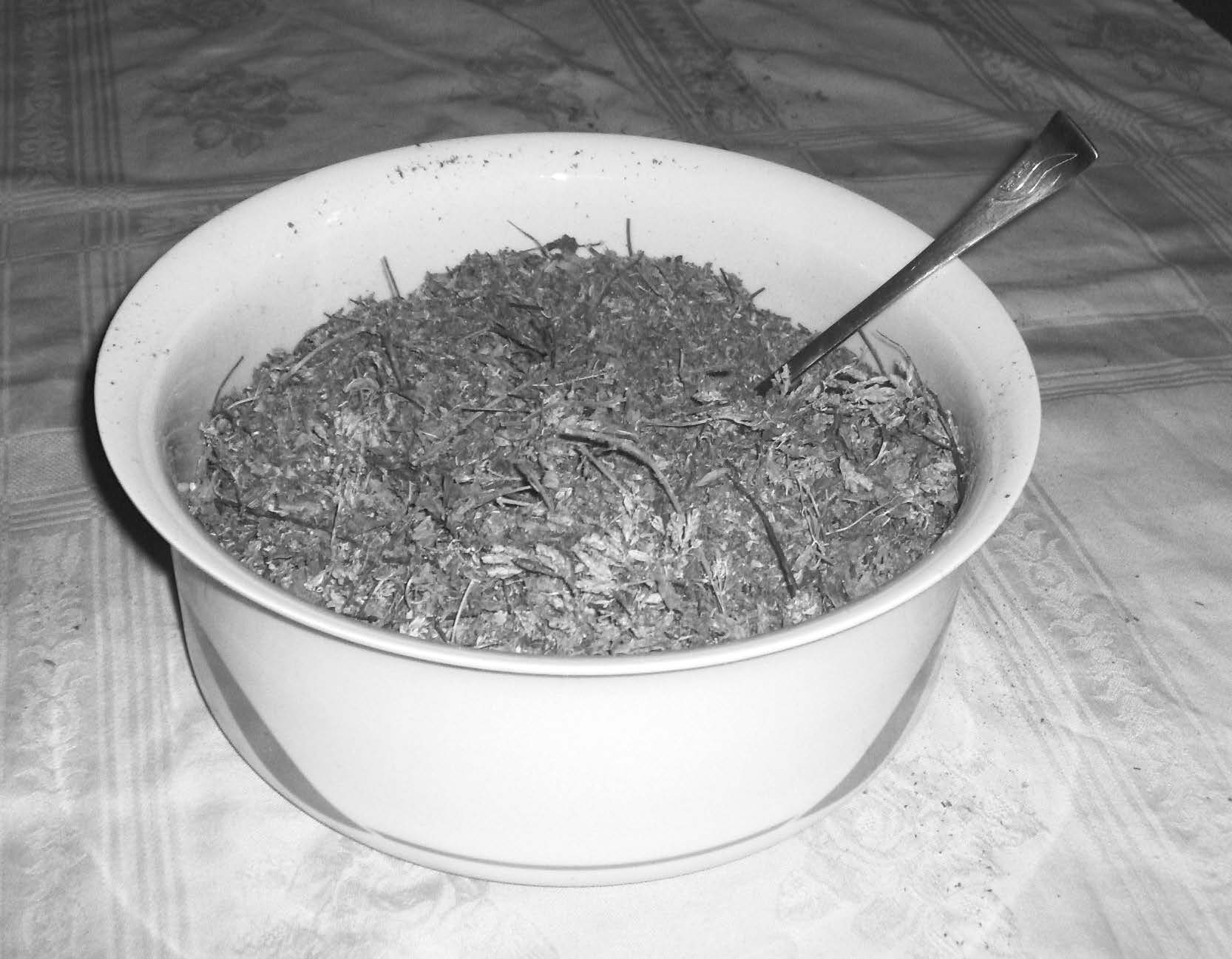
Fig. 5 Mixed dried herbs
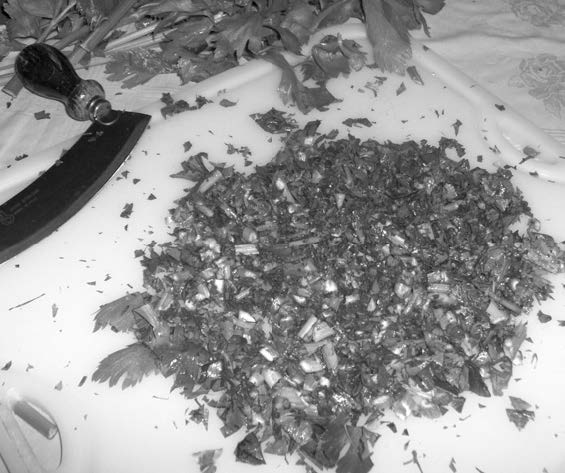
Fig. 6 Minced celery
After preparing the vase, a selection of herbs as described by Martialis was prepared.
We used:
dill (Anethum graveolens L., dried seeds),
coriander (Coriandrum sativum, dried seeds),
fennel (Foeniculum vulgare, dried seeds),
celery (Apium graveolens, leaf and stem),
mint (Mentha Longifolia, dried leaves),
pepper (Piper Nigrum, grains and dried leaves),
saffron (Crocus sativus, dried stigma)
and
oregano (Origanum vulgare, dried leaves).
We also used saffron as we found it quoted into an Italian translation of the recipe that also quoted this spice (Wikipedia). Since the proportion of the herbs were not described, we decided to use a mixture of the essences in equal parts, except for saffron, added as 1/100 against the other herbs. As saffron has always been an extremely expensive spice since ancient times, as the process of collecting it has actually remained the same over the millennia. Other spices may as well have been imported, but the collecting methods were surely different and affected the final presence in the recipe differently. Since celery was added fresh, the quantity was increased to 4/1 against other herbs, considering the amount of water in fresh vegetables. All the dried herbs were carefully mixed in a soup dish to obtain an even compound (Fig. 5).
Celery was added later with the other ingredients (Fig. 6).
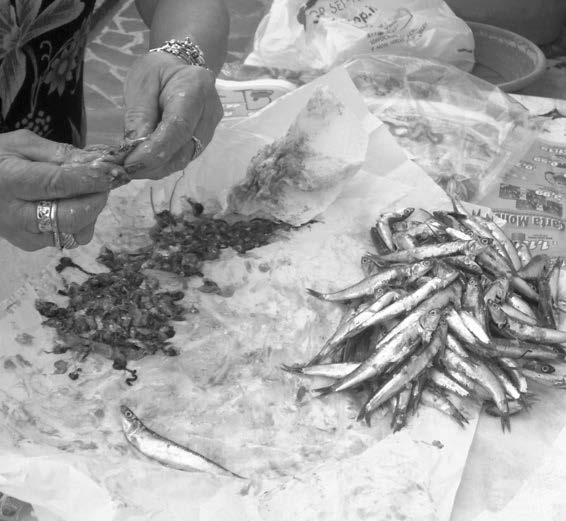
Fig. 7 Blue fish cleaning
Bluefish and mackerels were partially cleaned (Fig. 7-8) – intestines were only taken from the bluefish, whereas fishbone, intestines and gills were taken away from mackerels – and cut into small pieces (Fig. 9-10).
It was felt that, considering the small dimension of the vase, cutting the fish would aid the process.
Salt was carefully chosen to prevent contamination from industrial chemical substances. We used whole organic marine salt naturally gathered from Trapani (Sicily).
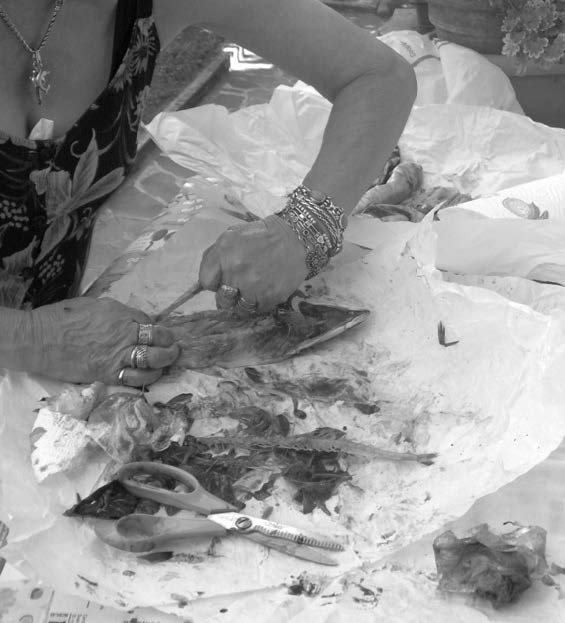
Fig. 8 Mackerels cleaning
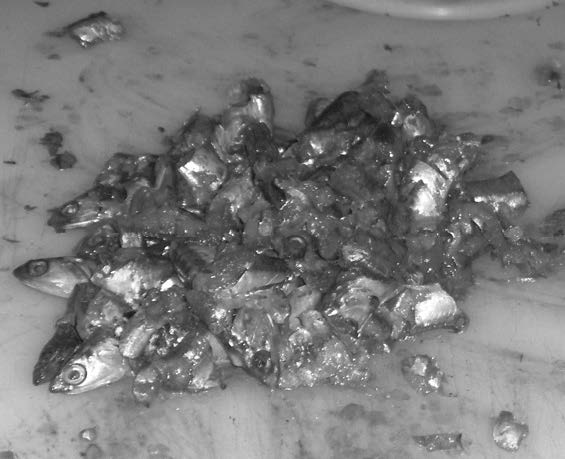
Fig. 9 Minced blue fish
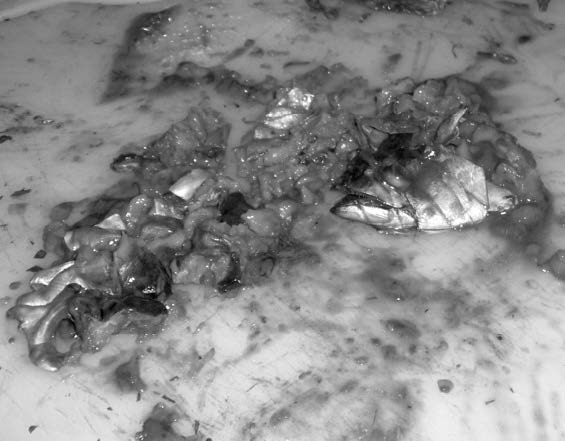
Fig. 10 Minced mackerels
The actual procedure of preparing garum, started with a bottom layer of herbs (Fig. 11) of 2/3 cm height being put in the vase complete with celery (Fig. 12).
Fish was then laidin a layer 3/4 cm high (Fig. 13).
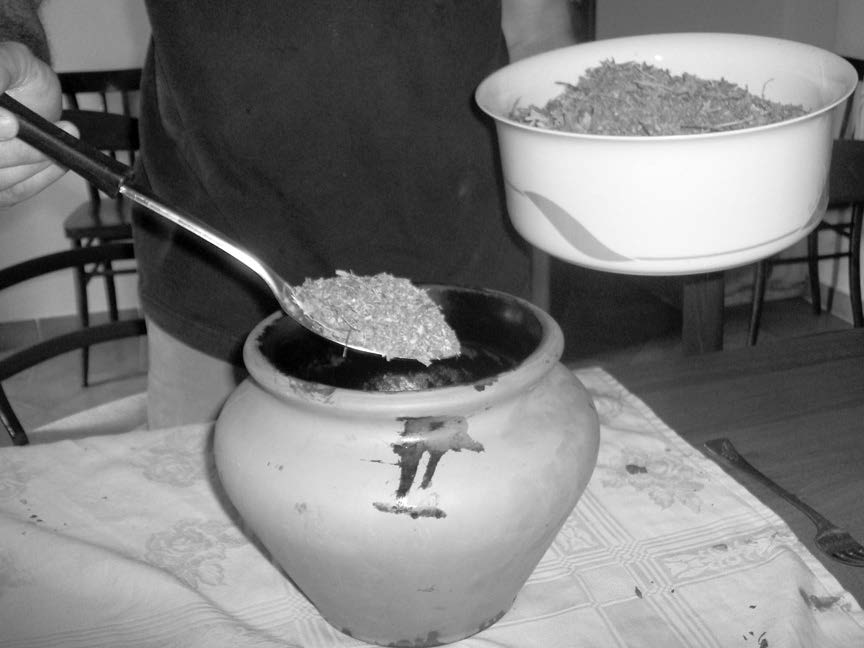
Fig. 11 The first layer of dried herbs
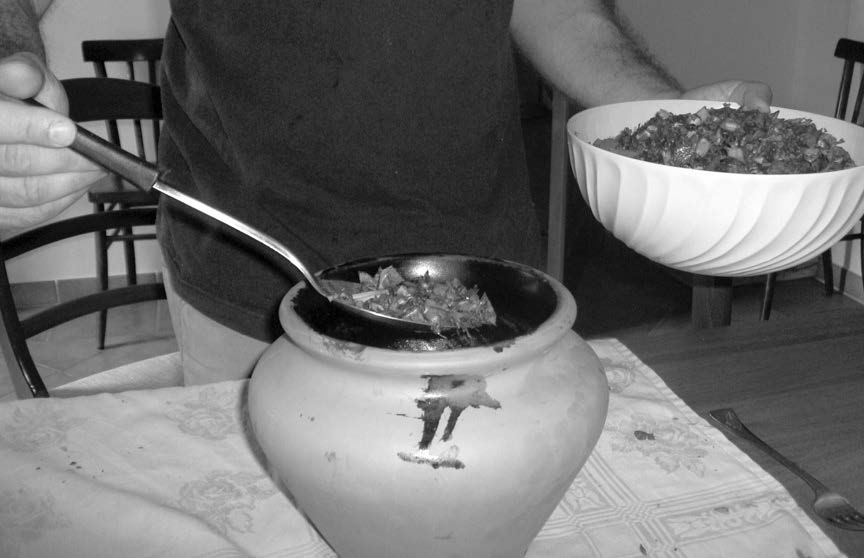
Fig. 12 The first layer of celery
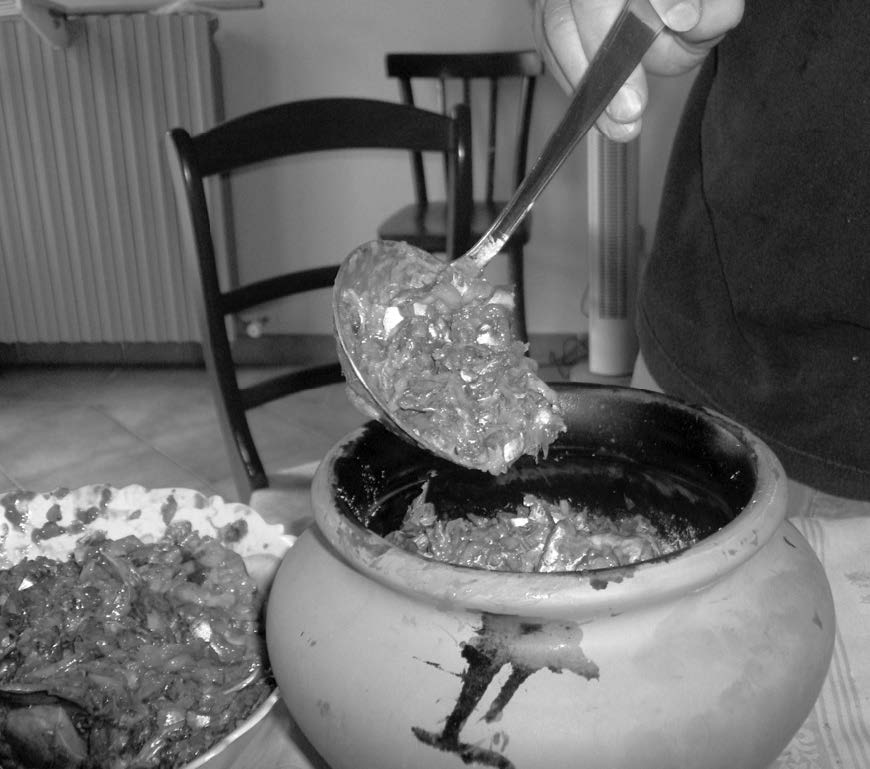
Fig. 13 The first layer of fish (one of three )
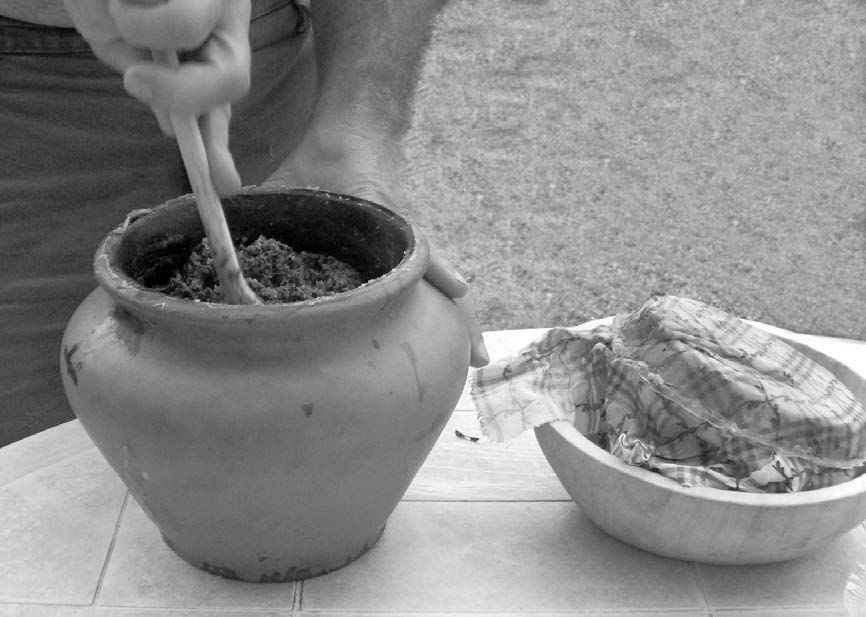
Fig. 14 Stirring with a wooden spoon
The next layer was salt, “two fingers in height” as Martialis says (3/4 cm).
The vase contained 9 layers in total and then was closed with the above described cap. The preparation ended at midday on the 15th August 2008. For the whole duration of the experiment (until 13th September) the vase was left in the sun from just after dawn to a little before sunset.
The temperature reached above 30 ºC. For only two days bad weather prevented the vase to be exposed.
After 7 days excluding the first, the vase was opened to begin stirring (Fig. 14)
On this occasion an intense perfume of fish and Mediterranean spices was released from the compound. The volume seemed to be diminished by 0,2 l and a liquid part was noted among the cloggy compound. For seven days the garum was stirred daily, whereas for the remaining two weeks it was stirred only 3 to 2 times per week.
On the third day of stirring, a yellowish liquid begun to leak from a fissure in the vase. This yellowish liquid had a very acrid smell and become crispy on drying. The fissure in the vase, probably caused by the hardening of the tar within using the flame, was sealed with natural beeswax. The liquid started then to turn into a more greenish colour, probably because of the herbs.
After 28 days, the compound was taken out of the vase and put into a fine linen cloth with medium large texture and compressed to extract the liquid. This method proved to be a failure as the amount liquid was very small and too dense to drip from the cloth. This made us think that a slow dripping method might be more effective as described in the Geoponica. The mixture was then suspended in a natural fibres basket from which to extract the liquamen.
A small amount of garum was indeed collected and tasted. The taste resembled that of anchovy paste with a strong accent on raw fish and a background of spices which made it quite pleasant. At the organoleptic examination the product obtained with the experiment turned out to have the following characteristics:
Consistency: granular with fragments of spices and salt to which the fish are amalgamated.
Colour: olive green.
Smell: the blue fi sh one is predominant, rounded off by spices. Smells are well amalgamated.
Taste: very intense salt and fatty fish, the initial impact vanishes fairly rapidly with the dissolution of salt, leaving a clean aftertaste.
(Examined by Cristiana Minelli, laboratory technician for food industry)
There are few conclusions that we can point to at this stage of research.
The preliminary experiment, in fact, lead us to evaluate many other possibilities in experimenting with garum making. The procedure we used was not successful as very little liquid sauce was obtained. Among the many explanations, lack of extra viscera (besides the utilized fish ones), an over abundance of salt and doubt on the scaled proportion used are to be explored deeper.
As said above, viscera from the fish could aid the autolysis process.
Salt could also be kept at a lower percentage of the total (being almost-at volume 1:1 in our procedure) or, more likely, added in form of brine as happens in Oriental fish sauces and as probably happened in the fish-salting industries in ancient times. Another point seems to be the overall quantity of ingredients, probably standardised at the times of the description for the success of the procedure.
This experiment lead us to distinguish the different variables present in the process, some of which came to light by accident during the experiment itself. For example, we felt that the failure of the process of extracting the liquid was due to the need for a different technique: probably the original recipe for the colatura di alici, using weight put on top of the anchovies, could have helped. Temperature was not a problem as the experiment had been planned for a season in which weather was hot and sunny. Probably air has to be considered carefully in the next experiments in relation to the autolysis.
There is another question regarding the relation between allec and garum, and garum to liquamen.
Sources of the time seem to distinguish between different consistencies.
The archaeological record could be analysed to assess whether there exists a distinction in the container morphology which could be linked to ceramic morphology, content and production procedure.
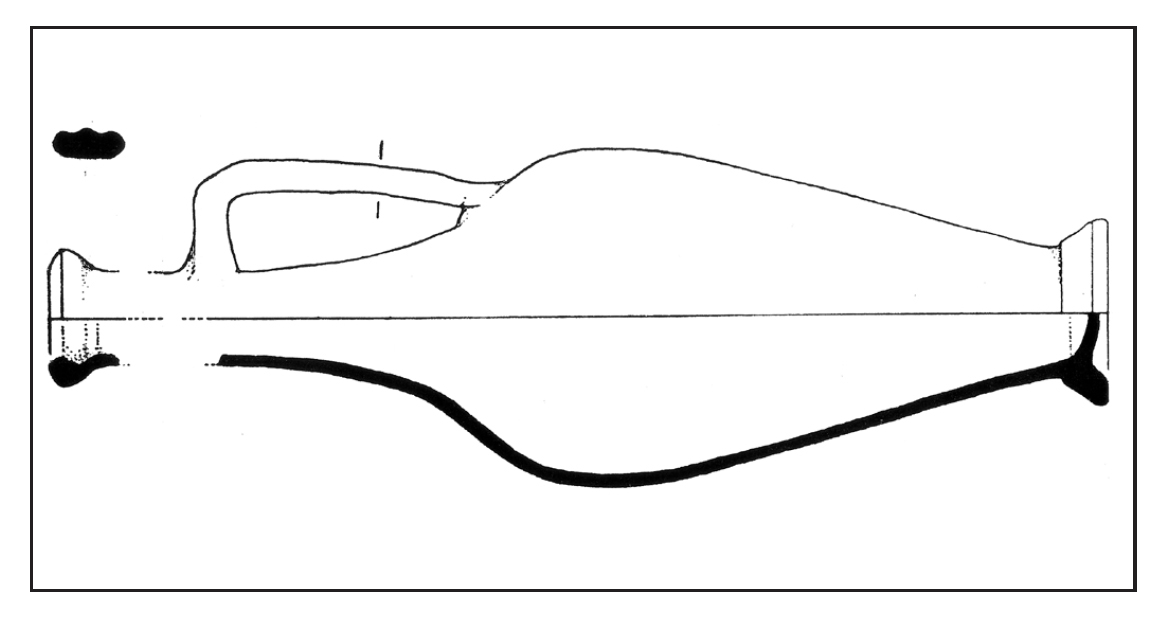
Introduction
The picture of fish sauce that emerges from the ancient literature is complex. The ancient writers who discuss these products do so without the precision we need and often contradict each other so that a precise understanding of which sauce corresponds to which recipe, production process or name is less than clear. The ancient literary evidence is largely provided by two quite distinct kinds of text : on the one hand 1st c. AD elite Roman consumer perspectives from letters, Natural Histories, poetry and particularly satire, and on the other texts that are perceived as late-Roman from users such as cooks, doctors, and vets. These texts often derive from much earlier Greek sources so the evidence appears to be polarised both by time and by culture.
The early elite consumer tells us only of the exclusive and expensive types of garum which may have had quite a narrow culinary role and appear as the primary product, while the everyday cooking fish sauces used by millions of ordinary Romans and Greeks around the empire are hardly comprehended at all in the literature 1. In zooarchaeology we have the reverse situation, as the only recognised evidence for fish sauce is the bone fragments from small clupeidae and sparidae, which are identified as part of the apparently bony fish paste known as allec, the consumption of which is viewed as low status 2. This stark contrast in the perceived status of the consumer of each kind of evidence makes for confusing conclusions, such as the tendency for fish bone specialists to consider certain forms of this fish paste as an elite product with reference to the discussion in Pliny 3.
In the course of this study it will become clear that many ancient elite consumers of fish sauce did not actually understand the products at all well and it is their confusion that is directly responsible for ours. At the heart of this ancient and modern confusion is the failure on the part of modern researchers to comprehend fully that there were multiple varieties and qualities of fish sauce, some for cooking, some for the table, just as there are today in south east Asia. We can and must attempt to differentiate between them through a synthesis of the archaeological and literary sources. Only with this level of analysis can we hope to disentangle the complex problem of nomenclature. The ultimate aim is to gain a greater understanding of the relative value of the different fish sauces within in the ancient economy, and not least within Roman cuisine. In what follows I will offer a radically new way to approach the dilemma of how to differentiate between the various fish sauces which takes account of the opinions of those who made, traded and used these products.
1 Corcoran 1962, p. 205.
2 Van Neer 2002, p. 208.
3 Cotton 1996, p. 223-238. Pliny The Elder HN 31.96. « Allec is the sediment of garum, the dregs neither strained nor whole. It has, however begun to be made separately from tiny fish, otherwise of no use. The Romans call it apua, the Greeks aphye, because this tiny fish is bred out of rain… Then allex became a luxury and its various kinds have come to be innumerable… Thus allex has come to be made from oysters, sea urchins, sea anemones, and mullet »s liver and salt to be corrupted in numberless ways so as to suit all palates ». The Geoponica is very clear that the residue makes allec not that the entire residue is allec.
4 Corcoran 1963, p. 204-209 ; Curtis 1991, p. 13 ; Curtis 2009, p. 713 ; Studer 1994, p. 195 ; Etienne 2007, p. 7 ; Van Neer 2002, p. 208.
1. The single sauce hypothesis
Within ancient historical and archaeological research there is currently an assumption that there was only one type of Roman fish sauce. This sauce was called garum ; all the varieties of fish, different components of fish, recipes and qualities were all defined within the generic term garum. The distinction between the fish sauce made from small and medium whole-fish with extra viscera and that made from just fish viscera and blood is acknowledged by the leading scholars in the field but they are all considered forms of garum 4. This belief stems largely from the statements on fish sauce by Pliny the Elder. Pliny’s garum is the luxury product made from fermented viscera and « other parts that would otherwise be considered refuse »(31.93). Pliny has stressed the viscera which is associated with the expensive sociorum garum and not directly referred to whole fish but his « other parts » have nonetheless been taken to mean small fish otherwise of no value : thus he seems to be referring to a whole-fish sauce not a blood/ viscera sauce. As he subsequently suggests that the residue of this garum makes allec and that this is a fish paste derived from whole fish, he must not comprehend that there were two types. The surviving Greek recipes for fish sauce also affirm the importance of the distinction between blood/viscera sauce and one made from whole fish. It is clear from the Geoponica too that the term garon, with an additional adjective to designate the blood/viscera sauce, did function generically in Greek 5. To make matters worse some ancient commentators, largely elite consumers, also seem to use the Latin term garum in a generic sense ; however it will be my contention that garum, for those who manufactured and traded these products, was a specific term in Latin referring to the blood/viscera sauce rather than a general term and that for most of the Roman period the word liquamen actually represented the primary product : a fish sauce made from whole-fish 6.
Manufacturer, trader and user didn’t use the word garum, as the elite writers seem to, as a term for the general idea of fish sauce in Latin, they employed a far more specific and technical terminology, which we may suppose involved precise use of all the terms at their disposal and which survives in ancient texts and on amphorae – in both Greek and Latin 7. There are a number of instances where fish sauce is described in term of colour. The blood/viscera sauce will necessarily be darker because of the blood and in fact we do find « black » and « bloody » adjectives being used in Greek texts 8. However in Latin the literary sources do not use specific adjectives with garum referring to colour. Instead we only find the singular garum, garum sociorum or liquamen. The use of the word sociorum « of our allies » we are told by Pliny refers to the luxury mackerel garum made in New Carthage in Spain. Martial describes this sauce being « made from the blood of a still breathing mackerel » and it therefore implies this black and bloody sauce 9. Whether we can say that all the sauce made by this company of allies in New Carthage was the luxury blood/viscera sauce is unclear and probably quite unlikely. The terminology used in the dining rooms of Rome may well have been different to those used by the manufacturer. Crucially we cannot know which sauce is being referred to when garum occurs singularly in Latin texts. Writers may not actually know or care which one they are referring to, especially in satire.
The meaning in Latin of liquamen has always remained obscure and has long been assumed to be a Late Latin equivalent for garum 10. Garum only appears in the early period, liquamen in the late and it is generally assumed that the word garum fell out of favour and liquamen simply became the more popular word. Not only has no one thought to question why this should be the case but no one has considered that multiple varieties of fish sauce require multiple terms in Latin and they do not seem to exist 11. If one looks closer at the literary evidence it becomes apparent that all the early elite Latin consumers refer to garum and there is no reference to liquamen at all. Liquamen is not a term used by elite/ educated Romans 12. Liquamen exists only in apparently late and vulgar Latin didactic literature such as veterinary and cookery books, which though considered to be written in the Late Empire, often can be seen to derive from much earlier Greek material 13. The situation is clearly more complex than a simple switch in terminology. It is admittedly clear that Latin garum is hardly mentioned in any forms of elite Latin literature after the mid 3rd c. AD, though the term does not disappear entirely as Ausonius makes an obscure reference to it in the early 4th c.14 We can also see parallel use of garum and liquamen in their occurrence on amphorae tituli picti from Rome and Pompeii in the 1st c. AD. That garum always meant something different to liquamen can be seen in its presence along side liquamen in the medicinal and veterinary and culinary texts 15. The employment of both terms suggests that garum had a meaning distinct from liquamen in the early period which was still current when the later fish sauce had apparently been renamed liquamen. Curtis acknowledges that liquamen must have had a separate meaning to garum in the first century AD but he maintains that it was the 2nd and subsequent washings of the residue of garum which is the only way to explain the later convergence of the terms 16. I would disagree here as the tituli picti do not suggest this and there is no evidence at all to this effect.
5 Geoponica 46. Dalby 2011, p. 348-349. The difference between the two sauces concerns the fish blood rather than viscera which, from my experiments, provide additional digestive enzymes rather than distinctive characteristics. The flavour of a liquamen made with and without extra viscera is indistinguishable and dominated by fish flavours while the blood sauce taste and smells quite distinctly of iron and is not fishy at all.
6 Curtis 1991,p. 7.
7 In Greek : garon, garou melanos,(black) : Galen, Kuhn 1965, p. 637. garon haimation (bloody) : Geoponica 20.46.6, Dalby 2011, p. 348-349 ; P. Anst. inv. no 44. In Latin garum, garum sociorum, gari nigri, garum flos, liquamen, liquamen flos, muria and allec.
8 For other ref. to gari nigri : Aetius 3,83 and Latin translations of Galen, see note 37. Pliny talks of garum blended to look like « aged honey wine » : Pliny HN 31.93.
9 Pliny HN 31.94 ; Martial 13.102, Curtis 1991 p. 8, n. 11.
10 In Greek liquamen is a hapax legominon appearing only in the Geoponica where it appears to be a direct translation of garon. For the standard view Etienne 2007, p. 7.
11 Curtis 2009, p. 713 ; Cotton, Lernau and Goren 1996, p. 231.
12 It is cited in Columella three times at 6.2.7 ; 9.14.3 and 9.14.17 but each time liquid generally are meant.
13 Grocock and Grainger 2006, p. 13-23, 61 ; Adams 1995, p. 663. Much of Pelagonius and Vegetius is derived from writers such as Celsius, Columella and Apsyrtus : the Greek horse doctor.
14 Ausonius Epist 25. 21.
2. Studies on fish sauces
2.1. The origins of fish sauce in the Mediterranean
Garum was clearly derived from the original Greek word garos and seems to have been the name of a fish used to make the sauce in Greece according to Pliny. This fish is unknown but we may reliably assume that it was small clupeidae and sparidae. We know that 5th c. BC Greek comedy refers to garos from the Black Sea and by the 4th c. Cadiz was shipping garos to Athens 17. We know very little about this early fish sauce apart from the fact that it was considered rotten. Crucially the image of fish sauce use from the early Greek sources never appeared to have a luxury tag : the foods it was associated with were simple poor man’s vegetables and pulses and it formed a very basic dressing or dipping liquid with oil and vinegar or wine 18. The formal Greek cuisine that emerged during the Hellenistic period seems to have been defined around the use of this garos and it is this cuisine that arrived in Rome in the 2nd century BC when the Roman elite fell under the spell of Greek dinning culture 19. At this point we must assume that this garos was made from small fish, otherwise of no value, and the term simply became latinised into garum. At this early period we seem to be dealing with a single sauce of the whole fish garos type.
However the cuisine associated with elite dining as described by Archestratus in the late 4th c. BC in Sicily does not appear to use a garos fish sauce, despite its apparent importation into Athens at this time, but does make use of a similar dipping sauce blended with vinegar and oil made with a salted fish « brine » called αλμη (almē) 20. If Archestratus reflects elite practices a century before the Romans acquired a liking for Greek dining practices then the use of halme and its Latin counterpart muria would seem to be the more elite product and the knowledge and use of it would also be widespread. There was clearly more than one type of fish sauce at the end of the Hellenistic period. Garos and muria were sufficiently different to require separate names though whether the blood/viscera garum had yet been developed is not clear.
2.2. Apicius : the Roman recipe collection
The text where we find fish sauce in use most often is the recipes collection known simply as Apicius. In 2006 I along with Dr Christopher Grocock published a new edition of this text 21. The text had been interpreted by Brandt to be a collection of recipes written down if not actually compiled by an elite gourmet in the late Empire 22. This was due to the use of vulgar Latin which is the literary register most common in the late Empire among the elite as well as the rest of society. However it was clear to us that the individual recipes had actually been written by the slave cooks who would speak and write their own « blue collar » Latin. The Latin was grammatically inferior and displayed no literary merit of any kind. Brandt’s imaginary compiler is also absolutely silent : there is no authorial voice in the text at all and one would expect an author/compiler to make himself known. The silent compiler suggested to us that this text was actually a functional collection designed by and for the cooks who devised and used the recipes. This conclusion has repercussions for dating the text too as it may be concluded that any vulgar/late Latin written by an elite gourmet would date the text to the late 4/5th c. AD but vulgar Latin from cooks cannot be so precisely dated : « Vulgar Latin…is just a collective label to refer to all those features of the Latin language that are known to have existed from textual attestations and incontrovertible reconstructions, but that were not recommended by the grammarians » 23. It is quite clear that a grammatically inferior written Latin co-existed with the more learned registers in 1st century imperial Rome and there is no reason why many of the recipes could not have been written down at that time. In fact some of the recipes contain internal evidence to suggest that they were originally written down as early as the 1st c. AD 24. We may also suppose therefore that many of these recipe collections, of which Apicius is just one surviving version, began the process of compilation in the early empire and under particular Greek influence as the surviving recipe collection retains its Greek chapter headings and contains numerous technical culinary terms which are hybrid Greek/Latin terms 25.
15 For Apicius see below. Pelagonius liquamen : 9 ; 11.2 ; 13 ; 98 ; 455 ; 457, garum : 428;13. Vegetius liquamen : 1.10.1 ; 1.17.10, 16 ; 2.91.2 ; 2.108.2 ; 2.132.4 ; 4.6.1, garum : 2.28.8 ; 3.28.10. Marcellus Empiricus, 5th c. medical writer from Gaul « Medicinae » liquamen 30.52 ; garum 30.41.
16 Curtis 2009, p. 713. Ausonius Epis.t 21.
17 Pliny HN.31.93. Dalby 1996, p. 75-76 ; Athenaeus, II, 67.b-c.
18 Dalby 1996, p. 25 Galen On the properties of food 1.25.2.
19 Grocock, Grainger 2006, p. 17.
20 Olson, Sens 2000, p. 159 (fr. 38). Athenaeus VII, 329b : where the brine is identified as from pilchard.
21 Grocock, Grainger 2006.
22 Brandt 1927, p. 30, 36, 130-3.
23 Herman 2000, foreward ; Grocock, Grainger 2006, p. 95 and note 1.
In relation to the issue of fish sauce terminology these conclusions have profound consequences. There is very little garum qua blood garum in Apicius : in these recipes the cook does not appear to use this sauce and in fact we have no reference to cooking with the blood/viscera sauce anywhere in the literary evidence. This would seem entirely logical too, as an expensive and intensely- flavoured blood sauce would be lost in the cooking process and wasted, while an expensive sauce needed to be seen by the gourmet to be experienced, valued and discussed. In Apicius, liquamen is the universal term for the primary fish sauce and even when we find garum, with two exceptions, it is part of a compound term directly transliterated from the Greek : όıνογαρον (oenogaron = oenogarum) and therefore referring to the original whole fish sauce. In Apicius oenogarum is a slightly more complex version of the Greek wine/ vinegar, oil and fish sauce dressing 26. These sauces are widespread throughout the text and represents a hot or cold, thin or thickened sauce used both within a cooked dish and served as a dip 27. When the recipes themselves were firmly dated to the late empire, the use of liquamen to designate the « single » fish sauce was at least rational. Now the recipes do not necessarily fit neatly into that early/late pattern, the lack of black garum in Apicius is striking. Apicius is supposed to be the epitome of high status cooking and black garum is the luxury sauce par excellence, so why is it barely mentioned ?
From modern South East Asian cuisine we learn of a fermented squid blood viscera (and ink) sauce that is used today in Japanese cuisine. It is known as ishiri and is used as a finishing sauce for sushi as well as cooked food. Its taste neither fishy nor salty, and smells of the iron compounds from the blood. Japanese cuisine also has a whole-fish sauce called ishiru and many dishes are prepared with both i.e the whole fish sauce is used for cooking and the blood/viscera sauce finishes the dish 28.
I would suggest that black garum was never part of the cooking process and its absence perfectly natural in both early and late recipes. It was too strong for cooking and was designed to be used at table by slaves or diners as a « finishing » sauce. It became popular among the elite to blend oenogarum sauces with black garum in the 1st c., but by the time the recipe collections had been finalised in the 4/5th c. its use in this way was limited. In Apicius garum occurs just twice : as a non compounded word, it is found at 7.13.1 where mushroom are served with garum and pepper : « Ash tree fungi : boil and serve while hot and dry in garum and pepper, as long as you pound the pepper with liquamen ». The recipe is of course ambiguous and we might use it to retain the current belief in the « single sauce ». However taken literarily the pepper is pounded into a mash with liquamen and then the mushroom are served with this mash and blood garum 29.
2.3. Garum and Diocletian’s Price Edict
The single sauce hypothesis is reinforced by the wording for fish sauce on Diocletian’s price edict. The inscription is a controversial source for many reasons which are not of concern here 30. Dated to AD 301 it lists the prices, in Greek for the eastern Empire and Latin for the west, of common commodities and services available when inflation was very high throughout the empire. We find that in Latin 1st and 2nd quality liquamen is rendered as 1st and 2nd quality garos in the Greek inscriptions 31. This is however what we should expect : the primary product of trade and commerce was liquamen and it corresponds to the original primary product from Greece. It is more surprising to find that a separate blood/viscera sauce or a muria is not listed. I would argue that the rarity of black garum in texts in the late empire, particularly in Apicius, reflects a rarity in commerce too and that it was not sufficiently popular at the time of the edict to warrant its own price. It was clearly commercially available as Ausonius’ letter confirms but may simply have been such a small percentage of the overall market that it didn’t warrant its own listing. It is possible that black garum always had a relatively small market in comparison to liquamen and lost what popularity it had in the late empire. I believe black garum was made to appear more important because of the unusually close view we get of the elite at table in the early empire through satire. The obsession in luxury foods in dining was largely concentrated in the early empire and later Romans looked on their ancestors
24 Grocock, Grainger 2006, p. 13-23 ; 369-372.
25 Oenogarum, oxygarum, hypotrimma, tisane, thermospodium, oxyporium, melizomum : Grocock, Grainger 2006, p. 27.
26 Dalby 1996, p. 25. Other compound sauce were oxygarum with vinegar ; hydrogarum which is a cooking liquor not a sauce per se ; garelaeum with oil (Orebasius 4.28).
27 A sauce poured over a dish (4.5.3 ; 8.8.7) ; a salad dressing for vegetables (passim book 4) ; a sauce used within a dish (4.5.1 ; 4.2.31 ; 4.2.5) and a dressing for fish or meat (7.3.1 ; 10.3.11,12). A translation for the word oenogaron is found in a late gloss to the Gargilius Martialis text. This text provides the other important recipe for fish sauce manufacture and the sauce is entitled « Confectio liquaminis, quod oenogarum vocant » « a liquamen sauce which is called an oenogarum.
28 http://www.ishiri.jp/en/ This sauce is truly fermented with bacteria and low salt. It is quite remarkable that the Japanese word for viscera is gari !
29 For a similar pepper mash : Apicius 2.2.8. Vegetarian version of these fish sauces existed it seems and the terminology used is indicative of the primacy of liquamen/garos. Pseudo-Pollux Quotid. 112v : a text with Greek and Latin has « with a garos of turnip » is equivalent to « with a liquamine » ; Palladius Opus Agri. 3.25.12 « Liquamine ex piris » ; Pseudo-Galen De Remediis vol 14, p. 546m.
30 Lauffer 1971, p. 124.
31 Id., p. 104.
2.4. The uses of black garum
If we look elsewhere at the references to garum in satire it becomes clear that the sauce being discussed is a visible thing as opposed to being hidden away in the kitchen. That the term liquamen is unrecognised by the gourmet is not surprising given that the « cooking sauce » would never be visible. We find garum poured onto oysters ; Ausonius when discussing the garum he has received says he will « fill my patina » with it : a patina is a thick set frittata delivered cooked from the kitchen ; fish is served as if floating in garum ; a garum piperatum pepper sauce is poured on to fish in a dish from a wine skin ; a garum sociorum made from mullet viscera is used to drown and serve with mullets while an allec is made from their livers ; a cook is expected to blend Falernian with aged garum and pepper to serve with a roasted boar ; a cheap mistress begs her lover for a small amount of garum ; Garum and in fact muria too is used to make special oenogarum sauces and the host discusses the ingredients being used in such detail that we may be able to say that these sauces were blended at table 33. Certainly finely decorated Samian wear mortaria are often found with wear pattern of use and this is difficult for archaeologists to comprehend as they are assumed to be table ware. Most mortaria are course kitchen wear vessels and the labour involved in their use would normally be hidden 34. It may be said that there are too few references indicating that blood garum was always used in different ways to liquamen. It is also apparent that all three types of sauce (muria, garum, liquamen) could be blended with wine and oil to make the dipping sauce oenogarum which was a visible component of ancient cuisine yet it seems clear from the recipes that the black sauce was not used in cooking. It may be possible to determine the quantities of garum to liquamen consumed through analysis of amphora size. The urceii or table top jugs that fish sauce was sold in at Pompeii came in many sizes (fig. 1).
All are very much smaller then the average fish sauce amphorae which can stand up to 90 cm. From published tituli picti in CIL, the majority of liquamen labels are on amphorae, while named and exclusive garum is largely found on the much smaller urceii. Curtis has also noted that these urceii labelled simply garum have been found in Pompeii in relatively modest dwellings and bars and, though he was at the time using garum to mean fish sauce generally, this must mean that black garum was also consumed among the sub-elites probably as a table sauce in the bars 35.
Urceus found in Terzigno near Pompeii (from Cicirelli 1996, fig. 10-41 p. 166).
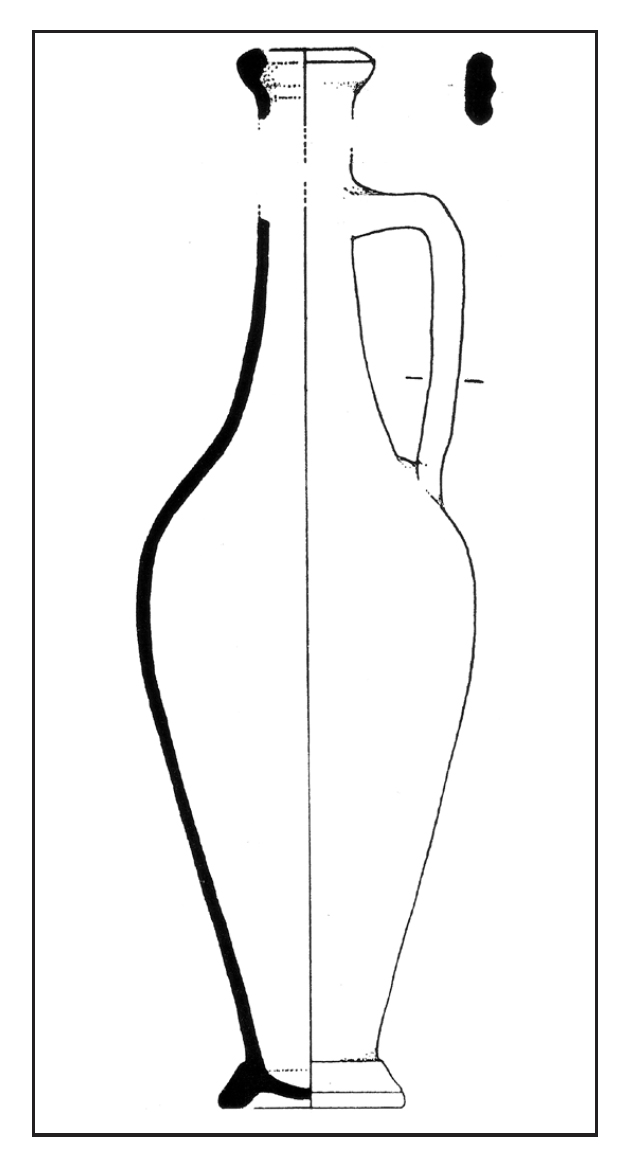
32 Ausonius’ text is discussed in detail below. While living in Southern Gaul in the 4th c. he had to have his garum specially delivered. Macrobius a century or so later « not that I am saying we should be though superior to the ancients…. but I am just stating the facts : people were keener on luxuries in those days than they are now » (Macrobius Saturnalia 111.13.16).
33 Martial Epi 13.82 ; Ausonius Epist 21 ; Seneca 3.17.2 ; Petronius Satiricon 36.3 ; Pliny HN 9. 66 ; Martial 7.27.8 ; 11.27.
34 Horace Sat 2.8 ; 2.4.63-9 ; Willis 2005, p. 8.4.4 ; Biddulf 2008 p. 91-100.
35 Curtis 1991, p. 159-175 ; The difference in volume sold can not be calculated as capacity of amphorae are rarely recorded but it does seem as though by volume more liquamen was sold than garum.
36 Grant 2000, p. 138 ; 141 ; 146.
37 Galen Opera Omnia ed. C.G. Kuhn (1965 reprint of 1823 edition Hildesheim George Olms) Bk 12.637. (comp. med.sec.loc) « For the stench of wounds that (remedy) which is called “of the Spanish”. Take : black garos, called oxyporum by the Romans, 1 sextarius, squill vinegar, 1 sextarius, Attic honey, 1½ ; boil until it binds, and put it away in a glass vessel and use ». Translation with gratitude : Justin Mansfield.
38 A Latin translation of this remedy made in the Renaissance, gives the following translation of the 2nd line »gari nigri quod Romani sociorum appellant.« (black garum which the Romans call « of our allies »). Galeno 1537, p. 361.
39 Apicius 1.32 ; Columella 12.59.4. Garum in a remedy : Columella 6.9.1 to treat fever in ox ; 6.34.2 to treat horses ; 7.10.3 to treat scrofulous pigs. Liquamen is used in veterinary remedies c.f. note 17.
2.5. Fish sauce in Galen
Galen’s use of fish sauce in his treaties on food and diet is valuable as there are numerous references to what we now know is a simple whole-fish garos which is blended with wine/vinegar and oil as a simple dressing for vegetables as we have come to expect. Lettuce for instance is boiled in the winter and served with olive oil, garos and vinegar while mallow and cabbage are served with olive oil and garos in order to ease their passage through the body. Galen also lists many pot herbs such as celery, hyacinth and rocket which are all served in a similar way 36. There is just one reference to black garos in Galen and it requires more consideration. The text is not that on food and diet which makes no reference to the black sauce at all which also supports the view that it was not used in the preparation of food, but one called « Medical compounds according to places » 37. The remedy is apparently called an oxyporium and considered a Spanish digestive and later versions of the text reference the idea that black garum was also called sociorum after the Spanish traders 38. Other medicinal recipes for oxyporium also make use of garum. In Apicius this remedy is mixed with vinegar and garum and this is in fact the only other direct reference to garum in Apicius that is not combined in a compound term and subsequently listed as a liquamen. This source indicates that black garum had a continuing medicinal role throughout the period even if it appears to be used less at table 39.
We cannot know when the blood viscera sauce was introduced into ancient cuisine. It certainly does not seem to be part of the early Greek evidence and its introduction may have been instigated by influence from Rome as the knowledge of these sauces spread. As a theory I offer the following : as fish sauces became generally more popular in Rome the elite would have been concerned with differentiating their foods from everybody else’s.
If the consumption of liquamen fish sauces made from small fish was widespread then the elite would create a demand for a luxury version. The manufacturer may have instigated new developments in fish sauce types to meet this demand. One of these would have been the blood and viscera sauce, though how they thought of it is quite bizarre to comprehend. Its expense meant that it functioned as a table condiment and the gourmet could control the bottle and discuss its merits to demonstrate his culinary knowledge. Other developments at this time may have been the use of much larger fish, that did have a market value as salted fish, such as mackerel, tuna and larger clupeidae and sparidae. We may surmise that the fashion for Greek culinary culture at this time would mean that the original term was retained to designate the new luxury black table sauce forcing the merchants and traders to coin a new term ; liquamen to designate the original small whole-fish sauce 40. Liquamen remained in the kitchen and invisible to the diner who only saw and valued expensive sauces at table. In the later Roman period as black garum was not as visible either in commerce or at the table, it was naturally taken for granted among some commentators, as it has been today, that garum was just the Latin for garos and it began to be used to designate the single primary product. Only this seems to explain the group of late and early medieval references that claim that garum was equivalent to liquamen 41. They must have genuinely believed at the time that it was and simply did not comprehend the complexity behind these products.
2.6. Muria and the Ausonius letter 21
The letter sent by Ausonius to his friend Paulinus in the early 4th century is quite intriguing and deserves to be quoted in full.
« Fearing that the oil you sent me was not pleasing, you repeated your gift and distinguished yourself more fully by adding a condiment (of muria 42) from Barcelona. But you know that I have neither the custom nor the ability to say the word muria, which is in use of the common folk, although the most learned of our ancestors and those who shun Greek expressions do not have a Latin expressions for the appellation garum. But I, by what ever name that liquor of our allies is called, “now will soon fill my patinas so that that juice (sucus), more sparingly used on our ancestors tables, will flood the spoons” …. » 43
The issue of the difference between garum and liquamen can be dealt with quite easily : if he believes that there is no Latin expression that he can use to replace garum then liquamen clearly cannot be equivalent to it. That he associates it with sociorum suggest he has received a blood/viscera sauce and there is no term in Latin for this. What requires explanation is his apparent use of muria to designate the sauce he has received.
Muria is primarily a brine ; that is, salt and water. It is also defined as the brine that salted fish are stored in (muria salsamenti) 44. Muria appears very rarely in Apicius and seems not to have been a regular part of the cook’s seasonings in the preserved recipes. This product is seen as a lower status form of seasoning but we have seen that a form of fish-brine was used in elite 4th c. Greek cuisine as an ingredient in dipping sauces and this combination is also found in references to food in Roman satire, so muria could potentially be desirable and especially if aged 45. Muria may have been valued because it was a « clean » sauce i.e. free of fermenting viscera, which was perceived as putrefaction 46.
Martial’s epigram on muria that follows the one for garum sociorum has often been seen as evidence that muria could in fact designate another garum made from tuna blood and viscera 47.
« Amphora Muriae
I am the daughter, I admit it, of Antipolitan tunny. Had I been of mackerel, I should not have been sent to you ».
It is fair to say that it is not logical, to have another term to designate the blood/viscera sauce which can also mean a completely different less valued product entirely. However the perception of muria as low status is deceptive as we must ask for whom is it inferior and where it fits in the sliding scale of fish sauce quality. Martial has, I think, juxtaposed garum with muria here because they represented the two different types of sauce that could be valued in Roman cuisine rather than offering two that were virtually the same. After all what can be said of the differences between one lot of fish viscera and another !
We do not know the volume of tuna caught in the Mediterranean but given the potential size of this fish it is likely to be large and the volume of muria generated clearly had a market. However I suspect that tuna was not used to make a liquamen but only made garum or muria as a secondary product to the salted fish 48. It is apparent that tuna muria could be aged and would mature in flavour and value 49. Tuna would also generate vast quantities of viscera and blood which would make tuna garum just as the Geoponica advocates and archaeological evidence confirms the use of tuna blood in the production of garum haimation 50. This poem and amphorae tituli picti suggest that mackerel actually served as the best fish to use both for muria and garum. The elite therefore would consider tuna muria a product for everyone else to consume. Everyone else actually represents the thriving middle in Roman society, not the poor. We may also propose that garum could be made from a mixture of many types of fish blood and viscera and this would ultimately represent the lowest quality garum. Horace has one gourmet tell his guests that their oenogarum was made with muria and another who makes it with garum 51. I had considered that this muria consuming gourmet was being ridiculed by the poet but clearly it is not that simple. The choice of which sauce to use in a given circumstance will depend on factors we do not necessarily understand. In the late empire liquamen is also described as a vulgar term in contrast to garum, but this does not mean that liquamen « per se » was necessarily lower class or cheaper ; this would depend on its origin, variety, manufacturer and recipe used 52. I have conducted many experiments to manufacture liquamen fish sauce and though they cannot be dealt with here in any detail it has been possible to demonstrate that long term storage of the unfiltered sauce results in exceptional nutrition 53. An image of an unfiltered mackerel liquamen sauce can be seen in fig. 2 where the residue or allec is floating on the top of the clear enriched sauce. When this bone-free residue was re-brined and left for a few months, a relatively good quality second sauce was generated and which we find described on the price edict 54.
Returning to Ausonius’ letter, these discussions have allowed us to see that he strikes a lofty pose and looks down on muria which he suggest is a vulgar term and we therefore assume it is a cheap and commonplace ingredient but vulgar is clearly a relative cultural idiom and from his lofty position is clearly the term that everybody else uses. He appears to be discussing the very idea of fish sauce seasonings generally and, as he does not want to use garum and as he has not received liquamen, he is using the only other term at his disposal : muria, which is only slightly lower quality than the garum sociorum that he values. At the same time he acknowledges that it is inadequate and expresses some frustration over the issue of what to call whatever he has received : « by what ever name that liquor of our allies is called. » That he has received a black garum is fairly clear but this letter also demonstrates that in the late empire fish sauce terminology had become a complicated issue.
40 The term liquamen is cognate with liquere/liquescere meaning « to be liquid » and « liquefy ». Isidore of Seville in the 6th c. defines liquamen as « little fish dissolved during salting produce the liquid of that name » and defines garum as the « juice of fish » Etymologiae 20.3.20. Corcoran 1962, p. 205 was the first to be confused by the Isidore definition and combine the liquor from salted fish (muria) with the sauce derived from dissolved fish.
41 Caelius Aurelianus 5th c. medical writer Chron 2.3.70 « ex garo quod vulgo liquamen appellant » ; 2.1.40 « vel garum quod appellamus liquamen » See partic.Beda Gramm. 7.279,10 « muria id est garos » which in the 7th c. may refer to the fact that in Roman Palastine muria/ies seems to have been the term for the primary product i.e. liquamen (Weingarten 2005).
42 This first muria is out of place and is not needed in the sentence. It seems strange that he used it at all having subsequently declared that he doesn’t like the term. Andrew Dalby (per. com.) has suggested that this first muria is a gloss and I am inclined to agree.
43 Ausonius Ep. 21 (Translation C Grocock) That he claims this sauce was « more sparingly used on our ancestors tables » is difficult to comprehend as noted by Corcoran (1963, p. 205).
44 Cato RR 7 ; Columella 12.55.4 ; Gargilius Martialis, Curae boum ex corpore. 4 ; Pliny, HN. 31.83-92 For its low status image c.f. Isidore of Seville Etym. 20.3.20.
45 Horace 2.4.63-9. An amphora tituli picti from London suggest that young tuna could be aged for 2 years. This cannot be whole fish as it would not be fit for consumption at that age and therefore muria is likely though un-named. Tituli picti also suggest muria could be aged Curtis 1991,p. 197. http://www.museumoflondon.org. uk/Collections-Research/Research/Your-Research/Londinium/Lite/ classifieds/sauce.htm (19/10/2012).
46 Seneca. Epist 95.25 « A costly extract of poisonous fish which burns up the stomach with its salted putrefaction ».
47 From the use of tuna viscera to make the haimation or bloody sauce in the Geoponica. Martial Epigrams 13.103 ; Corcoran 1963 p. 206 ; Studer 1994, p. 195.
48 Curtis 1991 p. 6. One may imagine the non-viscera waste matter from such a large fish generating a cheap muria too.
49 See above note 45. There is a modern fish sauce called colatura di Alici tradizionale made in Salerno Italy which involves very time consuming evisceration of tiny anchovy. The absence of viscera which provides digestive enzymes makes this sauce unusual. The sauce takes a year to completion and the tradition may go back ancient times and derive from a desire to make a « clean » fish sauce. It claims to be a garum, but has more in common with a muria. http:// www.youtube.com/watch?v=GVGaz5yT67E.
50 Tiny gill bones from tuna have been found in a storage vessel in Aila Aqaba Jordon (Van Neer 2008).
3. Conclusion
It has been possible to see that each type of fish sauce could have had different roles within Roman cuisine. The sauce made just from blood and viscera is clearly sufficiently different in taste and flavour from the whole-fish sauces and fish brines to warrant the development of specific and sophisticated roles for all three sauces, which may have been instigated by apparently proactive Roman gourmets.
There is a complex social order behind the consumption of these multiple varieties and qualities of fish sauce which would benefit from further study. When talking of fish sauces in archaeology and history it is now necessary to be much more precise and stipulate if possible which kind of fish sauce is being referred too. One could buy aged elite black mackerel garum, ordinary black tuna garum, elite liquamen cooking sauces made from mackerel or cheaper cooking sauces made with a mixture of clupeidae and sparidae, or a tuna or mackerel muria, both of which could also be aged or new. All of these products could also come in second or even third grade versions. Distinguishing between them will not always be possible in the archaeological record but a recognition of the diversity is essential. It is also no longer adequate to simply refer to a single product called garum as the term cannot convey the complexity of these products and its use actually confuses more than it aids our understanding of the fish sauce trade. It is clear that the perception of the quality of these products depends on many factors : the particular taste of the consumer, the particular role the sauce will have in the meal and whether that meal is everyday or a rite of passage feast as well as the purchasing power of the consumer and where the consumer is placed and places himself in the social order.
51 Horace sat 2.4.63-9;2.8.
52 See note 8 above. Curtis 1991, p. 195 where he sites many tituli picti of named manufacturers.
53 Grainger forthcoming ; Grainger 2010.
54 see note 3 with ref to the bone free allec.
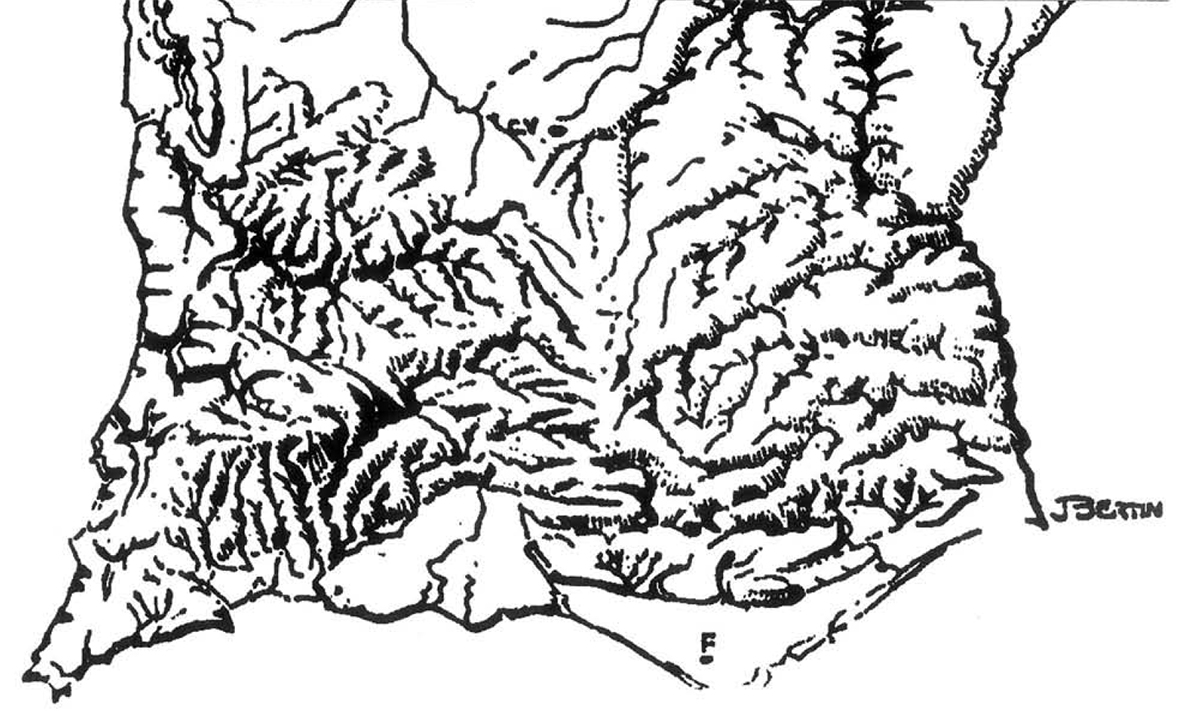
Centro de Arqueología e Historia. Facultada de Letras de Lisboa. Cidade Universitaria 1699- Lisboa Codex. Portugal.
OS DADOS DA QUESTÃO
Em 1987, J. C. Edmonson, na tese que consagrou á exploração dos recursos mineiros e marinhos na Lusitânia, tentou tratar de um modo sistemático e racional o heterogéneo conjunto de informações disponíveis sobre cetariae, fornos de ânforas e articulá-lo com as formas de povoamento da antiga província romana do extremo ocidental da Hispânia. Esboçou, então, um modelo de explicação, retomado em texto posterior (Edmonson, 1990), que tentava cobrir as diversas realidades observadas. Em sua opinião, a exploração de recursos marinhos, produção de preparados de peixe e contentores para os exportar poderia enquadrar-se em três regimes diferentes, embora, naturalmente, complementares: um sediado em centros urbanos do litoral, outro instalado em centros (vici) de carácter suburbano e um terceiro, de âmbito rural, associado ao povoamento de tipo villa. Este último regime seria particularmente observável no Algarve, onde a exploração destes recursos assumiria um carácter subsidiário das atividades agrícolas (Edmonson, 1987; 129). Na sua opinião, os preparados de peixe produzidos neste mundo rural destinavam-se fundamentalmente ao autoconsumo, com um eventual escoamento dos magros excedentes para os centros urbanos mais próximos, em contentores de morfologia peculiar, as «local type amphoras» (Edmonson, 1987: 276-278 e 1990: 137).
Esta hipótesis é articulável com as opiniões expostas por J. G. Gorges, sobre o carácter original das villae algarvias, no contexto da Lusitânia, com implantações supostamente diferentes da norma da atração por centros urbanos e grandes vias observada em outras regiões da província (Gorges, 1979: 65-6 e 1990: 96 e 101-6).
Os fundamentais trabalhos destes dois autores constituíram o natural ponto de partida para o presente estudo. No entanto, a revisão global dos dados atualmente disponíveis permite questionar os fundamentos desta presumida originalidade algarvia, já que, por um lado, não parece correta a ideia de um regime de produção de preparados de peixe em âmbito rural, nem se deteta a existência de quaisquer tipos locais específicos de contentores para transporte e comercialização dos mesmos; por outro lado, não parece ser especialmente diferente a estratégia de implantação das villae em território algarvio, como se procurará demonstrar. Estas observações, que se colocam a discussão, em nada diminuem os contributos de Edmonson e Gorges, procuram somente retificar a ideia estabelecida de uma pretensa originalidade do extremo meridional do território hoje português que, aparentemente, não existiu de facto.
O ALGARVE
O Algarve constituí uma região bem individualizada no atual território português.
A norte é delimitado pela serra, que o separa da peneplanície alentejana, e é constituída por duas grandes massas de relevo a Serra do Caldeirão, a oeste, e a de Monchique, a este, que descem em anfiteatro na direção do mar (fig. 1).
O restante território compõe-se de formações mesozóicas e terciárias, parcialmente cobertas pela planície litoral pliocénica e sedimentos quaternários (Ribeiro et alii: 1987: 16 e 224-5 e Feio, 1983: 93-113.

Assim, o Algarve aparece naturalmente dividido em três grandes regiões: a serra, de fraca aptidão agropecuária, o barrocal de maciços calcários, de vertentes pedregosas, separados por amplas depressões, onde predominara os pomares de sequeiro ou, parafraseando Orlando Ribeiro, «verdadeiras matas de frutos» (Ribeiro, s/d: 58), e a planície do litoral com extensas áreas arenosas, mas também com terrenos de boas aptidões agrícolas (Feio, 1983: 111) (fig. 2 e 5). A Oeste, a ampla foz do Guadiana separa a região da vizinha Andaluzia, embora exista uma evidente continuidade geomorfológica entre o território hoje espanhol, na época romana pertencente a vizinha província da Bética (Alarcao et alii, 1990), e o litoral algarvio, como, alias, já Gorges sublinhou (1979: 65).
De um ponto de vista agrícola, o Algarve de hoje aparece emblematicamente associado aos pomares de árvores mediterrâneas e as hortas irrigadas, uns e outras celebradas pelos autores muçulmanos (Coelho, 1972: passim). Estes mesmos autores não deixam de sublinhar a existência de manchas florestais que forneciam a indispensável matéria-prima para a construção naval. São estas referências que têm suscitado a ideia, provavelmente, não muito correta, como se verá, de esta paisagem ter sido criada pela presenta árabe, particularmente no que respeita ás hortas irrigadas (Feio, 1983: 121).
Com um extenso litoral e francamente aberta ao mar, integrada no amplo golfo constituído pelas costas luso-hispano-marroquinas, uma «espécie de pré mediterrâneo» (Ribeiro, s/d: 56) a região sempre esteve profundamente ligada á exploração dos recursos marinhos e ao comércio naval. A citada existência de boas manchas florestais assume, por isso mesmo, particular importância, já que fornece as matérias-primas necessárias a construção naval.
A Arqueologia do Período Romano no Algarve
Também do ponto de vista arqueológico o Algarve constitui um caso singular no panorama do atual território português. Foi sistematicamente prospetado e os seus locais de interesse arqueológico seletivamente sondados por Estácio da Veiga nos meados do século XIX, no âmbito de um pioneiro projeto de cartografia arqueológica, posteriormente continuado por Santos Rocha e Leite de Vasconcellos, entre outros. Infelizmente, a exaustiva e sistemática obra Antiquidades Monumentaes do Algarve, onde o primeiro reuniu o produto do seu labor, não chegou a ser concluída, tendo ficado apenas esboçados alguns dos capítulos relativos ao período romano, publicados a título póstumo nas páginas de «O Archeólogo Português». O segundo, cedo trocou no Algarve pela região centro do nosso país, com particular ação na zona da Figueira da Foz e o terceiro, em sucessivas «excursões arqueológicas», foi carreando importantes contributos para o conhecimento do passado da região, mas sem o carácter continuo e sistemático que caracterizara a obra de Estácio da Veiga.
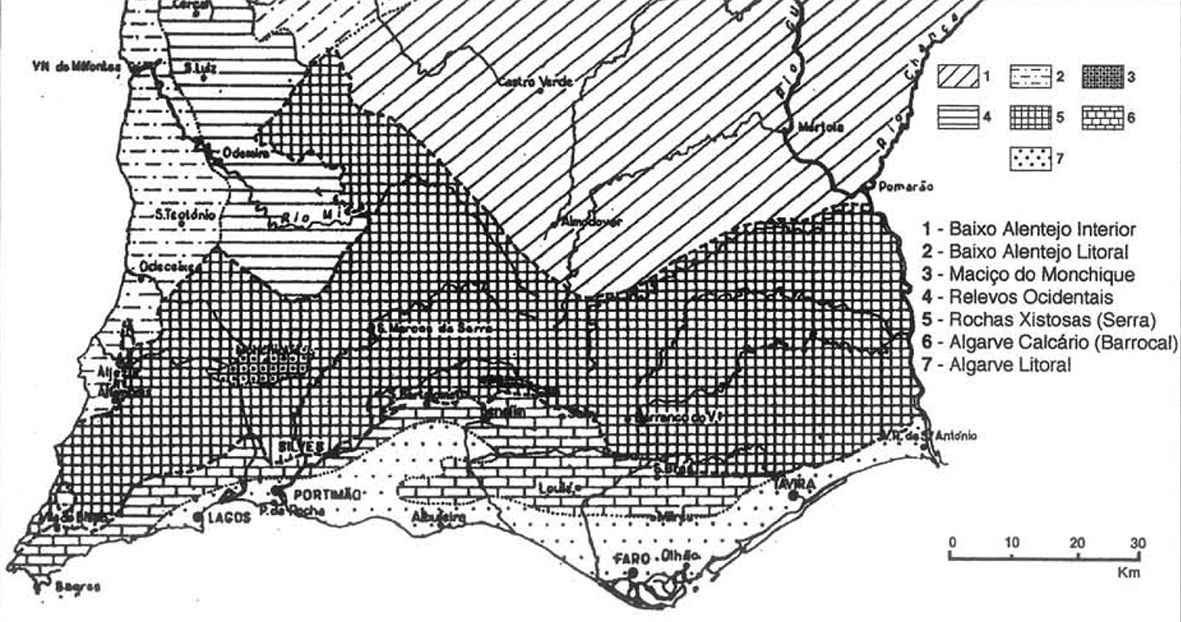
Praticamente sem interrupções, os sítios arqueológicos algarvios continuaram a ser inventariados e estudados por sucessivas gerações de investigadores locais ou estranhos a região. Para não alongar demasiado a lista, cite-se a tese de licenciatura de Maria Luísa Estácio da Veiga Affonso dos Santos que, recuperando o gigantesco acervo de dados coligido pelo seu antepassado, acrescentado pelos contributos posteriores, no principio da década de 70 apresentava um extenso esboço da carta do povoamento do Algarve na época romana (Santos, 1971-2) e, mais recentemente, o labor desenvolvido pelo grupo da Carta Arqueológica do Algarve (CAALG) dirigido por Víctor dos Santos Gonçalves (1979 e 1981) e posteriormente continuado por Helena Cantarino (1988), principalmente na metade oriental da região, por Teresa Júdice Gamito, em Faro (1991a e 1991b), Alvor e Serra Algarvia, Carlos Tavares da Silva, Mário Varela Gomes (1987) nas áreas de paisagem protegida da Costa Vicentina (Sudoeste) e Ria Formosa (cordão litoral do Centro e Este), entre muitos outros trabalhos de âmbito pontual ou regional).
Os dados atualmente disponíveis sobre as diversas formas de povoamento que o Algarve conheceu em época romana encontram-se reunidos e cartografados no gigantesco inventário elaborado por Jorge Alarcão (1988) e nos volumes da Carta Arqueológica de Portugal que o IPPC/IPPAR tem em curso de publicação (Passos, 1989 e Marques, 1992). Assim, por comodidade de referencia e para não sobrecarregar o texto com citações bibliográficas, todos os sítios arqueológicos mencionados ao longo do presente texto serão acompanhados pelos números de código constantes quer num, quer nos outros, quando ali não figurarem.
Deve sublinhar-se, porém, que este panorama apresenta enormes limitações. Se, por um lado, pela extensão e exaustividade dos trabalhos desenvolvidos, pode considerar-se minimamente representativo do povoamento do Algarve no período romano, por outro, a ausência de estúdios monográficos sobre os diferentes sítios a escassez das áreas abrangida pelas escavações, sempre que existiram, bem como o facto de, na maior parte dos casos, terem sido efetuadas ainda no século passado reduz substancialmente a qualidade da informação disponível.
Para além do mais, vicissitudes várias, que não poderão ser aqui extensamente tratadas, conduziram ao descaminho de muitas das peças recolhidas, a perda de informação importante sobre proveniências de artefactos e circunstâncias de recolha e a uma enorme fragmentação das coleções, dispersas por inúmeros museus locais e regionais, pelo Museu Nacional de Arqueologia, pelos espólios de antiquários e colecionadores, etc. Como se tudo isto não bastasse, a recente e desenfreada explosão do turismo algarvio, particularmente das zonas do litoral, feito a margem de qualquer planeamento ou de ações de salvaguarda mínima dos valores patrimoniais, acarretou incontáveis destruições, infelizmente irreversíveis, tanto em sítios já conhecidos como em áreas que nunca foram objeto de escavações ou prospeções.
Finalmente, deve sublinhar-se que a dinâmica geomorfológica das costas algarvias denota dinamismos que o arqueólogo não deve ignorar: um acentuado assoreamento das zonas de estuário, um generalizado afundamento das áreas litorais e consequente recuo de arribas e cordões dunares, para além da notória instabilidade de toda a área da atual reserva natural da »Ria Formosa». Estas modificações, insuficientemente estudadas, limitam os nossos conhecimentos sobre o povoamento do litoral, indispensáveis a uma correta avaliação da sua ocupação e utilização no período romano.
Todas estas lacunas e deficiências de informação condicionam fortemente a análise que se segue e ajudarão a explicar as razoes da deliberada assunção de um discurso no condicional ao longo destas «considerações». A consciência destas limitações afigura-se igualmente indispensável para sublinhar o carácter hipotético das explicações avançadas.
O ALGARVE NO PERIODO ROMANO
Face aos dados disponíveis, podemos afirmar que, nos primeiros tempos da conquista romana ou, pelo menos, desde o século I a.C., o território algarvio apresentava uma feição francamente mediterrânea nas formas do seu povoamento, com um significativo número de centros urbanos ou, no mínimo, de lugares centrais em vias de o ser. Devido as características peculiares da região, acima esboçadas, pode dizer-se que esta rede de centros polarizava a totalidade do litoral e barrocal, afinal uma estreita faixa de terreno com não mais de 23 km. de largura (Feio, 1983: 107).
Os Centros Urbanos (fig. 3)
Na época da conquista romana, o extremo meridional do atual território português
tinha já uma longa historia de contacto e interação com as áreas mediterrâneas,
de que constituí, alias, um prolongamento natural. Para além do mais, como atrás se referiu, a sua peculiar geografia abria-o mais aos contactos por via marítima, do que a qualquer penetração pelos difíceis caminhos que sobem a serra. Parece indiscutível, também, que dispunha de uma rede de lugares centrais de características proto urbanas, senão mesmo urbanas, que se distribuíam desigualmente pela franja litoral, com um caso conhecido no barrocal, que garantia, de facto, uma cobertura total de todo o território, a exceção da serra provavelmente, um caso a parte nas dinâmicas e estratégias do povoamento local.
Começando de Este para Oeste, encontramos na foz do Guadiana:
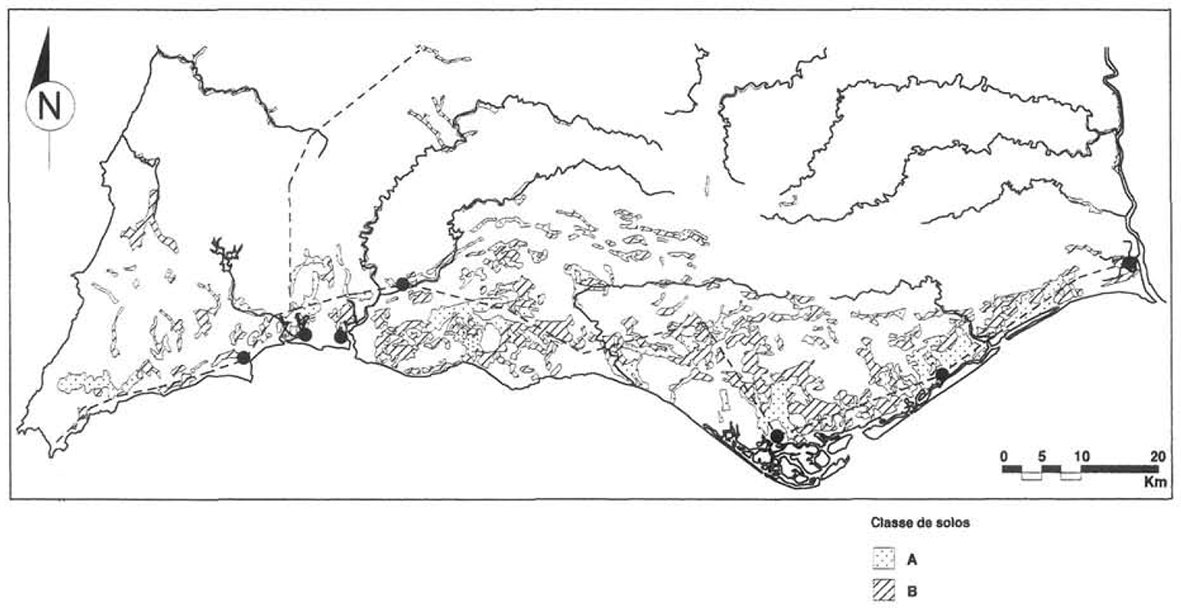
Baesuris (8/263) fig. 3
Implantada sob o atual castelo de Castro Marim, um lugar dominante atualmente rodeado de áreas de sapal. Embora não haja dados concretos de carácter paleográfico, afigura-se possível que, na época, constituísse uma península, sobranceira ao amplo estuário do Guadiana. Recentes escavações, infelizmente interrompidas, efetuadas sob a direção de Ana Margarida Arruda revelaram uma impressionante sequência de ocupações que se estende, aparentemente sem interrupções, desde o Bronze Final ao período romano (Arruda, 1991: 137-148). Cunhou moeda no período tardo-republicano (Faria, 1987: 1).
As escavações não permitiram caracterizar as ocupações posteriores aos inícios do período imperial, contudo, as categóricas referências do Itinerário de Antonino atestam a continuidade da ocupação, pese embora, talvez sem oesplendor de outras eras (Arruda, 1991: 137-148).
As razões da sua implantação e prosperidade devem relacionar-se com o controle da circulação no Guadiana, importante via de escoamento das riquezas mineiras do interior. Deveria encontrar-se em íntima relação com o centro de Myrtilis, sob a atual Mértola, localizada, por sua vez, praticamente no extremo navegável desta importante via fluvial.
Ainda hoje é zona de importante saliniculutura e, embora não se conheçam vestígios de centros para produção de preparados de peixe associados ao estuário do Guadiana, é provável que o forno (ou fornos) de ânforas de Olhos de S. Bartolomeu, implantado(s) junto ao esteiro da Carrasqueira, produzisse contentores para preparados de peixe processados nas suas imediações (v. Fig. 4 e Anexo 1). Certamente por deficiência de informação, Edmonson localizou em Vale do Boto um centro de fabrico de ânforas (1987: 277 e fig. 6.2.C.; 1990: 136 e fig. 2C).
No local, foi somente identificado um habitat romano, onde apareceram ânforas, e escavado um povoado muçulmano (Gonçalves et alii, 1980, Catarino et alii, 1981 e Catarino, 1988).
As causas do seu declínio poderão dever-se ao enchimento do estuário, que a afastou irremediavelmente do rio e do mar. No século XIII, a data da conquista cristã, não possuía já qualquer relevância regional, tendo sido substituída pela fortaleza de Cacela (Ribeiro, s/d: 81, Coelho, 1972: 49-51 e Garcia, 1986: 74). Foi repovoada, ganhando nova relevância por ser núcleo de fronteira do novo reino de Portugal (Garcia, 1986: 75-6). Em época mais recente seria definitivamente substituída pelo setecentista porto de Vila Real de Santo António. E interessante assinalar que ainda nos meados deste século, daqui se escoava o produto da exploração das minas de S. Domingos, Mértola (Feio, 1986: 137), já em laboração no período romano e talvez mesmo antes.
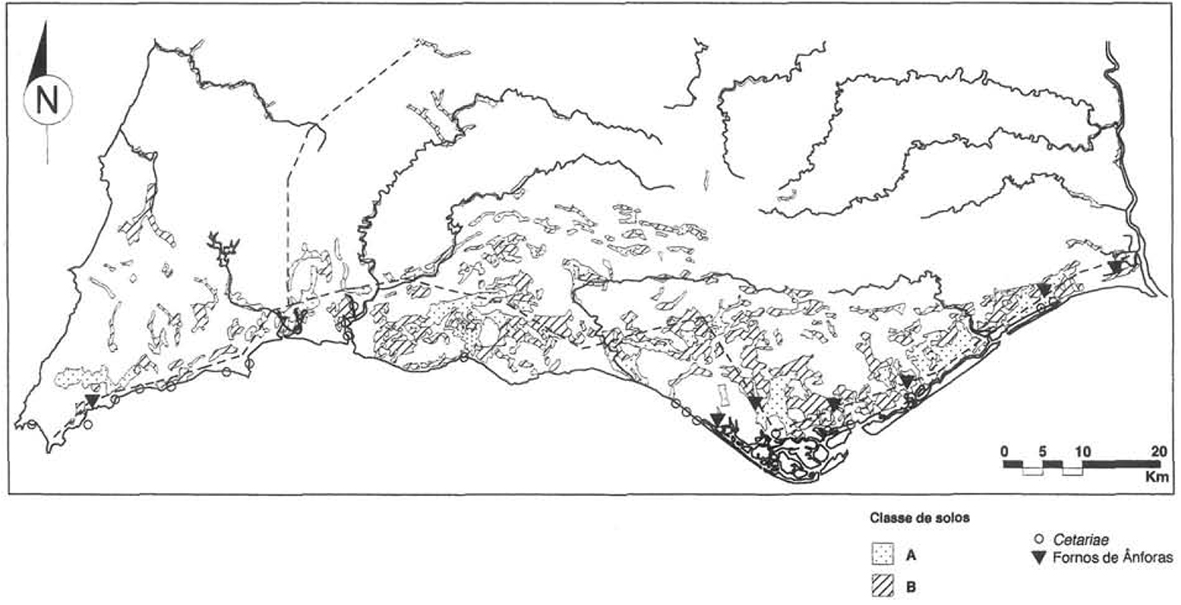
Balsa (d,/5lS) fig. 3
Implantada junto ao litoral nas proximidades de Luz de Tavira a cidade de Balsa, a julgar pelo topónimo, existiria já em época pré-romana, embora se desconheça desde quando. Os descontínuos trabalhos arqueológicos que ali se têm efetuado desde o século passado —certamente, menos relevantes que as destruições sofridas—, não revelaram quaisquer materiais anteriores ao período tardo-republicano, época em que terá cunhado moeda. Segundo Vasco Mantas, teria sido elevada a dignidade de município sob os flávios (1990: 192-3). Este mesmo autor identificou vestígios de um cadastro em redor da cidade e valorizou devidamente a diversidade de recursos de que dispunha. Tomando Baelo como modelo, defende que as invasões do século III teriam marcado o inicio da decadência da cidade, precipitada no século V (Mantas, 1990: 199). Contudo, entre os materiais depositados no MNAE e recolhidos nas escavações que o local conheceu figuram suficientes indícios de uma continuidade da ocupação, alias já claramente referida por Leite de Vasconcellos (1917: 126), e parece-me bastante provável, como adiante se explicará, que, ao contrario do que pretende Mantas, tenha sido justamente a decadência dos centros da Baetica que possibilitou um período de particular prosperidade para as cidades algarvias.
O mesmo autor (Mantas, 1990: 197-8), seguindo Maria Luísa V. S. Pereira (1974-7), defendeu a origem balsenses das ânforas da Classe 22 (= «Almagro 50» / Keay XVI) com as marcas LEV. GEN, OLYNT e AEMHEL (v. anexo 1). No entanto, o estudo recente destes materiais, particularmente a sua composição mineralógica não autorizam uma identificação categórica —embora também não a excluam— e a associação a materiais de construção com marcas análogas, que Mantas refere, resulta certamente de um equívoco, já que não apareceu qualquer tegulacom estas marcas em Torre de Aires, mas sim em Portimão (Pereira, 1974-7: 246-8).
Entre os materiais de Torre de Aires depositados no MNAE de Lisboa figura um fragmento de ânfora da Classe 23 (= Almagro 51c / Keay XXIII) deformado por excesso de cozedura, achado típico das zonas onde existiram fornos (V. Fig. 4 e Anexo 1). No entanto, o dito fragmento poderá ter sido recolhido em outro lugar do Algarve, visto que são bem conhecidas as vicissitudes por que passou o conjunto de materiais recolhido por Estácio da Veiga até ao seu depósito e inventário definitivo.
De qualquer modo, se houve produção de ânforas para o transporte de preparados de peixe em Balsa, não parece ter sido anterior aos inícios do século III.
Esta, poderá relacionar-se com as cetariae identificadas nas suas proximidades, designadamente, em Cacela (8/282) e Quinta Do Muro (8/281), havendo ainda vagas notícias de um forno no lugar da Manta Rota (8/296) (Vasconcellos, 1919-1920: 229) que poderia ter produzido ânforas (v. fig. 4) e que, se assim for, deverá relacionar-se com estes dois lugares; para além da própria quinta de Torre de Aires (8/318), Tavira, onde se identificaram, também, estruturas para a transformação do pescado (fig. 4).
Uma vez mais, e à semelhança do que aconteceu com Baesuris, terão sido alterações verificadas no litoral, provavelmente associadas a novas estratégias de povoamento que terão motivado a decadência de Balsa e a sua substituição por Cacela, ao que parece o grande centro regional no século XIII, igualmente implantado junto a costa, mas com condições naturais de defesa, e por Tavira, resguardada no interior, mas com acesso direto ao mar através do rio Giláo.
Ossonoba (8/322) fig. 3
Situada sob a atual cidade de Faro, Ossonoba terá sido o mais importante núcleo urbano do atual Algarve sob o domínio romano. Recentes notícias parecem indicar que o local já seria frequentado, ou mesmo ocupado, num momento precoce do I Milénio a.C. (Gamito, 1991b: 300-301), podendo, por isso, ter conhecido uma evolução análoga a de Baesuris. Varias escavações em curso, sob a direção de Teresa Júdice Gamito, poderão brevemente enriquecer o nosso conhecimento sobre a cidade antiga, para já limitado aos dados das antigás escavações e a epigrafia.
Vasco Mantas compilou e analisou recentemente os dados disponíveis sobre Ossonoba, sublinhando o conjunto de informações sobre a mesma em tempos pré-romanos e os seus precoces contactos com Roma (Mantas, 1990: 182-3). Tal como Baesuris e Balsa, cunhou moeda no século I a.C. e teria recebido o estatuto municipal ainda sob os Júlios-Cláudios, provavelmente na época de Cláudio idem: 183).
Parece indubitável que terá sido desde a época romana o grande centro regional, nunca abandonado apesar da sua localização, mesmo nas épocas em que a estratégia de povoamento opta pela fuga do litoral e o refugio no interior junto aos grandes cursos de água. Sob o domínio romano, parece ter conhecido um particular desenvolvimento a partir do século III {idem: 183-189), provavelmente beneficiando também das dificuldades sentidas por essa época pelas cidades da Baetica.
O seu carácter cosmopolita e mercantil, já devidamente sublinhado por Vasco Mantas (idem) parece ter tido na exploração dos recursos marinhos uma das suas principais componentes. Conhecem-se várias estruturas destinadas á produção de preparados de peixe no seu subsolo (Alarcao, 1988, Mantas, 1990: 185 e Gamito, 1991a) e na sua área de influência, designadamente em Olhão (8/323) e Quinta de Marim (8/311), a Este, e Quinta do Lago (610.2.3. – Marques, 1992), Loulé Velho (8/300), Quarteira (8/299) e Cerro da Vila (8/298), a Oeste (fig. 4).
Associados a estes centros de transformação parecem estar os fornos de Alfanxia, Olhão (8/*), S. João da Venda, Faro (8/305) e Quinta do Lago, Loulé (610.2.3) (v. Fig. 4 e Anexo 1). Os primeiros, conhecidos somente por breves referências (Mascarenhas, 1974), terão produzido ânforas da forma Almagro 51ab (= Keay XIX/XXI), tal como os de S. João da Venda (Fabião/Arruda, 1990). Os da Quinta do Lago fabricaram, aparentemente, duas classes diferentes: a Classe 23 (= Almagro 51c/Keay XXIII) e, em menores quantidades, ânforas da Classe 22 (= -Almagro 50» / Keay XXII) (Arruda/Fabiado, 1990). Uma vez mais, todas estas ânforas são características do período posterior aos inícios do século III e, particularmente as primeiras (Almagro 51a-b / Keay XIX/XXI), muito difundidas nos séculos IV e V. Em depósito nos museus não se encontra nada que possa ser considerado um «tipo local» de contentor associado a estes fornos, como defendeu Edmonson (1987: 277 e 1990: 137) e o conjunto de fragmentos que primeiramente identificamos como pertencentes a ânforas da Classe 20/21 (Arruda/Fabiao, 1990: 202 e fig. 58) corresponde, na realidade, a diferentes fragmentos de suportes cerâmicos, idênticos aos conhecidos em outros centros oleiros da Lusitânia, certamente relacionados com as operações de fabrico dos contentores.
Portus Hannibalis (7/117-7/146 ?) fig. 3
Ao contrário do que acontece com todos os centros anteriormente descritos,
as nossas informações sobre o Portus Hannibalis são escassas e reportam-se,
exclusivamente, a fontes escritas. Não sabemos se cunhou moeda, não conhecemos
quaisquer dados epigráficos e ignora-se a sua localização precisa.
Pelo nome, supõe-se que teria sido fundado no século III a.C. por Aníbal Barca e que se situava no Oeste algarvio. De entre as várias propostas de localização, a mais corrente aponta as imediações da atual vila de Portimão, na margem direita do rio Arade, junto do estuário.
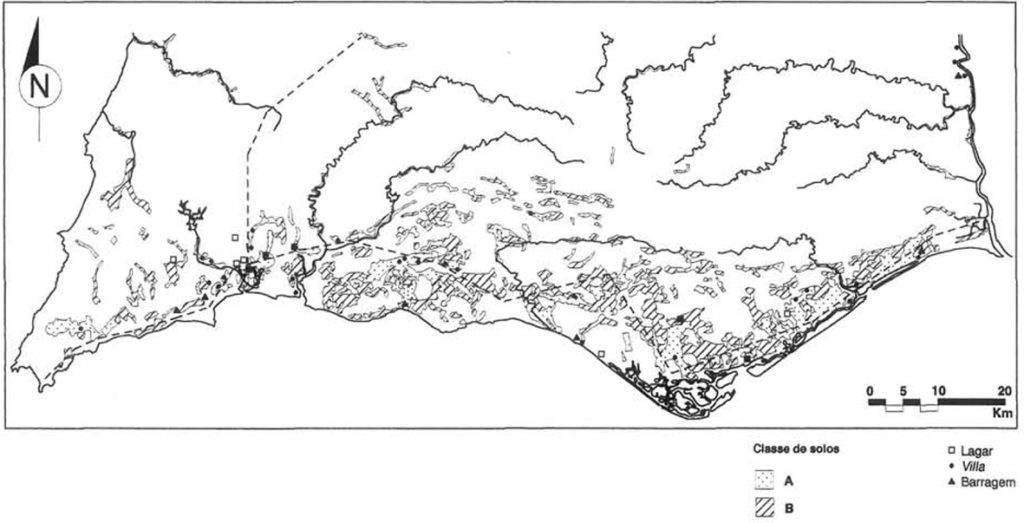
Nesta área foram identificadas estruturas de época romana em Portimão (7/117), junto do convento de S. Francisco (7/146) e em outros lugares das suas proximidades (fig. 4 e 5), mas nada que se possa relacionar com a presumida fundação bárcida. Recentemente, dragagens efetuadas no estuário do rio Arade revelaram a presença de abundantes materiais arqueológicos, entre os quais se destacam cerâmicas campanienses e ânforas do período tardo-republicano (Silva et alii, 1987) o que, convenhamos, embora interessante resulta insuficiente para uma identificação categórica.
Também este local forneceu vestígios de estruturas para a produção de preparados de peixe, nas duas margens do estuário: Portimões (7/117 e 7/146), na
margem direita, e Ferragudo (7/147), na margem esquerda. A montante, na margem
esquerda, foi recentemente identificado u, novo local com cetariae, o sítio Baralha 2 (594.4.6 – Marques, 1992) (fig. 4).
A admitirmos a implantação de um núcleo urbano no estuário do Arade, deveremos
considerá-lo em articulação como o outro centro urbano das margens deste rio: Cilpes.
Cilpes (7/112?)fig. 3
O Núcleo urbano de Cilpes deve localizar-se no Cerro da Rocha Branca, importante sitio arqueológico sobranceiro ao rio Arade, na sua margem direita, que infelizmente foi recentemente destruído. Antes das destruições, os arqueólogos Mário e Rosa Varela Gomes conseguiram identificar urna extensa ocupação humana, que parece remontar ao segundo quarto do I Milénio a.C. (Gomes, 1992: 136), prolongando-se até ao Baixo Imperio (Gomes et alii, 1986 e Gomes, 1988: 23-5). Num momento impreciso, mas talvez posterior ao século IV, o núcleo urbano transferiu-se para o local onde hoje se ergue a cidade de Silves (Gomes, 1988: 25). Esta transferência não implicou, porém, o abandono do núcleo anterior, como os dados arqueológicos demonstram (Gomes et alii, 1986).
De Cilpes conhecem-se, também, cunhagens do século I a.C., atestando a sua importância nesta época. Embora a sua implantação se pareça dever a proximidade de importantes jazidas mineiras, a sua localização permitia-lhe a exploração de recursos diversificados, tanto agropecuários como silvícolas, sem esquecer as potencialidades proporcionadas pela navegabilidade do rio (Gomes, 1988: 23-5).
Justamente no período muçulmano, quando a estratégia de habitat denota preferência por lugares recuados em relação ao litoral, mas com fácil acesso ao mar, a cidade de Silves, herdeira do antigo núcleo, viveu a sua época de maior esplendor.
Ipses (7/145) fig. 3
No lugar de Vila Velha, Alvor, na margem esquerda do amplo estuário da ribeira de Odiáxere, onde se tinham já registado achados de materiais de várias épocas e onde diversos autores localizavam, também, o Portus Hannibalis foram recentemente escavadas por Teresa Júdice Gamito diversas estruturas do período romano republicano. Entre os materiais recolhidos figuram duas tesserae de chumbo da cerca de Ipses, de que se conheciam já algumas moedas de bronze, datáveis do século I a.C. (Paria, 1987: 2 e 1988).
Partindo do pressuposto de que a moeda de chumbo não circularia fora da área da sua cunhagem, António Paria defende a localização de Ipses em Vila Velha. Teríamos, assim, um novo centro urbano no barlavento algarvio. Só a publicação dos resultados das escavações arqueológicas permitirá precisar as características do núcleo, bem como a cronologia da sua ocuparão.
Uma vez mais, regista-se a presenta de um complexo de cetariae nas suas imediações, mais concretamente na praia do Vau (7/111), na margem direita do estuário da ribeira (fig. 4).
Lacobriga (7/139-7/140 ?) fig. 3
Sobre Lacobriga temos, no estado atual dos nossos conhecimentos, um panorama análogo ao exposto para o Portus Hannibalis: conhecemos o local por referencias textuais, mas não existe outro tipo de informação que nos esclareça sobre a sua exata localização ou relevância regional.
Tradicionalmente, o antigo núcleo tem sido localizado ou no Monte Molião (7/139), na margem esquerda do estuário da ribeira de Bensafrim, também conhecida por rio de Lagos, ou sob a atual cidade de Lagos (7/140). No primeiro, foram recolhidos materiais de tipo ibero-púnico, designadamente lucernas (Viana et alii, 1953: Lám. IV), bem como materiais romanos alto-imperiais; e no segundo, foram identificadas diversas estruturas romanas associadas á exploração de recursos marinhos, com materiais de diferentes épocas, incluindo o Baixo-Império. Finalmente, em dragagens efetuadas no estuário do rio foram recolhidos materiais arqueológicos, dos quais os mais antigos remontam ao século I d.C.
Independentemente da exata localização da cidade de Lacobriga resulta evidente que também este estuário se encontrava povoado nas suas duas margens em época romana. Uma vez mais, regista-se a presenta de estruturas destinadas a transformação do pescado, tanto no subsolo de Lagos (7/140), como na vizinha praia da Senhora da Luz (7/141) (fig. 4).
O extremo Oeste do território algarvio, o Hiéron Akrotérion de Estrabão ou o Sacrum Promunturium dos autores latinos, embora fosse frequentado por motivos religiosos era inóspito e não possuía grandes núcleos populacionais, como refere o geógrafo grego (III, 1, 4). Não temos motivos para pensar que esta situação se tenha alterado durante o período do domínio romano.
O Povoamento Rural (fig. 5.)
A observação das diferentes «Cartas Arqueológicas do Algarve», desde o primeiro
esboço geral de Estácio da Veiga (1910), as recentes sínteses de Jorge Alarção (1988) e aos levantamentos promovidos pelo IPPAR (Passos, 1990 e Marques, 1992), passando pela de Maria Luísa Santos (1971-2) e pelas sectoriais de Helena Catarino (1988) e Varela Gomes e Tavares da Silva (1987), sugere a existência de um denso povoamento na época romana, disseminado por todo o território, com especial predileção pelo litoral e barrocal. Infelizmente, este amplo conhecimento dos pontos de povoamento não tem sido acompanhado de um esforço análogo de determinação das suas características e cronologias, pelo que nos vemos bastante limitados na sua interpretação. Como o presente estudo partiu das propostas específicas de Edmonson e Gorges, como atrás se referiu (0), importava, antes de mais, selecionar o conjunto de pontos que poderia ser enquadrado na classificação genérica de villae, nos moldes em que Gorges tipificou esta forma de povoamento (Gorges, 1979: ).
As Villae do Algarve
Por falta de melhores e mais seguros indicadores, optei por selecionar, de entre o conjunto de sítios arqueológicos com ocupação do período romano, todos aqueles onde se detetou a presença de mosaicos, fustes de colunas ou capitéis, indicadores da presenta em ambiente rural, de edifícios de carácter urbano. Foram excluídos os diversos locais cartografados que não apresentavam vestígios arquitetónicos relevantes. Este critério, naturalmente discutível, pareceu-me ser o único seguro, já que se me afigurava falaciosa a adoção de outros, designadamente o da presença de cerâmicas finas importadas. Se valorizasse este dado, estaria certamente a perpetuar vícios de recolha de informação e, eventualmente, a incluir nesta categoria sítios tão diversos, como necrópoles ou grandes povoados com capacidade para adquirir estes materiais, neste caso, facilitada pela proximidade do mar. Contudo, tenho consciência que terão ficado excluídos, por falta de melhor caracterização, alguns locais que poderão ter conhecido a implantação de villae, como por exemplo o sitio da Lezíria (8/264), nas proximidades de Baesuris, onde foi recolhido um abundante lote de cerâmicas finas (Armda/Dias, 1985).
Na cartografia das villae foram incluídas, ainda, duas outras realidades estreitamente relacionadas com o mundo rural; os vestígios de lagares e as barragens fig. 5).
No caso dos primeiros, infelizmente, só raras vezes está inequivocamente demonstrado o seu enquadramento no período romano, já que a maioria é documentada ou pela presença de pesos das prensas —na praia, junto a Loulé Velho (8/300) e em Aimadanin (594.2.1.)— ou pela presenta das estruturas escavadas na rocha —Vale do Marinho (7/102), Vidigal (7/98) e Fonte Velha (7/90)—, aparecidos, uns e as outras, junto de locais com ocupação romana. Quanto aos restantes, sem qualquer dúvida integrados em villae—D. Menga (8/314), Quinta de Marim (8/311), Milreu (8/304), Vale de Arrancada (7/114), Monte da Torre (7/103) e Abicada (7/107)—, desconhecemos a cronologia do seu funcionamento (fig. 5).
Quanto as barragens (fig. 5) (Quintela et alii, e Cardoso et alii, 1990), cuja associação a diferentes formas de povoamento parece, contudo, inquestionável, estão maioritariamente ligadas ao mundo rural: a do Alamo serve a villa do mesmo nome (8/225), a de S. Rita serviria a Quinta do Muro (8/282), a de Vale Tesnado o Cerro da Vila (8/298) e a da Fonte dos Mouros um dos centros do território de Cilpes (Cardoso et alii, 1990: 2.6.). As restantes, poderiam servir centros de produção de preparados de peixe: Armação de Pera (7/152) e a de Espiche {idem: 2.7.), talvez o centro da Senhora da Luz (7/141); e a da Fonte Coberta (7/138) eventualmente a própria cidade de Lacobriga (Alarcao, 1988: 183) o que pressupõe uma localização da mesma na margem direita da ribeira de Bensafrim, isto é, sob a atual Lagos.
A carta de distribuição apresentada defronta-se, todavia, com uma dificuldade de momento insuperável: a das cronologias de ocupação. A mera consulta da listagem do Anexo 3 esclarece cabalmente sobre a extensão do problema. De 36 sítios selecionados, dispomos de alguns indicadores cronológicos para 18, isto é, para metade, e somente na Quinta de Marim (8/311), Milreu (8/304), Cerro da Vila (8/298) e Abicada (7/107) se efetuaram extensas escavações no nosso sáculo, embora em nenhum dos casos se tenha verificado a sua publicação integral.
O esclarecimento desta situação é essencial para que se possa compreender como é frágil a leitura que aqui se apresenta, apesar do grande número de sítios considerado. Esta ausência de dados concretos, de elementos precisos de datação, para a maior parte dos casos, transforma esta carta num «palimpsesto» onde, provavelmente, se misturam momentos diversos de ocupação. Somente a título de exemplo, refira-se que incluí dois sítios como a villa da Senhora do Pilar (7/123), com um abundante lote de materiais do século I recolhidos a superfície, mas nada seguramente posterior, e a de Torrejáo Velho (596.3.8.), nas suas proximidades —não deve ser confundida com a sua homónima do concelho de Tavira (8/324)—, sobre a qual não possuímos nenhum indicador cronológico e que, por isso mesmo, pode ter começado a ser ocupada num momento em que a de Senhora do Pilar já fora abandonada…
Esclarecidas as limitações da presente abordagem, importa salientar algumas linhas de força que se podem considerar independentes de qualquer fator de ordem cronológica. Em primeiro lugar, resulta evidente a intenção de instalar estes estabelecimentos junto a solos de boa aptidão agrícola, particularmente os da Classe A, sendo notória a preferência pela plataforma litoral. A norma de relação entre solos das Classes A e B e a presença de vestígios de villae não se verifica apenas no caso do Monte da Torre (7/103). Parecem evidentes, também, as duas tendências enunciadas por J. G. Gorges (1990) para a sua localização, a saber, a proximidade dos centros urbanos —praticamente todas se localizam a uma distância inferior aos 20 km sugeridos pelo modelo de Van Thünen—, e a proximidade das principais vias, tanto as terrestres, visível pelo confronto com a proposta de J. Alarção (1988: 52 e 57-8), constante nas diversas cartas (fig. 3, 4 e 5), como a grande via fluvial que o Guadiana constituí neste particular, é notória a ocupação sistemática de pequenas manchas de solos agricultáveis, designadamente, em Alamo (8/255), Montinho das Laranjeiras (8/249) e Vale de Condes (Catarino, 1988: n- 3) aos quais haverá, provavelmente, que adicionar uma ocupação sob a atual Alcoutim (8/247) e outros núcleos de povoamento, que pontuam toda a margem direita deste rio (Alarcao, 1988: Folhas 8b e 8c). Desenquadrada destas duas tendências surge-nos apenas a villa de S. Margarida de Alte (7/80) claramente instalada no «barrocal», embora junto a solos das Classes A e
A sua localização pode ser simplesmente marginal, ou relacionar-se com algum ramal do sistema viário secundário, que estabeleceria a ligação entre o Algarve e a peneplanície alentejana, através da serra.
Pelas limitações já expostas, resulta fácil compreender como são escassas as possibilidades de, no estado atual dos conhecimentos, reconstituir o quadro da economia destas villae algarvias. No entanto, parece-me legítimo afirmar que a geografia da sua distribuição em nada difere da que verificamos para outras regiões da Lusitânia e somente pela valorizarão excessiva de alguns casos pontuais, claramente minoritários no panorama geral, se poderá justificar a tese de uma qualquer originalidade do povoamento rural desta região. A exploração dos recursos marinhos, sem dúvida uma importante atividade, assume um carácter suficientemente diferenciado, tanto na implantação dos seus centros, como nas características que os mesmos possuem.
Como facilmente se nota, foram excluídas da presente lista (anexo 3) muitas das tradicionalmente chamadas «villae» algarvias, particularmente as do extremo Oeste do território, Senhora da luz (7/141), Salema (7/131) ou Boca do Rio (7/132). Tal exclusão justifica-se pelo facto de todas elas se implantarem em áreas cujos solos não apresentam aptidões agrícolas. A desproporção entre a pobreza dos solos envolventes e a exuberância das suas construções, aliada a presenta, em todas elas, de estruturas de cetariae, sugere uma opção de exploração de recursos marinhos que, na minha opinião, nada tem a ver com o mundo rural. No entanto, se resulta evidente, para mim, que seria abusivo classificá-las como villae, já não estou tão certo sobre a designarão que deveremos dar-lhes…
Não se nega a existência de uma complementaridade entre recursos agrários e recursos marinhos, contudo, este fenómeno deve ser entendido mais numa perspetiva regional, do que propriamente no âmbito de um mesmo sitio com as possíveis exceções da Quinta do Muro (8/282), Quinta de Marim (8/311), Cerro da Vila (8/298) e Baralha 2 (594.4.6.), todos eles com vestígios de cetariae e implantados em zonas com boa aptidão agrícola.
Completando a paisagem rural algarvia, conhecem-se inúmeros aglomerados de menores dimensões, não enquadráveis, dentro do que se sabe, na categoria de villae, disseminados quer no litoral, quer no «barrocal» e, inclusivamente, na «serra», embora nos faltem informações precisas sobre esta última região, normalmente menos prospetada. Os dados de campo dos trabalhos de Victor S. Gonçalves e Helena Catarino demonstram, contudo, que esta última região não seria tão despovoada como tradicionalmente se supõe. Normalmente todos estes sítios estão, tal como as villae, implantados nas proximidades de pequenas manchas de solos das Classes A e B.
A Exploração dos Recursos Marinhos (fig. 4)
A região do Algarve teve na exploração dos recursos marinhos uma das suas mais importantes componentes económicas. De há longa data era sabida que no período romano tais recursos já eram amplamente explorados, sendo inclusivamente objeto de exportação. O registo arqueológico forneceu abundantes elementos aos investigadores, particularmente estruturas como cetariae, anzóis e fornos de ânforas (Santos, 1971-2; Alarcáo/Mayet, 1990). Por se tratar de uma região perfeitamente enquadrada na área mediterrânea peninsular, eventualmente relacionada com a cidade de Gades (Mantas, 199), e até dispormos de dados seguros, permanecerá de pé a hipótese de remontar a épocas pré-romanas o início da exploração deste tipo de recursos no litoral algarvio. No entanto, deve sublinhar-se que a informação disponível, como já foi referido (2.1), documenta sobretudo uma produção e exportação tardia, já do Baixo Imperio (v. anexos 1 e 2).
Ao longo do litoral encontram-se referenciados vinte e dois (22) locais onde se identificaram estruturas com cetariae, documentando de um modo inequívoco a enorme importância regional da exploração dos recursos marinhos. O mapa da sua distribuição merece alguns comentários. Em primeiro lugar, resulta estranha a sua ausência na foz do Guadiana e áreas adjacentes, ou seja, no território de Baesuris, tanto mais que se conhece nas proximidades daquele centro urbano uma olaria (8/292), que terá fabricado ânforas durante um extenso período de tempo, e que se encontra bem documentada a longa tradição suscitadas pelo assoreamento do estuário do Guadiana, atualmente agravadas pela proliferação de obras-públicas que, regra geral, não têm sido devidamente acompanhadas por arqueólogos.
Segue-se toda a extensão litoral hoje incluída na reserva natural da Ria Formosa, que envolve as antigás cidades de Balsa e Ossonoba. Aqui, embora sejam evidentes as grandes transformações ocorridas na orla costeira, conhecem-se diversos estabelecimentos com estruturas para transformar o pescado, quer nas proximidades imediatas das duas antigas cidades, quer nos seus arredores. Nesta zona encontramos também a maior concentrarão de fornos para o fabrico de ânforas até hoje identificados em terras algarvias. Pela sua implantação, parece evidente tratar-se de um bom exemplo daquilo que Edmonson definiu como produção de âmbito urbano, ou suburbano. Uma vez mais, as informações disponíveis não permitem determinar quando terá começado esta atividade. No entanto, os fornos minimamente conhecidos (8/318?, 8/*, 8/305 e 610.2.3) parecem ter laborado somente no Baixo Imperio, isto é, numa época não anterior aos inícios do século III e, fundamentalmente, no IV e, talvez, no V (v. Anexo 1).
Mais a Oeste encontramos um conjunto de três estabelecimentos, todos muito próximos entre si, nas imediações da atual vila de Quarteira, respetivamente, Loulé Velho *8/300), praia da Quarteira (8/299) e Cerro da Vila (8/298). Os dois primeiros, atualmente muito destruídos pela ação do mar, poderiam ter pertencido a um mesmo complexo de grandes dimensões, terão conhecido ocupações antigas, recolheram-se, tanto num como no outro, moedas de Carteia, embora os vestígios mais numerosos datem de época tardo-romana. O terceiro, somente com duas pequenas cetariae, corresponde a uma villa romana com uma ocupação que se poderá ter iniciado no séc. I ou II, embora se tenha prolongado até a época medieval. A sua localização, a cerca de 15 km de Ossonoba sugere que, também eles, pertenceriam a área de influencia imediata do antigo núcleo urbano.
Em todo a orla litoral que se estende desde Quarteira até a Foz do Arade regista-se um único estabelecimento com cetariae, o da praia de Armação de Pera (7/152). Esta rarefação de lugares utilizados para a implantação de estruturas deste tipo é compreensível, já que se trata de uma zona de arribas, com pequenas reentrâncias passíveis de utilização num regime de pesca artesanal, mas de dimensões modestas, ou seja, nada comparável como o que se verifica nos grandes centros de produção de preparados de peixe. Naturalmente, esta ausência de dados pode atribuir-se, em parte, a deficiências de prospeção, contudo, parece mais verosímil supor que a adversidade das condições geográficas justifique a sua ausência. O núcleo de Armação de Pera, uma vez mais, poderá associar-se ao conjunto de explorações da foz do Arade, já que dista da mesma apenas cerca de 12 km.
Na região compreendida entre o Arade e o rio de Lagos voltamos a encontrar uma concentração notória de estruturas consagradas á exploração dos recursos marinhos. Uma vez mais, parece significativa a associação entre estas e os centros urbanos, desde o núcleo de Ferragudo (7/147), o mais oriental, aos de Lagos (7/140) e Senhora da Luz (7/141). A concentração de outras formas de povoamento nesta mesma área parece também significativa. O facto de não conhecermos qualquer centro oleiro para produção de ânforas deverá dever-se somente aos acasos da prospeção, já que carece de fundamento a noticia de Beltran Lloris sobre uma produção de ânforas da Classe 19 (= Bel. lib) em Lagos (Beltrán Lloris, 1990: 224), e não parece credível que todos estes centros pudessem ser abastecidos pelas olarias da praia do Martinhal.
Finalmente, assume características peculiares a existência de uma concentração de estruturas com cetariae no extremo ocidental algarvio. A zona parece à partida pouco favorável a instalação deste tipo de equipamentos, já que, tal como a região compreendida entre a Quarteira e a foz do Arade apresenta um litoral com arribas altas e pequenas reentrâncias, que correspondem as desembocaduras de pequenas linhas de agua. Contudo, desde a praia do Burgau (7/143) até a do Beliche (7/159), praticamente todas as reentrâncias apresentam estabelecimentos deste tipo, inclusivamente, o pequeno ilhéu da Baleeira (7/l6l), em frente a praia do Martinhal (Gomes/Silva, 1987: 67-119)- Todo este conjunto parece especificamente orientado para a exploração em grande escala dos recursos marinhos, com o apoio de um importante núcleo oleiro de, pelo menos, quatro fornos, instalado na praia do Martinhal (7/l60). Esta atividade de produção e exportação de preparados de peixefuncionou aparentemente durante o século IV e V, visto que dispomos de um significativo terminus post quem, para a laboração do centro oleiro um fragmento de sigillata clara D, forma Hayes 6lA, encontrado sob a câmara de combustão do forno III, por sua vez selada pela entulheira de um dos outros fornos que continuou em laboração.
O conjunto de estruturas desta área corresponde precisamente a maior concentração de locais onde se supõe a existência de villae onde os preparados de peixe seriam explorados como complemento das atividades agrícolas. Contudo, como se referiu a inexistência de solos de aptidão agrícola na área torna pouco aceitável esta interpretação. Por outro lado, a suposta presença de villae é deduzida da existência de equipamentos urbanos associados as cetariae, designadamente edifícios termais na Senhora da Luz (7/14) e Boca do Rio (7/132). Tal dedução não parece aceitável, já que a estreita relação entre termas e estabelecimentos para a exploração de preparados de peixe é bem conhecida em outros locais, designadamente na Ilha do Pessegueiro, Sines (7/34), na Comenda, Setúbal (5/318) e Troia, Orándola (5/320), para citar apenas alguns casos da Lusitânia.
2.4. A Economia do Algarve sob a Domínio Romano
Com os dados atualmente disponíveis não é fácil tentar esboçar as características gerais da economia do território do Algarve sob o domínio romano. Contudo,
parece-nos possível tragar um primeiro quadro hipotético que, naturalmente, terá de ser devidamente testado por futuras investigações.
Em primeiro lugar parece evidente que as formas de povoamento enquadráveis na designação genérica de villae escolhem para a sua implantação as áreas onde existem terrenos da Classe A, de maior aptidão agrícola e, somente em casos excecionais —Baralha 2 (594.4.6), Cerro da Vila (8/298), Quinta de Marim (8/311), Loulé Velho (8/300) e, talvez, nos estabelecimentos dos arredores de Balsa— se encontra documentada uma associação entre explorações agrárias e estruturas destinadas ao processamento do pescado. Deve salientar-se, porém, que o único caso minimamente conhecido, o do Cerro da Vila, apresenta somente dois pequenos tanques, provavelmente destinados somente a uma produção para consumo local. Nos outros casos, não existem garantias mínimas de uma real associação entre as eventuais villae e as cetariae. De qualquer modo, em qualquer dos casos citados, existem potencialidades efetivas de exploração de recursos diversificados. Refira-se, ainda, que o facto de se terem identificado vestígios de tanques com revestimento de opus signinum não autoriza a sua classificação como cetariae, já que, por exemplo, os tanques da Abicada (7/107), pela sua localização não parecem destinados á produção de preparados de peixe, como tem sido sugerido.
A ausência de investigações sistemáticas impede-nos de avaliar com segurança o panorama da agricultura algarvia do período romano. Tendencialmente, seríamos levados a supor que a clássica tríade mediterrânea de cercais, azeite e vinho constituiria uma importante componente, sem esquecer, todavia, o peso que os hortícolas têm na alimentação e, no caso concreto do Algarve, a relevância que já poderiam ter os frutos, frescos ou secos.
Sobre os primeiros, estamos, à partida, fortemente limitados. Sobre a produção cerealífera, na época, nada sabemos. A existência de algumas estruturas de lagar, presumível ou seguramente romanos, parece indicar a produção de vinho e, eventualmente, de azeite. De entre estas estruturas, são seguramente romanos, os lagares de vinho de Abicada (7/107) (Viana et alii, 1953: 128-129), Vale da Arrancada (7/114) (Santos, 1972: 187-190), Mílreu (8/304), Quinta de Marim (8/311). Presumivelmente romanos e destinados á produção de azeite teriam sido os lagares de Loulé Velho (8/300), Dona Menga (8/314), Almada nim (594.2.1), Monte da Torre (7/103), todos eles identificados pela presenta de prensas (v. fig. 5).
Para lá destas informações, poderá ser pertinente o recurso a informações de períodos históricos mais recentes e o seu confronto com o registro arqueológico existente. Assim, resulta interessante verificar que a produtividade dos cercais no Algarve foi sempre extremadamente baixa, não faltando indicadores de privilégios para os importadores e menções a abastecimentos vindos do exterior, por não se conseguir obter localmente a quantidade necessária para prover as necessidades das populações (Marques, 1968: 145, Ribeiro, s/d: 84 e Balbi, 1822: 148).
Naturalmente, estes dados não autorizam a conclusão de que no período romano a produtividade das searas fosse insuficiente para as necessidades locais. No entanto, é de supor que as limitações pedológicas não permitissem um grande desafogo neste domínio.
A cultura da oliveira não se encontra amplamente disseminada, no Algarve (Ribeiro, 1979) e o azeite local é considerado de má qualidade desde há longa data, sendo a região tradicional importadora deste óleo vegetal (Balbi, 1822: 150 e Feio, 1983: 117).
Quando no século XIX se iniciou a nova era das conservas algarvias, uma vez mais, se recorrem a importação de azeite para a industria (Feio, 1986: 136). Embora não julgue lícito presumir pela importação de ânforas, que transportam determinado produto, a inexistência do mesmo no local de receção, já que outros fatores, como o consumo sumptuário ou a troca de ofertas, podem explicar estes intercâmbios, é interessante verificar que o registro arqueológico do Algarve apresenta diversos indícios de importação de azeite da Baetica e Norte de África no período romano em Torre de Aires (8/318), Quinta de Marim (8/311), Quinta do Lago (610.2.3), foz do Arade (Silva et alü, 1987), Cerro da Rocha Branca (7/112) (Gomes et alii, 1986) e Monte Moliáo (7/139). Pela abundancia e dispersão destas importações, bem como pelos dados conhecidos para outras épocas, sugere que, de facto, a região não seria particularmente rica neste produto.
Já o vinho parece ter tido uma diferente relevância. Ao contrario do que acontece com o azeite, o vinho algarvio é produto de há longa data celebrado e tradicionalmente exportado em outros períodos históricos (Balbi, 1822: 151, Ribeiro, s/d: 81 e ss. e Garcia, 1986: passim). O registro arqueológico das ânforas importadas, documenta a presença de contentores de vinho, provenientes da Península Itálica e da vizinha Beática, mas apenas para o período tardo-republicano e inícios do século I. Sublinhe-se, contudo, que não se conhecem vestígios de exportações do vinho algarvio para fora do seu território no período romano, já que todos os fornos de ânforas conhecidos parecem ter fabricado exclusivamente contentores para preparados piscícolas, com uma possível exceção, adiante referida (v. anexo 1).
Em contrapartida, a exploração de produtos hortícolas e frutos de pomar, as principais produções agrícolas locais, atestadas desde o período muçulmano (Coelho, 1972: 41, 55, 6l-2 e Ribeiro, s/d: passim e Garcia, 1986: passim) poderão mergulhar as suas raízes na organização de espago rural promovida pelos romanos.
De facto, se é difícil, á falta de dados arqueológicos determinar a extensão, ou mesmo a existência, de pomares, nesta época, mais interessante resulta verificar a existência de diversas barragens construídas no período romano em território algarvio (Quintela et alii, 1986 e Cardoso et alii, 1990). Aparecem regularmente distribuídas por todo o território (v. figura 5), desde o Alamo (8/255) até Espiche (Cardoso, et alii, 1990: 2.7.) e, se é certo que poderiam ter conhecido multiplas utilizações, desde o abastecimento de termas em âmbito rural, aos abastecimentos urbanos, forneciam, sem dúvida, importantes recursos para a agricultura de regadio.
No que diz respeito á exploração de frutos, não estamos melhor informados. Registe-se, porém, a presumida existência de uma produção algarvia de ânforas com fortes semelharas com a Classe 19 (= Beltran lib) cujo conteúdo se desconhece.
Como em outro local já se referiu (Fabião/Guerra, no prelo), é possível que estes contentores se destinassem ao transporte de conservas de frutos, designadamente azeitonas. No entanto, para não construir sobre base quase inexistentes, limito-me a sugerir a possibilidade de remontar ao período romano a exploração e exportação de conservas de frutos algarvios, hipótese a confirmar em futuras investigações.
Parece, portanto, aceitável supor que a paisagem rural algarvia no período romano não teria sido multo diferente da existente em tempos medievais que note-se, subsistiu até aos nossos dias.
A economia algarvia do período romano, tinha na exploração dos recursos marinhos uma importante componente, aparentemente sem relação direta com o mundo rural. A implantação das estruturas destinadas a produção de preparados de peixe não sugere qualquer intenção de exploração complementar de recursos agrícolas, visto que não foram, na generalidade, e salvo os poucos casos citados, instalados em áreas com terrenos de aptidão agrícola acessíveis, nem tampouco há qualquer indicador preciso da associação entre aquela e estas atividades.
Pelas limitações do registro arqueológico disponível (v. anexo 2), não é possível estabelecer um quadro cronológico para o funcionamento dos centros de produção de preparados de peixe, multo menos, para os seus ritmos de laboração.
Como já se referiu, é possível que a exploração destes recursos remonte a tempos pré-romanos, como acontece na área de Gades, ou a uma época imediatamente posterior á conquista, como sucede em Baelo. No entanto, deve sublinhar- se que não existe qualquer indicador que autorize estas suposições. Em termos mais concretos, seria possível fazer remontar a um qualquer momento do século I d.C., já que alguns dos sítios arqueológicos listados forneceram materiais desta época (v. anexo 2), embora a sua produção não se destinasse a exportação, visto que apenas um dos fornos de ânforas conhecidos, o de Olhos de S. Bartolomeu (8/292), tenha fabricado contentores neste período. A maior parte deles estava seguramente em atividade no Baixo Imperio, prolongando-se a sua utilização pelo século V e, talvez, o VI.
Combinando os pontos dados seguros fornecidos por estes locais e outros dados arqueológicos do Algarve, com a informação obtida nos diferentes fornos que produziram ânforas (anexo 1), verifica-se que a sua quase totalidade se enquadra cronologicamente no Baixo Imperio. Somente o(s) forno(s) de Olhos de S.Bartolomeu (8/292), precisamente o(s) mais próximo(s) da Baetica, parecem) ter iniciado a sua laboração ainda no Alto Imperio o que, naturalmente, suscita a incómoda questão de saber se estaremos a tratar globalmente, como se de um processo unitário se tratasse, realidades, afinal, diferentes. Na impossibilidade de responder cabalmente a esta interrogação, resta-nos percorrer outros caminhos.
Uma vez mais, como as limitações já expostas quando se referiram as questões relativas as importações de ânforas olearias e vinícolas, é interessante verificar que o território algarvio recebeu nos séculos I e II d.C. contentores de preparados de peixe da Baetica —presentes em Balsa (materiais em curso de publicação), Quinta do Lago (materiais recolhidos por Ana Margarida Arruda), foz do Arade (Silva et alii, 1987), foz do rio de Lagos (Santos, 1971: 116-119 e fig. 39)— e da própria província da Lusitânia, provavelmente do vale do Sado – talvez um exemplar em Balsa, outro na Quinta do Lago (Arruda/Fabião, 1990: 202) e na foz do Arade {SILVA et alii, 1987: 210-21A^. Embora não saibamos ainda qual a extensão e significado do fenómeno, verifica-se também uma apreciável importação de contentores de preparados de peixe da Baetica no interior alentejano, notória em Vipasca (materiais depositados no MSGP), nos sítios romanos de Castro Verde (Madeira, 1986), na villa de S. Cucufate, Beja, e sua área envolvente, onde chegam também as produções do vale do Sado (Alarcado et alii, 1990: 252-254). Parece significativo, por outro lado, que a villa da Vidigueira tenham chegado, embora em pequena quantidade ânforas tardias do Algarve (Alarcáo et alii, 1990: 253).
Face a estes dados, afigura-se possível avançar uma primeira hipótese sobre a produção e exportação dos preparados de peixe no extremo meridional do atual território português. Numa primeira fase, eventualmente datável dos séculos I e II d.C., na época em que a exportação dos recursos marinhos da Baetica dominava os diferentes mercados do Imperio, o Algarve poderá ter começado a explorar os mesmos recursos, embora, aparentemente, não os exportasse, com a eventual exceção da zona do estuário do Guadiana. Esta exceção não deixa de ser interessante, já que poderá sugerir uma influencia mais marcada de modos de vida béticos, no extremo oriental do Algarve. Num momento datável do século III e, seguramente, continuado no IV e V, pelo menos, a região terá intensificado a produção e, talvez, só então iniciado a sua exportação em moldes significativos, provavelmente tirando partido do declínio dos centros da Baetica e Norte de África (Ponsich, 1988). Assim, e ao contrario do que supôs Vasco Mantas (1990: 199) o que afetou Baelo e outros sítios costeiros da atual Andaluzia —quer tenham sido as correrias mouriscas, um abalo sísmico em outro qualquer fenómeno—poderá ter dado origem a um período de particular prosperidade para o Algarve.
Uma vez mais, como todas as reservas que a precaridade da informação disponível impõe, parece interessante verificar que a época tardo-romana nos apresenta esta região com uma apreciável circulação e entesouramento monetário, que contrasta fortemente com o panorama oferecido por épocas anteriores conhecem-se 9 tesouros dos fins do séc. IV ou inícios do V e em Loulé foi recolhida uma das poucas moedas de um imperador do século V no atual território português (Pereira et alii, 191 i: Cartas 18 e 21). A continuidade do enquadramento nas redes de intercâmbios mediterrâneas está igualmente atestada pelas importações de cerâmicas finas, como a «sigillata» fócense {= late Roman O, documentada na Quinta de Marim (8/311), Loulé Velho (8/300) e Cerro da Vila (Maia, 1978: 300-302 e Est. III).
Infelizmente, no estado atual dos nossos conhecimentos, não se afigura possível determinar quando se terá operado a rutura da geografia social e económica lentamente forjada pelo presenta romana no território algarvio. Todavia, há suficientes indícios que apontam uma sobrevivência, pelo menos em alguns sectores, para lá da desagregação do Império.
Deixando de parte as cidades, já sucintamente tratadas (2.1.), é interessante verificar que todas as grandes villae escavadas neste século —Abicada (7/107), Cerro da Vila (8/298), Milreu (8/304)— documentam uma persistência da ocupação que ultrapassa «crises» e «invasões», até a época muçulmana. Outros pontos de povoamento do mundo rural apresentam situações análogas, com sítios romanos e muçulmanos sobrepondo-se ou ocupando espaços próximos, o que, neste último caso, demonstra, no mínimo, uma descontinuidade de ocupação, mas uma identidade de motivos para a instalação. Temos de reconhecer que a amostra disponível não é muito extensa. No entanto, parece notável a homogeneidade verificada em todas as situações conhecidas. A dificuldade em determinar a malha do povoamento para o período compreendido entre os sáculos V e VIII terá que ver, fundamentalmente, com o grande desconhecimento que ainda temos das realidades arqueológicas destas épocas.
Os grandes centros de produção de preparados de peixe oferecem um panorama radicalmente diferente, já que a norma é a do abandono definitivo. Este, torna-se particularmente notório nos núcleos do Sudoeste, não só porque também foi um deles, a Boca do Rio (7/132), objeto de escavações neste século, mas também porque constituíam o grande Pólo produtor/exportador do Baixo Império, fora de âmbito urbano. Foi certamente a rutura da ampla rede de intercâmbios mediterrâneos, onde estes produtos estariam envolvidos, ocorrida algures entre o século V e o VII, que precipitou a sua decadência irreversível.
Teriam um carácter marcadamente especializado, impossível de converter a outras atividades. Também esta diferença de destinos sublinha a clara demarcação entre núcleos rurais e centros de exploração de recursos marinhos.
Durante o período romano, o atual território do Algarve explorava intensivamente diferentes recursos que, por serem complementares, Ilhe garantiam uma prosperidade particular. Na costa, centros de exploração de recursos marinhos ombreavam com sumptuosas villae, instaladas em manchas de bons solos agrícolas.
Provavelmente os mesmos proprietários controlariam uns e outros; é admissível que a mão-de-obra mobilizada para umas e outras atividades fosse, em boa parte, constituída pelos mesmos homens. Contudo, esta complementaridade tinha um carácter mais regional e não exatamente nos mesmos sítios. O barrocal e a serra forneceriam outros tantos artigos complementares.
Este bem sucedido modelo de povoamento, articulava-se com as suas regiões próximas da Baetica e da Mauritania Tingitana, igualmente integradas na diócesis Hispaniarum. Este enquadramento foi quebrado somente no século XIII, quando o reino de Portugal estabeleceu fronteira no Guadiana, ao mesmo tempo em que as diferenças religiosas separaram definitivamente as duas margens deste «pré-Mediterrâneo».
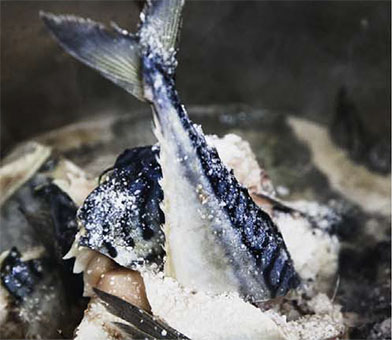
Ole G. Mouritsena* , Lars Duelundb, Ghislaine Callejaa, and Michael Bom Frøsta – Nordic Food Lab & Taste for Life, Section for Design and Consumer Behaviour, Department of Food Science, University of Copenhagen, Rolighedsvej 26, DK-1958 Frederiksberg C, Denmark
Lars Duelundb – MEMPHYS, University of Southern Denmark, 55 Campusvej, DK-5230 Odense M, Denmark
Keywords:
Fermentation
Fish sauce
Insects
Grasshopper
Wax moth
Pheasant
Peas
Umami
Glutamate
Aspartate: Amino acids
Nucleotides
http://dx.doi.org/10.1016/j.ijgfs.2017.05.002
Received 2 January 2017; Accepted 11 May 2017
⁎ Corresponding author.
E-mail address: ole.mouritsen@food.ku.dk (O.G. Mouritsen).
Fermentation of dairy products, legumes, fish, shellfish, molluscs, and meat are considered to lead to some of the most flavourful products in cuisines across the world. The deliciousness of these fermented products is to a large extent due to compounds like free amino acids and free nucleotides, formed during fermentation, which impart umami taste, often in a synergistic fashion. We have prepared fermented fish sauces based on mackerel, using procedures as in the ancient Roman cuisine, and used similar techniques to produce experimental fermented sauces from insects (moths and grasshoppers), game (pheasant), and pulses (peas). In some cases, the fermentation has been facilitated by fungal inoculation based on a Japanese koji mother. We have performed chemical analysis of these experimental fermentation products, together with a comparative analysis of a series of commercial fish sauces, with particular focus on free amino acids and free nucleotides in order to assess the umami potential of the various products. Whereas all of the 21 different investigated sauces are found to have high amounts of glutamate and aspartate, no significant amounts of free nucleotides are found in any of the samples. The investigated sauces were characterized by quantitative sensory evaluation. Although high in glutamate, umami synergy is not expected to play any significant role for the flavour of these fish, insect, game, and pea sauces. The sensory analysis shows a fairly good prediction of sensory properties from the chemical characterization of the sauces. However, the relationship between glutamate/aspartate concentration and intensity of umami taste is not simple. It demonstrates that in the complex solutions that constitute these sauces, there may be other perceptions that interfere with the main umami-tasting compounds.
Abbreviations: AA, amino acid; AAS, atomic absorption spectroscopy; AMP, adenosine-5′-monophosphate (adenylate); ANOVA, analysis of variance; A–PLSR, ANOVA–partial least squares regression; GMP, guanosine-5′-monophosphate (guanylate); HPLC-MS, high-pressure liquid chromatography mass spectrometry; IMP, inosine-5′-monophosphate (inosinate); MSA, monosodium aspartate (aspartate); MSG, monosodium glutamate (glutamate); PLSR, partial least squares regression; UMP, uridine-5′-monophosphate International Journal of Gastronomy and Food Science 9 (2017) 16–28
Available online 17 May 2017
1878-450X/ © 2017 Elsevier B.V.
Some of the most flavourful and highly appreciated foodstuffs in many cultures around the world owe their deliciousness to taste compounds developed during fermentation and ageing processes, either by use of yeast, bacteria, moulds, and enzymes or combinations hereof (Mouritsen and Styrbæk, 2014). Fermented products are often considered an integral part of a food culture (Katz, 2012). Well-known examples include fermented milk (cheeses, sour-milk products), fermented beans (soy sauce, miso, nattō, douchi, furu), fermented grapes, fruit, berries, and grains (wine, beer, cider, brandy, bread), fermented vegetables (sauerkraut, kimchi, tsukemono), fermented leaves (tea), fermented fish (katsuobushi, fish- and shellfish sauces, Swedish surströmming), and fermented meats (sausages, hams). In most cases, the liking of fermented foodstuff requires adaptation and in some cases it is an acquired taste.
In the classical culinary triangle proposed by Lévy-Strauss (1983), the raw foodstuff can be changed either by cooking (temperature) into edible foodstuff or by microbiological degradation into rotten and inedible stuff. ‘The ‘cooked’ and ‘the rotten’ then represent culture and nature, respectively. However, the borderline between ‘the cooked’ (prepared) and ‘the rotten’ is not sharp, and different cultures as well as cultures at different times have varying perceptions regarding what is considered edible and what is not. Moreover this ‘culinary borderland’ is a flexibly boundary that is constantly subject to negotiation and reinterpretation (Højlund et al., 2014). Manipulating and mastering fermentation processes is a way to navigate this borderland. As pointed out by Vilgis (2013), by considering fermentation and long-time cooking as a desirably way to degrade proteins and carbohydrates in prepared food, in much the same way as spontaneous degradation in undesirable putrefaction, the borderland between ‘the cooked’ and ‘the rotten’ tends to vanish.
Fermentation releases a range of flavourful taste compounds and aroma substances. Often a repulsive smell can overpower the desire to taste the fermented foodstuff. In many cases the fermentation processes produce a bounty of nutritional elements that are more easily digestible and provide for enhanced bioavailability in the gastrointestinal system. At the same time, properly conducted fermentation leads to preservation and prolonged lifetime of the prepared foodstuff, e.g., via dehydration or production of alcohol and lactic acid that suppress undesired fungal and bacterial growth as well as putrefaction.
In some cases, enzymatically facilitated low-temperature Maillard reactions during the fermentation may release additional flavourful browning products (Nursten, 2005), as is well known, e.g., from soy sauce and black garlic, although the process at low temperatures takes very long time.
The success of a fermentation process applied to foodstuffs is from the point of view of microbiology a delicate balance involving the risks of cross-contamination, wild fermentation outcompeting culturing, and growth of unwanted and potentially hazardous, poisonous fungal and bacterial cultures (Katz, 2012). Cultured fermentation typically requires good measures of cleanliness, temperature control, possible sterilization, and the use of starter cultures. High levels of salt (sodium chloride) and low pH are the most important parameters suppressing the growth of undesired microorganisms and leading way to the degradation of proteins, carbohydrates and nucleic acids.
There is a significant difference in the approaches used to ferment plant matter and meat from animals (Katz, 2012). Plants and foodstuff derived from plants contain large amounts of carbohydrates and sugars that are rapidly turned over by lactic bacteria and yeasts, producing alcohol and lactic acid, which suppress the growth of potentially hazardous bacteria and fungi. In contrast, meat and fish contain very little carbohydrates. Milk as an animal derived product is an exception that is readily susceptible to lactic fermentation. Fermentation of meat can be a risky business due to pathogenic microorganisms that may produce dangerous toxins, in particular when these organisms get access to the interior of the meat that in the living state is sterile.
Fermentation of meat therefore usually involves pre-treatment by salt and application of drying or smoking techniques. In the case of fish, halotolerant visceral enzymes along with various aerobic and anaerobic salt-loving bacteria are able to ferment the pre-treated flesh and prevent putrefying bacteria to get into action. In this case, it is basically a principle of establishing conditions that selects the desirable bacterial and fungal cultures.
Whereas there is a substantial literature about fermentation of plants and plant materials (Katz, 2012), meat (Ockerman and Basu, 2008), as well as fish (Lopetcharat et al., 2007), there is very little published in the scientific literature about insects and in particular fermented insects as foodstuff (van Huis et al., 2014). In the present paper we describe an experimental attempt to produce a gastronomically acceptable fermented sauce from grasshoppers and wax moth larvae and deliver some of the first chemical analysis of insects sauces, combined with the first detailed sensory analysis of them. In the context of the Western cuisine, the particular combination of fermentation and insects represent an ultimate example of the challenging and less edible corner of Lévy-Strauss’ culinary triangle.
In this paper we shall focus on the flavour of the fermented sauces, in particular from taste components derived from proteins and nucleic acids. Being large molecules, proteins and nucleic acids have no taste of their own since they cannot be detected by the taste receptors. Only when broken down into smaller constituents, in particular free amino acids and free nucleotides, respectively, can they stimulate appropriate taste receptors, such as the umami receptor (Mouritsen and Khandelia, 2012). In certain cases, small peptides can also elicit taste, e.g., kokumi taste by the tripeptide glutathione (Maruyama et al., 2012; Kuroda et al., 2012). During fermentation, the proteins and nucleic acids in the raw materials are subject to degradation, and large amounts of free amino acids and nucleotides can potentially be formed. However, the temporal evolution of the contents of these compounds is often highly complex and may be non-monotonic because the produced free nucleotides and amino acids may be consumed at a later stage in the fermentation process, which is the case in beer production. Similarly, high levels of free inosinate in fresh fish may be diminished by postmortem autolytic decay and vanish almost completely during fermentation of fish sauces leading way to less-well tasting compounds, such as inosine or hypoxanthine (Gill, 1990).
Free glutamate and free nucleotides, in particular inosinate, guanylate, and adenylate, enter a unique synergic relation due to an allosteric action on the T1R1/T1R3 umami receptor (Zhang et al., 2008; Mouritsen and Khandelia, 2012). Being highly non-linear, this synergy implies that small amounts of one component, e.g., inosinate, can enhance the sensory perception of glutamate manifold (Yamaguchi and Ninomiya, 2000). This pairing of food items is hence based on a scientific principle in contrast to the claimed food pairing principle based on chemical identity, a principle that proven to be based on culture rather than a scientific principle (Ahn et al., 2011). The proposal of umami as a fifth basic taste (Ikeda, 2002) was based on the finding of large amounts of free glutamate in the brown algae konbu used for production of the Japanese soup stock dashi (Ninomiya, 1998;
Yoshida, 1998). The synergetic action and the umami-pairing principle in traditional dashi are mediated by inosinate from a fish product, katsuobushi, and in vegetarian shōjin dashi by guanylate from dried shiitake. The umami-pairing principle behind the delicious flavour of dashi is the same that is operative in the well-known combinations of foodstuff in the Western cuisine, e.g., eggs-bacon, cheese-ham, and vegetables-meat (Mouritsen et al., 2012; Mouritsen and Styrbæk, 2014).
Only few types of foodstuffs, most prominently sun ripe tomatoes and nori (from the red macroalga species Pyropia spp.) can alone account for both components in umami synergy, and therefore at least two different ingredients are required. However in many cases, due to the non-linear synergetic action, one of the ingredients can be added in small amounts, e.g., a drop of fish sauce or soy sauce, a bit of anchovy paste, a stench of tomato paste, a crumble of Parmesan, or bit of blueskim cheese.
In principle one would have thought that fermented fish sauces could provide both glutamate and inosinate, because fresh fish like mackerel, anchovies, and sardines contain large amount of inosinate and the subsequent fermentation might produce plenty of glutamate.
However, inosinate is quickly broken down enzymatically soon after the fish is dead (Gill, 1990), and very special preparation techniques, e.g., as perfected in the production of katsuobushi (skipjack tuna) and niboshi (sardines), have to be invoked in order to conserve the inosinate. Alternatively the fish could be cooked, dried, and marinated immediately after catching (Maga, 1983), e.g., for producing anchovy paste. In both cases, however, the proteolytic enzymes that could produce glutamate during subsequent fermentation would be inactivated, rendering a product with only little free glutamate. Hence it appears that fermented fish sauces would foremost be glutamate providers.
Whereas there is a wide range of fermented molluscs (e.g., fermented squid) and shellfish (e.g., shrimp paste and original oyster sauce) sauces in Southeast Asia, fish sauces of various origins are undoubtedly some of the most prevalent popular fermented products in the world cuisine, not least in Asia (Lapsongphon et al., 2015). There is rich cultural history behind fermented fish and shellfish products and how they have developed into modern condiments like soy sauce, English sauce, and ketchup products that no longer contain fish (Mouritsen and Styrbæk, 2014). Although these modern products can contain large contents of free glutamate, traditional fish sauces generally dwarf them.
Seafood, it be fish, shellfish, molluscs, or seaweeds, are known to be good sources of umami-tasting compounds (Komata, 1990) and therefore also a good starting point for producing fermented sauces with a very high potential for umami. Fish is a natural and readily available source for producing fermented sauces (Lopetcharat et al., 2007) because fish contain aggressive endogenous enzymes, e.g., in viscera, such as proteases and nucleases that digest proteins and nucleic acids, respectively. The most important contributor to umami in fish sauces is free glutamate. The content of free glutamate can be very large, close to 1400 mg per 100 g in Japanese ishiri and the Vietnamese nuoc mam tom cha, or a little more than in soy sauce (Yoshida, 1998). In contrast, fish sauces seem to contain very little free nucleotides (Park et al., 2001, Funatsu, 2000a; b). Fish sauces are generally produced with high levels of salt, all the way up to 25%, which is considerably more than the 14–18% found in soy sauce (Yoshida, 1998). The combination of umami compounds and salt works synergistically to enhance the saltiness of fish sauce. The less salty fish sauces typically lead to more flavourful products, since the salt tends to limit the enzymatic activity (Lopetcharat et al., 2007). Similarly, the addition of soy sauce to different foods has been demonstrated to be able to reduce the total salt in some prepared foods with 17–50% without noticeable loss of saltiness (Goh et al., 2011; Kremer et al., 2009).
The outline of the remaining part of the paper is as follows. Since our experimentation with fermented sauces naturally writes itself into the grand tradition of ancient fish sauces, we first briefly review and revisit the tradition of the Roman fish sauce garum and offer a few comments about modern East Asian fish sauces for the sake of later comparison. We then describe our experiments with fermenting sauces of fish, insects, game, and peas, leaving technical details, methods of sensory evaluation, and recipes to the “Materials and Methods” section.
In the first “Result” section we present the result of the chemical analyses of the various fermented sauces, including a series of commercial fish sauces. In the second “Result” section, we describe the results of the sensory evaluation of the various sauces.
Penultimately, the results obtained are discussed in “Discussion” and some comments are offered regarding the gastronomic potential of the fermented sauces, specifically with respect to eliciting umami taste and how this correlates with the chemical composition. The paper is closed by “Conclusion” and “Discussion” sections.
Fermented sauces and pastes made from fish, shellfish, and molluscs, possibly more than 300 different types, are common and widespread throughout most of Southeast Asia. They are known by a number of different names, some of which are yu-lu (China), nuoc mam tom cha (Vietnam), nam-pla (Thailand), teuk trei (Cambodia), nam-pa (Laos), patis (Philippines), bakasang (Indonesia), ngan-pyaye (Myanmar), budu (Malaysia), and ishiri or shottsuru (Japan). These sauces are generally made according to the same basic method, involving the salting and fermenting of either whole fish and shellfish or parts thereof, including blood and innards. Fermentation is mediated by halotolerant enzymes found in the fish and shell fish as well as various salt-tolerating microorganisms, releasing an abundance of flavour compounds (Dougan and Howard, 1975; McIver et al., 1982; Funatsu et al., 2004; Lopetcharat et al., 2007). Some sauces are made with fresh fish, while others use dried fish. Anchovy is one of the most commonly used species. Sometimes the fish is combined with enzymatic active material from other species, e.g., Japanese ishiri is made from fermented sardines, other small fish, and the innards from squid.
Modern Thai fish sauce is fermented for up to 18 months, much longer than the Roman garum of antiquity, and it also has a considerably higher salt content. Fish sauces have come to be associated with some very traditional dishes. In Korea, chokkaru, made from fermented salted fish, shrimp, and molluscs, is added to that country ׳s best known dish, kimchi, which is fermented Napa cabbage sometimes mixed with other vegetables. Similarly, in Japan, ika no shiokara consists of small squid fermented using the enzymes from their own innards.
The Romans were very passionate about a salty, fermented fish sauce, called garum, and later also liquamen. It was used both as a salt seasoning and to add deliciousness—what we would now call umami taste. Classical Roman works on the culinary arts suggest that garum could be incorporated into just about any dish, even sweet soufflés.
Probably, however, it was most often mixed with something else, for example, with wine vinegar (oxygarum), with honey (meligarum), and with wine (oenogarum).
The etymology of the word garum is a bit of a mystery; it is derived from a fish known to the ancient Greeks as garos; Pliny the Elder includes it in his list of the fish found in the oceans, but without any further description. The sauce was made on the Aegean islands at least as early as the fifth century BCE, and eventually its production spread to many of the fishing towns all around the Mediterranean and the Black Sea region (Bekker-Nielsen, 2005). No sources describe exactly how it was made, only that it was made from fish and that it smelled horrible. While early writers sometimes characterize it as putrid, in other writings they express an enthusiastic fondness for the sauce, referring to its “very exquisite nature.”
It appears that the term ‘garum’ applied only to the brownish liquid that seeped out when small fish and fish intestines, especially those from mackerel and tuna, were salted, crushed, and fermented. Fish sauces were traditionally prepared by mixing salt (up to 25 w/w %) and whole fish and placing the mixture in a warm place for 3–12 months.
The most valuable garum was made from the blood and salted innards of fresh mackerels that were fermented for two months. A lower quality sauce, muria, was made from the briny liquid drawn out when tuna was preserved in salt. Fermentation of garum took place outside in the dry heat. Garum may have been mixed with olive oil at the dinner table to make what we would now think of as a vinaigrette dressing.
Some of the Roman writers thought, erroneously, that garum is the liquid that is formed when fish rots, due to bacterial decomposition (Grainger, 2010). In fact, it is rather the result of fermentation, in which salt and the enzymes of the fish itself cause it to break down. For this process, the innards of the fish are very important, since the intestines contain large quantities of proteolytic enzymes that work break down the proteins in the fish. The fermentation process is accelerated by using salt that draws out the liquid from the fish and furthermore suppresses the growth of bacteria. Some authors believe that garum was not a primary product but a by-product from the salting of fish (Marzano, 2013).
It seems that there were local variations as to which types of fish and what parts of them were used and in what proportions. The sauce could contain large amounts of fish, especially if it was made from small anchovies, which almost liquefy under fermentation. It is possible that garum was made with blood and liquamen with whole fish. Even though the paste-like dregs, called allec, that were left behind when the liquid was skimmed off were malodorous, the garum itself appears to have had a mild, pleasant taste (Grocock and Grainger, 2006).
The garum trade reached its peak from the second to the fourth centuries CE, but garum never lost its appeal in the Mediterranean region, where it was used throughout the Middle Ages and Renaissance. It has survived to this day in the form of salted anchovies and anchovy paste, both of which have a cleaner taste because the innards are removed from the fish before they are processed. Some small companies in Italy and Spain have recently sprung up and are producing fish sauces based on ancient recipes for garum production.
Making a true garum is a slow process. But there is a shortcut, which survived from a Greek source about agriculture (Geoponica) compiled in the tenth century CE from even older works (Dalby, 2011).
In it there is a recipe for a sort of quick-and-easy garum for the benefit of “the busy Roman housewife.” This recipe calls for cooking salted fish and innards for about two hours. As it is made without any fermentation, it is milder than traditional garum and imparts much less umami.
We have produced such a fish sauce and analysed it in the present paper.
Even though there is evidence that the ancient Greeks and Romans used garum as a fish sauce more than 2500 years ago, we probably have to look to food cultures of the East, and especially to those in China, to find the origins of contemporary fish sauces. It was mostly the Chinese living in the coastal areas who made fish sauce, probably by combining small fish with the innards from larger cooking fish, causing fermentation.
Once soybeans were added to the salted and fermented fish in order to stretch the ingredients further, the liquid started to evolve into what would later become soy sauce, which came to be used much more widely, particularly inland.
The different varieties of fish sauces now made in Southeast Asia—for example, oyster sauce (which however is not a fermented product but an oyster extract)—all contain large quantities of glutamate and can be seen as counterparts to the Roman garum.
Interestingly, in contrast to such other taste additives as anchovy paste and certain original Asian fish extracts, fish sauce has no significant content of free 5′-ribonucleotides. In ancient Japan, a concentrated fish extract, irori or katsuo-irori, was produced by reducing to a paste the liquid in which bonito (a.k.a. skipjack tuna, in Japanese katsuo) had been cooked, using the same techniques as those now used to make katsuobushi. Katsuobushi is the component of classical Japanese dashi that contributes the 5′-ribonucleotides that interact synergistically with the glutamate from konbu to impart a strong umami taste. As katsuobushi dates back only to the 1600s, it is a much newer arrival on the culinary scene than irori.
Although irori disappeared from Japanese cuisine during the Meiji era (1867–1912) and is no longer on the market, a similar product, senji, is still made on the island of Kyushu in the southern part of Japan. When produced according to the traditional recipe, senji contains 900 mg of glutamate per 100 g and no less than 786 mg of inosinate per 100 g (Yoshida, 1998). Comparably high levels of inosinate are found in another traditional fish extract, rihakuru, from the Maldives. Both of these sauces are much richer in inosinate than katsuobushi, which has only about 474 mg per 100 g (Ninomiya, 1998).
Commercial fish sauces were purchased either in retail stores or directly from the producers.
Fresh mackerel (Scomber scombrus) was purchased from Albanifisk (Kerteminde, Denmark).
Wax moth larvae (Galleria mellonella) and grasshoppers (Locusta migratoria) were obtained from Avifauna, Krusaa, Denmark.
Pheasant (Phasianus colchicus) was obtained from a hunting friend of the Nordic Food Lab.
Split yellow peas (Pisum sativum) were obtained of the brand Møllerens (Valsemøllen, Esbjerg, Denmark).
Koji based on homegrown koji-kin, was originally obtained from a Japanese producer, but perpetuated at Nordic Food Lab since the fall of 2011.
Organic pearled barley for koji was obtained from Condi (Albertslund, Denmark).
Salt used for salting was either sea salt or ordinary household salt.
The acetonitrile was obtained from Fischer scientific (Roskilde, Denmark).
All other solvent and salts used for chemical analysis were from Sigma-Aldrich (St. Luis, MO).
The water used for chemical analysis was ultra-pure water obtained from a MilliQ-Integral 5 water purification unit (Merck-Millipore, Billerica, MA).
Preparation of barley koji proceeded by a protocol developed at Nordic Food Lab.
1. Soak pearled barley overnight.
2. The next morning, turn on koji chamber (upright fridge turned off and fitted with heating mat and temperature probe connected to PID controller) to 30 °C.
3. Steam barley (100 °C) for 90 min in a perforated gastro tray.
4. Remove barley from oven. While it cools, blitz koji-kin in thermomix to a fine powder (~20 g koji-kin /1 kg cooked barley).
5. Once the barley has cooled to a comfortable temperature (~60 °C), sanitize hands with alcohol, use don gloves, and break up chunks thoroughly. Pour or scoop the barley into standard full-size gastros to a depth of about 2 cm.
6. Prepare a warm, damp, wrung-out cloth to cover the koji.
7. When the barley has reached 35 °C, inoculate it with the powdered koji-kin and mix thoroughly to coat every grain. Smooth out the barley and cover it with the damp cloth.
8. Place the tray into the koji chamber (time T+0). Fill from the top racks down, to make use of the most heat. Place the temperature probe into the barley itself to keep track of the internal temperature; this is crucial to not letting it overheat. Put it in the koji on the uppermost shelf, as it is in the warmest part of the chamber. Close door.
9. At T+18 h, remove the tray and turn the koji over to aerate and redistribute spores. Redampen the cloth, cover, and return the tray to the chamber. Nestle the probe into the top shelf koji, and close the door.
10. At T+24 h, turn koji again. It should start to smell fruity and fragrant. This time, create two furrows in the koji lengthwise with hands; the furrows should be as deep as possible without being able to see the metal pan through the grains. Return the koji to the chamber with a newly dampened cloth. Nestle the probe into the top shelf koji. This time, keep the chamber door open a crack to prevent overheating.
11. At T+30 h, turn the koji a final time, again with furrows. Redampen the cloth and return the koji to the chamber. Nestle the probe into the top shelf koji with the door slightly cracked.
12. Monitor the temperature carefully over the next 18 h; it should stay as close to 30 °C as possible, and not much higher.
13. At T+36, the Aspergillus oryzae mycelia will have permeated the grains and they will hold together in a spongy white cake.
14. If using koji for further fermentation, use it while it is still white. If saving koji as koji-kin, let the Aspergillus oryzae continue to develop until it begins to sporulate and turn green. Once it turns green, break it up in the gastro and let it dry slowly, on top of the oven or somewhere warm and dry. Once it is completely dry, store it for future koji inoculation.
This recipe is adapted from an ancient Greek source about agriculture (Geoponica) compiled in the tenth century CE from even older works (Dalby, 2011).
2000 g very fresh mackerels
1 L water
400 g salt sprigs fresh oregano
1. Cut the whole mackerels, innards and all, into smaller pieces and put them in a pot together with the water, salt, and some oregano.
2. Bring the water to a boil, turn the heat to low, and allow the fish to simmer for about 2 h.
3. Strain out the liquid, first in a sieve or colander to remove the large pieces and then through cheesecloth to ensure that the liquid is completely clear.
4. Store the finished sauce in the refrigerator in a bottle with a stopper
Three different approaches, B1, B2, and B3, have been used, basically using different parts of fresh mackerel as a source. B3 furthermore uses a barley koji for enzymatic fermentation. B4 was originally an experimental fish sauce and is now available as a commercial product with the trade name Flor-de-Garum.
For the sake of completeness we provide two versions of the recipe. One that we have used in the laboratory under controlled conditions and another one (kitchen version) that requires warm outside summer conditions.
3 kg very fresh mackerels (one whole mackerel and head, bones, entrails of four mackerel)
450 g salt (15% salt)
Lab version.
1. Cut the whole mackerels, innards and all, into smaller pieces and place them in a container.
2. Mix in the salt.
3. Cover the container with a loose-fitting lid and place it in a thermostat cabinet at 28 °C for several months. For purpose of analysis, samples have been drawn from the container with certain intervals and subsequently been sterilized and stored at −20 °C before analysis. Before analysis, the samples are thawed and filtered.
Kitchen version (Mouritsen and Styrbæk, 2014).
1. Cut the whole mackerels, innards and all, into smaller pieces and place them in a crock.
2. Mix in the salt, cover the crock with a loose-fitting lid, and place it outside where it is warm, preferably in the sun.
3. Allow the fish to ferment for a couple of months, turning the fish pieces in the salt once in a while.
4. Strain out the liquid, first in a sieve or colander to remove the large pieces and then through cheesecloth to ensure that the liquid is completely clear.
5. Store the finished sauce in the refrigerator in a bottle with a stopper.
For this recipe, one can also use just the entrails and blood from mackerels as in B2.
Same as the kitchen version B1 based on mackerel, but with the use of only blood, gills, and entrails.
The sample analysed was kindly prepared by Søren Mørch.
The procedure to produce fish sauce using koji is the same as described below for insects, yellow peas, and pheasant.
This garum is an experimental product provided by Jacob Sørensen (Thyborøn, Denmark). It is based on whole, very freshly caught smelt in a mixture with 25% salt. The sauce develops over a period of 12 months (B4) and 18 months (B5) at a temperature of 27 °C.
This garum was developed based on an ancient Pompeii recipe using anchovies, first as an experimental product and now available as a commercial product with label Flor-de-Garum (Vargas et al., 2014).
The analysis was performed on the experimental version.
At Nordic Food Lab we have adopted and adapted central parts of the traditional procedure for making soy sauce for other fermentation purposes in order to obtain umami-rich sauces (Evans, 2013). The recipes for different sauces follow the same general process, with some minor modifications between different raw materials. The agent of transformation used for the fermentation is Aspergillus oryzae that is grown using pearl barley as substrate. Cooked pearl barley is inoculated with our house culture of koji (vegetative Aspergillus oryzae moulds) that has been cultured for more than 6 years. The inoculated barley is kept at around 30 °C for 30–36 h, at which point the mold will have completely overgrown the barley. Precise instructions are given above.
The active koji is subsequently mixed with various protein-containing ingredients and salt to a level higher than 10% salt in the finished solution.
The general procedure adopted for making garums using koji is the same for fish, yellow peas, and pheasant.
1000 g raw material
300 g water
240 g salt
250 g barley koji
1. Blend the raw materials with water and salt until it is broken up as a puree but not smooth.
2. Mix the blend with the koji.
3. Place the mixture in glass containers with cling film over surface in order to keep out oxygen.
4. Incubate at 40 °C for at least 10 weeks.
5. Taste the sauce. If deemed ready, filter it through filter paper in a chinois, bottle the liquid, and pasteurize it at 72 °C for 15 s
For pheasant garum, use 500g of barley koji instead of 250g. For yellow peas, boil the peas until tender and cool down before mixing with koji. Extra virgin grasshopper garum is the first fractioning of the broken down garum that is produced by only using gravity to separate the solid parts from the sauce.
The paste remaining from drainage of the fermented pea sauce is a product related to miso, and has hence been called peaso.
Physico-chemical analysis
The total osmolarity was measured on a Gonotec osmomat 030 (Gonotec GmbH, Berlin). Samples were diluted as required with ultrapure water before analysis. The pH was measured on the un-treated samples with an Eutech pH510 pH-meter (Eutech Instruments Pte Ltd, Singapore) equipped with a VWR Universal pH electrode (VWR, Herlev, Danmark).
Amino acid analysis
Detection and quantification of free amino acids were performed by HPLC-MS using a Shimadzu LCMS 2020 MS equipped with an electrospray interface (ESI). The HPLC consisted of a DGU20-A5 inline degasser, two LC-20 AD pumps, a high-pressure mixer, an SIL20AHT autosampler, a CTO 10 Column oven, and an SPD-20A UV detector, all from Shimadzu (Holm & Halby Brøndby, Denmark).
Separation of the 17 different free amino acids was performed on an Imtak Intrada amino acid column (Imtakt Corporation, Kyoto, Japan) by gradient of acetonitrile with 0.1% formic acid and 100 mM NH4HCO2, in 21 min. The gradient consisted of first 3 min with 14% NH4HCO2 followed by an increase of the NH4HCO2 to 100% during the next 7 min. This level was maintained for 2 min, whereafter it was returned to 14% in 2 min and then allowed to re-equilibrate for the rest of the time.
Individual AAs were detected by selected ion monitoring (SIM) at appropriate m/Z values and were quantified by comparison with a standard curve prepared from commercial an available amino acid standard from Sigma-Aldrich. All samples were diluted 50 times with 0.1 M HCl and filtered through a 0.2 μm PTFE syringe filter before analysis. Due to their similar mass, Ile and Leu are difficult to separate in some samples and we have therefore for convenience only measured their sum. Cystine is measured as a dimer Cys2 but all data reported labelled by Cys2 have been renormalized to monomer concentration.
Nucleotide analysis
The four different free nucleotides, AMP, IMP, GMP, and UMP, were measured by HPLC-MS. The used LMS was the same as used for amino acids analysis but the analytes were separated on a Waters XBridge amide 100 mm x 3 mm HILIC column (Waters, Hedehusene, Denmark) by a gradient of acetonitrile and 10 mM ammonium formate at pH=3. The gradient consisted of first 2.5 min with 15% 10 mM ammonium formate, followed by an increase to 70% 10 mM ammonium formate during the next 20 min. This level was maintained for 2 min and subsequently lowered to 15% again in the next 5 min, and then kept at that value for 5 min. The nucleotides were detected in positive mode at appropriate m/Z values and quantified by comparison with standard curves obtained from the pure nucleotides. All samples were diluted 4 times with phosphate buffer (50 mM, pH=7.2) and filtered through a 0.2 μm PTFE syringe filter before analysis.
Total protein
Total protein was measured by a Bradford assay (Bradford, 1976).
The Bradford reagent was obtained from Sigma-Aldrich and the assay was performed as described by the manufacturer by mixing the appropriate amount of sample and Bradford reagent in a 96 well plate flowed by measuring the absorbance at 595 nm. Absorbance was measured in a BMG Fluostar plate reader (BMG Labtech, Ortenberg, Germany). All samples were diluted as needed with ultra-pure water before analysis.
Sodium and potassium analysis
Sodium and potassium contents were determined by flame AAS on a Shimadzu AA7000 spectrometer equipped with an ASC-7000 autosampler (Holm & Halby Brøndby, Denmark). Samples were diluted 1000 times with 1 M HNO3 of trace-metal grade (Normatom, VWR) before analysis.
The samples were analysed in the so-called microsampling method, by which 60 μL of the sample is injected into the flame and then quantified by obtaining the area of the obtained absorbance peak. The concentrations were calculated from at standard curve obtained from the analysis of a commercial standard (Traceselect, Sigma Aldrich).
Chloride analysis
Chloride concentrations were determined by a miniaturized mercury thiocyanate- Iron(III) nitrate assay in a 96 well half area microplate (Greiner Bio One, Frickenhausen, Germany) as described by Merchant (2009). In short, a solution of Hg(SCN) in methanol is mixed with an aqueous solution of Fe(NO3)3 and the sample in an appropriate ratio. The concentration of chloride is then determined from the absorption of the formed iron thiocyanate complex. Absorption values were obtained at 408 nm in a BMG Fluostar plate reader. Note that this method has a rather large uncertainty due to the low volume method that was chosen for safety reasons.
Sensory evaluation
Initially, potentially panellists were screened for their sensitivity to monosodium glutamate (ISO: 3972:2011, 2011). The purpose was to ascertain that they could perceive the compound, and understand the sensory descriptor. The training consisted of two stages. The first stage was a descriptor-development session (2 h). In the descriptor-development session, the panellists came up with all the descriptors they could think of to describe the products. The panel leader chose the descriptors to use for the training based on consensus among the panellists. In the second stage (3 sessions of 1ó−2 h) the panellists were trained for the assessment of the fish sauces. In each session a subset of the samples presented in the evaluations were used. Fourteen descriptors were chosen for the final evaluation; see Table 4. These included descriptors for aroma, flavour, mouthfeel, and taste.
The descriptive sensory study was conducted with 9 paid external panellists in four sessions. In each session, 12 or 13 samples were served (i.e., a total of three sensory replicates). The training and the sensory evaluations were carried out in a sensory facility, with panellists seated at individual tables and not disturbing each other during tastings.
Statistical analysis of sensory data
Data from the descriptive analysis was analysed by analysis of variance (ANOVA) and multivariate data analysis (ANOVA–partial least squares regression (A–PLSR)). Mixed model ANOVA for individual descriptors was performed with products (n=17) as fixed factors and panellists (n=9) as random factors. This method is commonly applied to data from descriptive analysis (Naes et al., 1998). ANOVA– PLSR (A-PLSR) is a multivariate regression method where the effect of design factors on the response variables (here, the chemical and sensory descriptors, respectively) is evaluated (Martens and Næs, 1989; Martens and Martens, 2001). The method avoids multi-collinearity problems by modelling latent variables representing the main variance common for the variables. The method evaluates effects of the experimental design variables on chemical characterisations and sensory properties. Here it is used as a graphical alternative to ANOVA. Mean ratings over panellists from each replicate were used for A–PLSR. For multivariate analyses, cross-validation was performed, leaving out one sensory replicate at a time (Martens and Næs, 1989). Jack-knifing with replicates served as the validation tool for all multivariate analysis, comparing the perturbed model parameter estimates from cross-validation with the estimates for the full model (Martens and Martens, 2000).
The relationship between chemical characteristics and sensory properties of the fish sauces is analysed by PLSR regression carried out on mean data. For chemical measurements mean data are means over replicates of measurements (3–4 replicates unless otherwise stated). For sensory data mean, data are means over panellists (N=9) and replicates (n=3).

Fig. 1. Traditional garum made from whole fresh mackerel. (a) Freshly cut whole mackerel mixed with salt. (b) Fermented mackerel after 3 months at 28 °C. (c) Filtered garum sample from the fermentation experiment in (b).
An illustration of stages of the production of an experimental fish sauce based on fresh mackerel is shown in Fig. 1.
The results of the chemical analysis of the different fish sauces are presented in Table 2 (free amino acids and total protein) and Table 3 (Na, K, Cl, pH, and osmolarity). No data are presented from the nucleotide analysis since for none of the fish sauces are we able to detect any amount of free nucleotides (AMP, GMP, IMP, UMP) within the detection limit (0.0005 mg/100 mL).
In order later to evaluate the umami potential, we have in Table 1 listed the Glu contents in groups of fish, insects, pulses, and game. It can be difficult to compare numbers for the different products not knowing the details of the way they are prepared, in particular whether the commercial sauces have been adjusted in taste by dilution by water.
However, it is clear that they all, except the quick-and-easy non fermented garum, contain substantial amounts of free glutamate. From det data for the experimental fish sauces B4 and B5 we observe, that the fish sauces with the longer fermentation periods contain more glutamate. The two most traditional European garums, Flor-de-Garum and Delfino, made respectively on anchovies and sardines, are clear outliers with very high levels of glutamate.
It also appears that garums made on anchovies, sardines, and sprats contain more glutamate than those produced from mackerel. Moreover, the mackerel garum made on blood, gill, and entrails have more glutamate than those based on whole fish.
The fermented sauces made on insects, yellow peas, and pheasant have glutamate levels compared to those fish sauces with the smallest levels.
The level of acidity for the sauces listed in Table 3 lies typically in the range 4.5 < pH < 5.5 which is similar to what is found in other studies of fish sauces (McIver et al., 1982). The salt concentration is dominated by sodium.
In order to clarify whether the different fish sauces are statistically different from the point of view of their combined chemical and physic chemical characteristics, an ANOVA analysis of the data in Tables 2, 3 is carried out. In the bottom of the two tables p-values and CI95% ranges show that all variables except tyrosine concentration contributed to separate the samples statistically. Therefore we can conclude that each sauce is unique in the sense it is statistically significantly different from all the other sauces investigated.
We have carried out an A-PLSR in order to obtain a lower dimensional representation of the main differences in the different sauces. Fig. 2 gives a graphical representation of the first two dimensions of this analysis, showing the largest (dimension 1, 49% of the total variance) and second-largest (dimension 2, 10% of the total variance) part of the variance in the physico-chemical data. It is a correlation loading bi-plot, showing both the distribution of the sauces and the interrelationship between the chemical variables. From here an overview of the interrelationships between the samples is obtained.
Clustering of similar sauces can be observed. The NFL-family using koji in the fermentation forms such a cluster. The two traditional European garums, Flor-de-Garum and Delfino, are very different from most of the other sauces. Going from left to right in the bi-plot, there is increasing concentration of Na, Cl, and amino acids. His appears in the lower part and Cys2 in the upper part of bi-plot. Sauces with high protein content are found in the lower part and appear to be uncorrelated to the amino acid concentration.
List of fermented products investigated. 1–3 samples of each product were subjected to physico-chemical analysis.
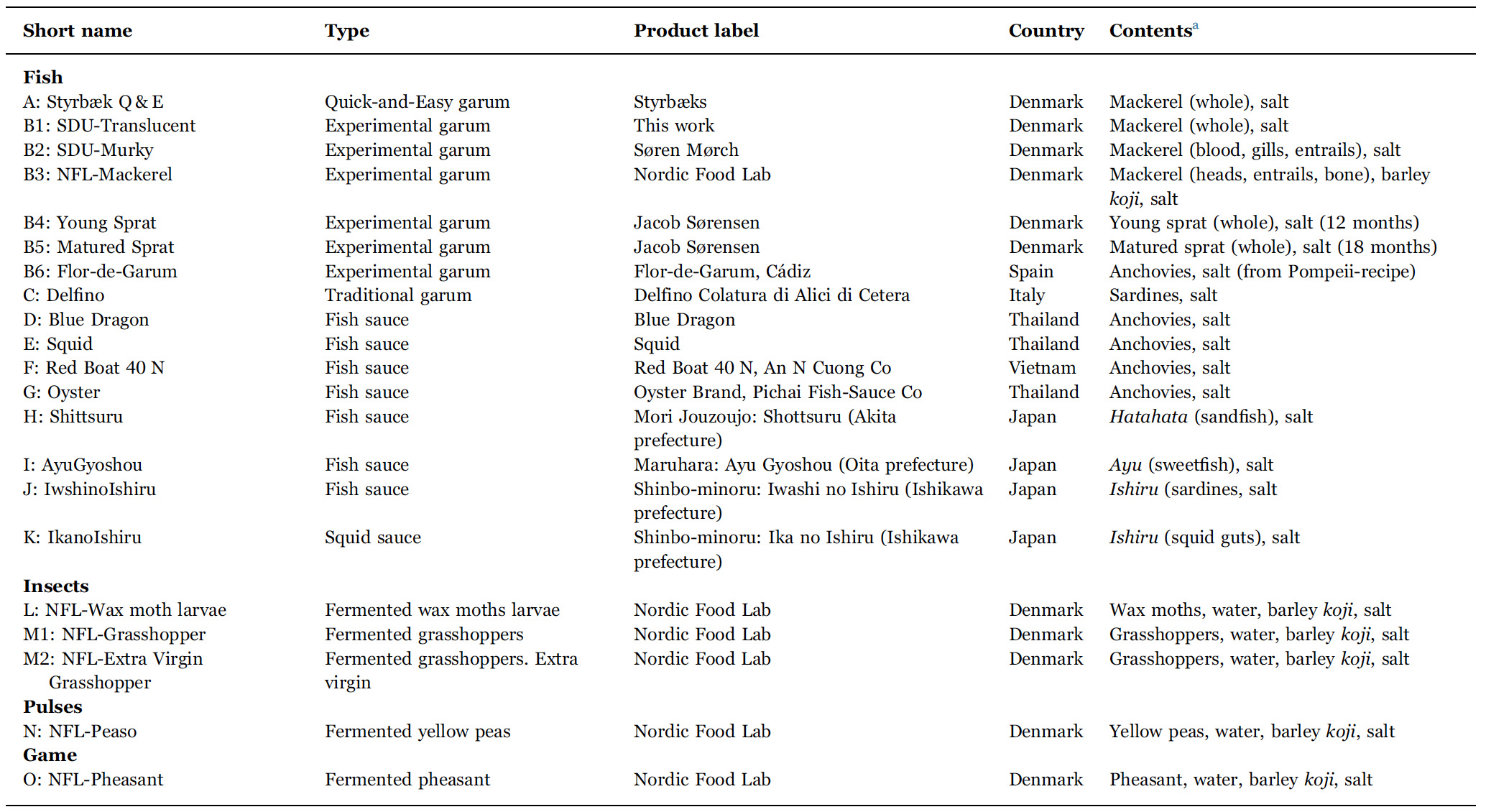
a Mackerel (Scomber scombrus), sprat (Sprattus sprattus) anchovy (Engraulis encrasicolus), sandfish (Arctoscopus japonicus), sweetfish (Plecoglossus altivelis), sardine (Sardina pilchardus), squid (species not declared by producer), wax moth (Galleria mellonella), grasshopper (Locusta migratoria) split yellow peas (Pisum sativum), and pheasant (Phasianus colchicus).
Contents of free amino acids (in units mg/100 mL) and total protein (in units g/L) in the fermented sauces listed in Table 1. n is the number of samples entering the mean value quoted. p-values and 95% confidence intervals (CI95%) are from ANOVA. Confidence intervals vary, as some samples are analysed in triplicates and other in quadruplicates. Ala: alanine; Arg: arginine; Asn: asparagine; Asp: aspartic acid (aspartate); Cys: cysteine, Gln: glutamine; Glu: glutamic acid (glutamate); Gly: glycine; His: histidine; Ile+Leu: isoleucine+leucine; Lys: lysine; Met: methionine; Phe: phenylalanine; Pro: proline; Ser: serine; Thr: threonine; Trp: tryptophan; Tyr: tyrosine; Val: valine. Due to their similar mass, Ile and Leu are difficult to separate in some samples and we have therefore for convenience presented their sum.
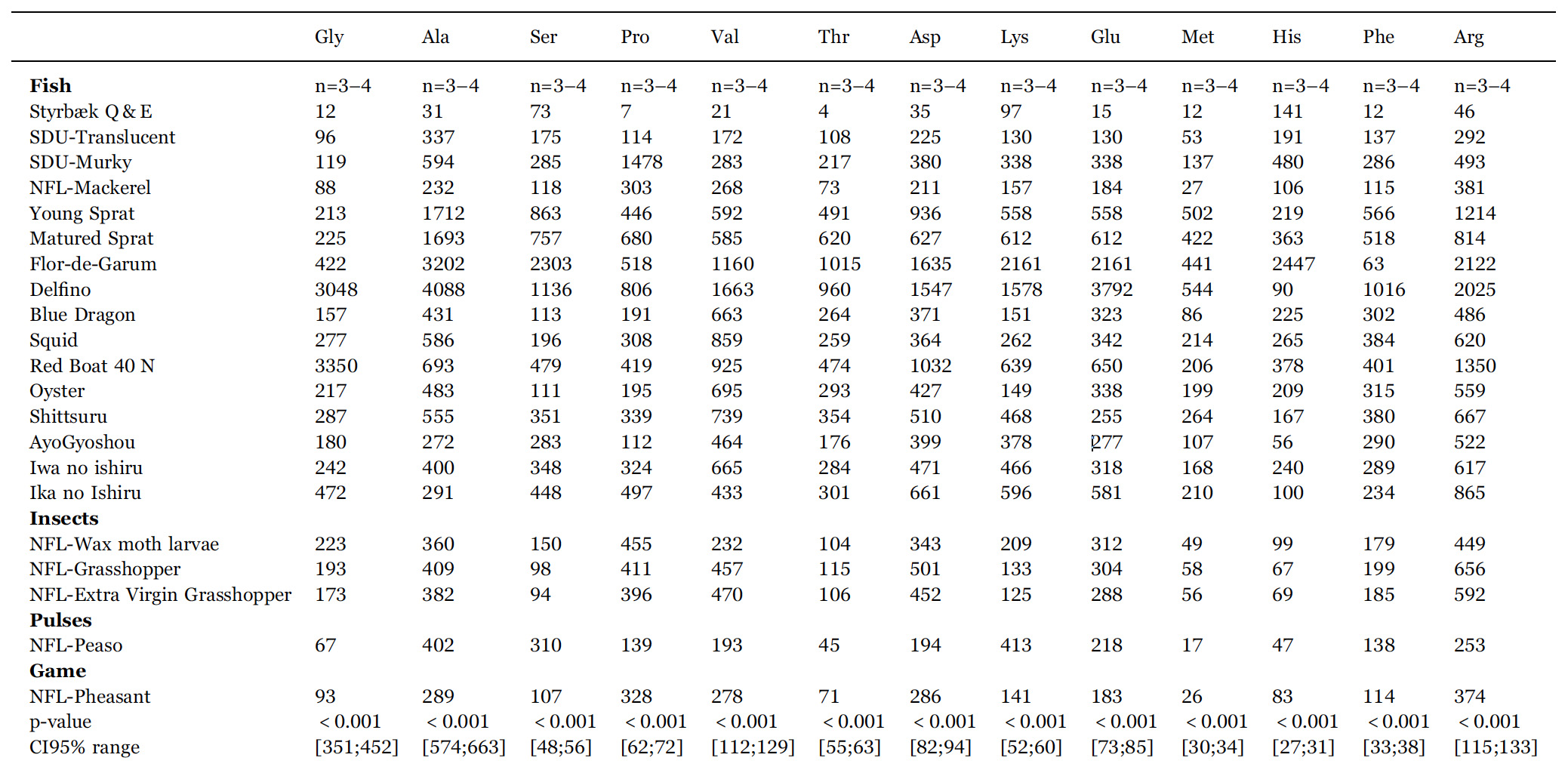
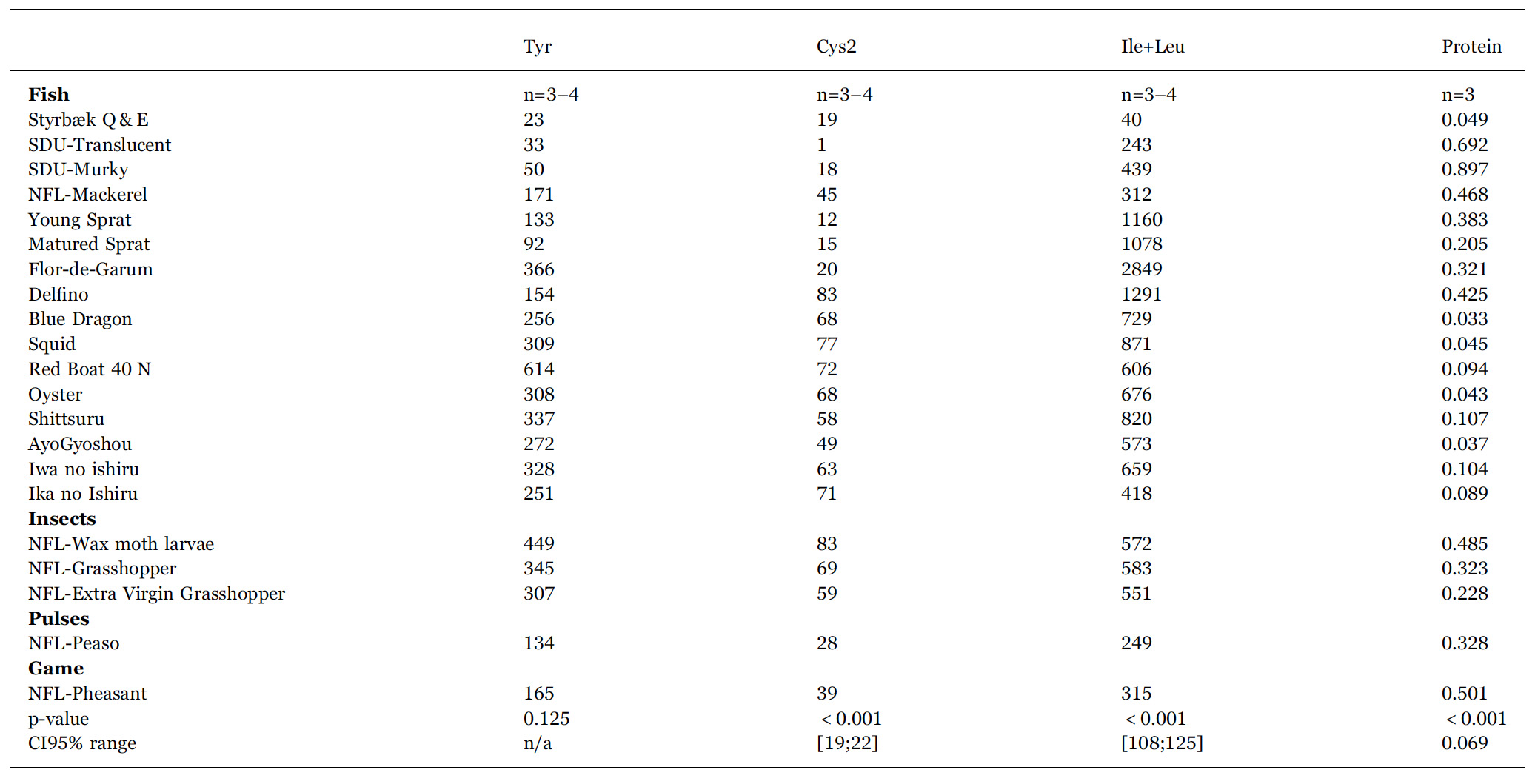
The mean ratings for all descriptors for 17 selected sauces for sensory analysis are listed in Table 4. Among the 14 descriptors, two did not contribute to separate the samples (sour and artificial chemical), one more had a p-value of 0.016 (yeasty), whereas the remaining 11 have p-values of 0.001 or less. The results in Table 4 thus show that the sensory analysis is precise enough to discriminate all fish sauces from one another, i.e., each fish sauce has a unique sensory profile.
The results from the multivariate analysis (A-PLSR) is visualized in Fig. 3 that is a correlation loading bi-plot, showing both the distribution of the fish sauces and the interrelationship between the descriptors.
The PLSR-analysis demonstrates that two underlying dimensions, describing 56% of the total variance in the data averaged over panellists, are sufficient to explain the systematic part of the variation in the sensory properties.
A pattern emerges from the results. Styrbæk Quick-and-Easy (Q&E) garum is located by itself in the upper left part of the plot. It is characterized by having the lowest intensity of umami (cf. Table 4) and is thus positioned inversely to umami. In the left part of the figure, the negative part of dimension 1, the four NFL-garums from Nordic Food Lab are positioned.
Along with Styrbæk Q&E, they are the samples lowest in salt taste and after taste. Those descriptors are located as the most extreme in the positive part of dimension one. In addition, the samples in the left part appear to be more bitter, but a close inspection of Table 4 reveals that it is only NFLPheasant that has a significantly higher bitterness.
Further scrutiny of the multivariate analysis reveals that the third underlying dimension (not shown) almost exclusive separates NFLPheasant from all other samples, and particularly so regarding the descriptors bitter and caramelized. In the upper right part are the two SDU-garums, translucent and murky. The two samples are the most fishy sauces (cf. Table 4). The two remaining sauces that were produced in Denmark are Matured and Young Sprat. They are located closer towards the centre of the plot, but still with a relatively high intensity of fishy taste. The southern European fish sauce Delfino, and the East-Asian fish sauces are characterized by high saltiness, umami taste, and more cheesy. Particularly Oyster, Squid and Red Boat have a high intensity of cheesy taste. All in all, the sensory analysis shows a clear grouping of the garums according to the production processes, more so than the raw material (fish, molluscs, insects, etc).
pH, osmolarity (mol/kg), sodium (g/L), potassium (g/L), and chloride (g/L) content of the fermented products listed in Table 1. n is the number of samples entering the mean value quoted. p-values and 95% confidence intervals (CI95%) are from ANOVA. Confidence intervals vary, as some samples are analysed in triplicates and other in quadruplicates. For pH and osmolarity no statistical analysis is made as they are obtained by single measurements.
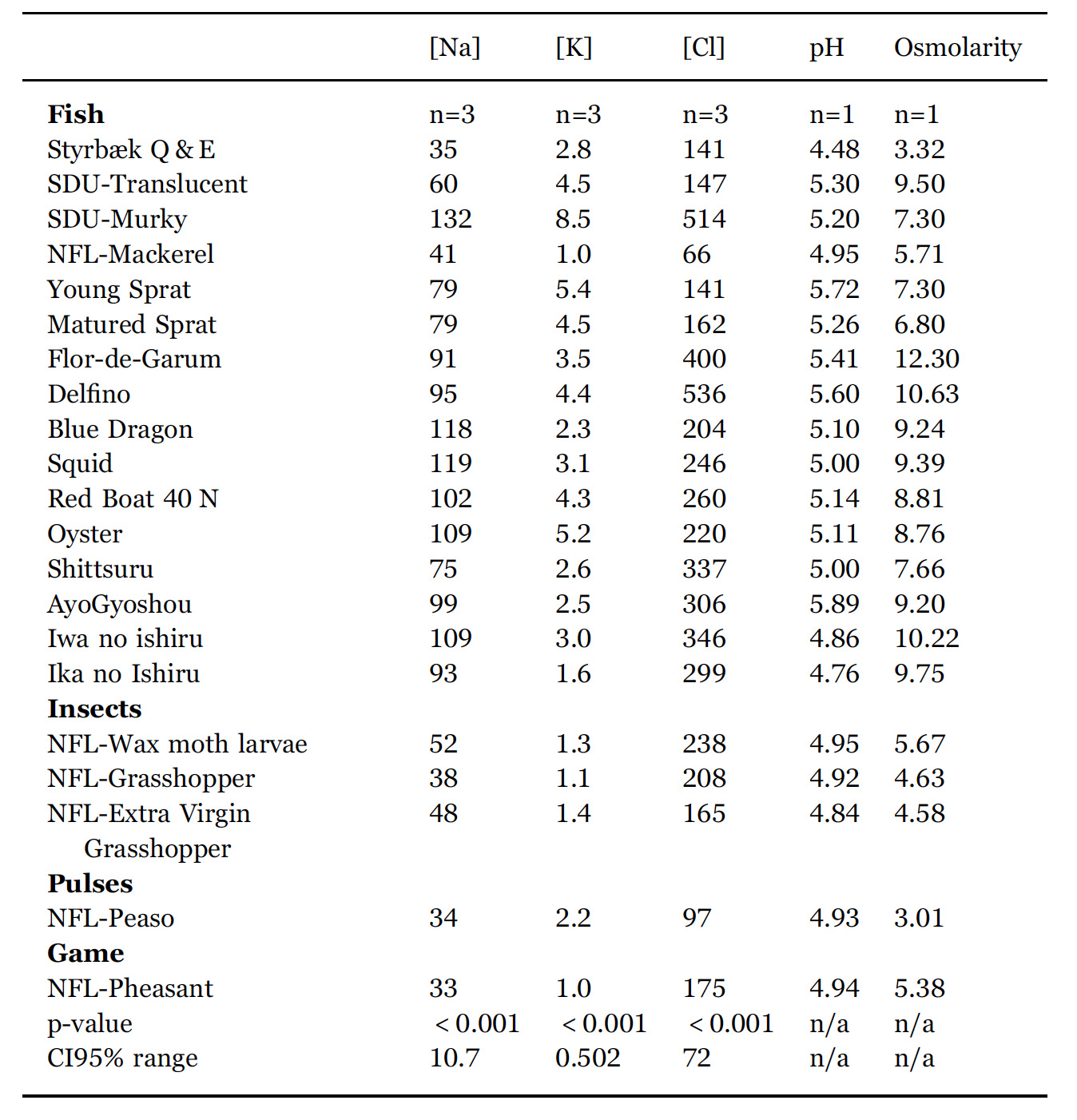
In Fig. 4 is shown a correlation loading bi-plot for dimensions 1 and 2 derived from a PLSR analysis of the relationship between chemical characterisations and sensory analysis. This plot looses some systematic information compared to correlation plots involving chemical and sensory information separately, cf. Fig. 2 and Fig. 3, respectively. It indicates that not all sensory differences are captured by the chemical characterization. It is possible that additional data for aroma compounds obtained by gas chromatography may have improved this situation (Lapsongphon et al., 2015).
Some interesting observations can be made from Fig. 4. The concentration of His and a fishy taste appears to be correlated. Na and Cl are good predictors of salty taste and after taste. Glu and Asp are, maybe surprisingly, not particularly good predictors of umami taste and after taste.
Fig. 2. Correlation loading bi-plot for dimension 1 and 2 derived from an A-PLSR analysis of chemical and physico-chemical descriptors. The inner and outer circles represent 50% and 100% explained variance, respectively, in the underlying dimensions. For sample identities, see Table 1. This common map of samples and chemical variables demonstrate the interrelationship and differences between the different sauces.
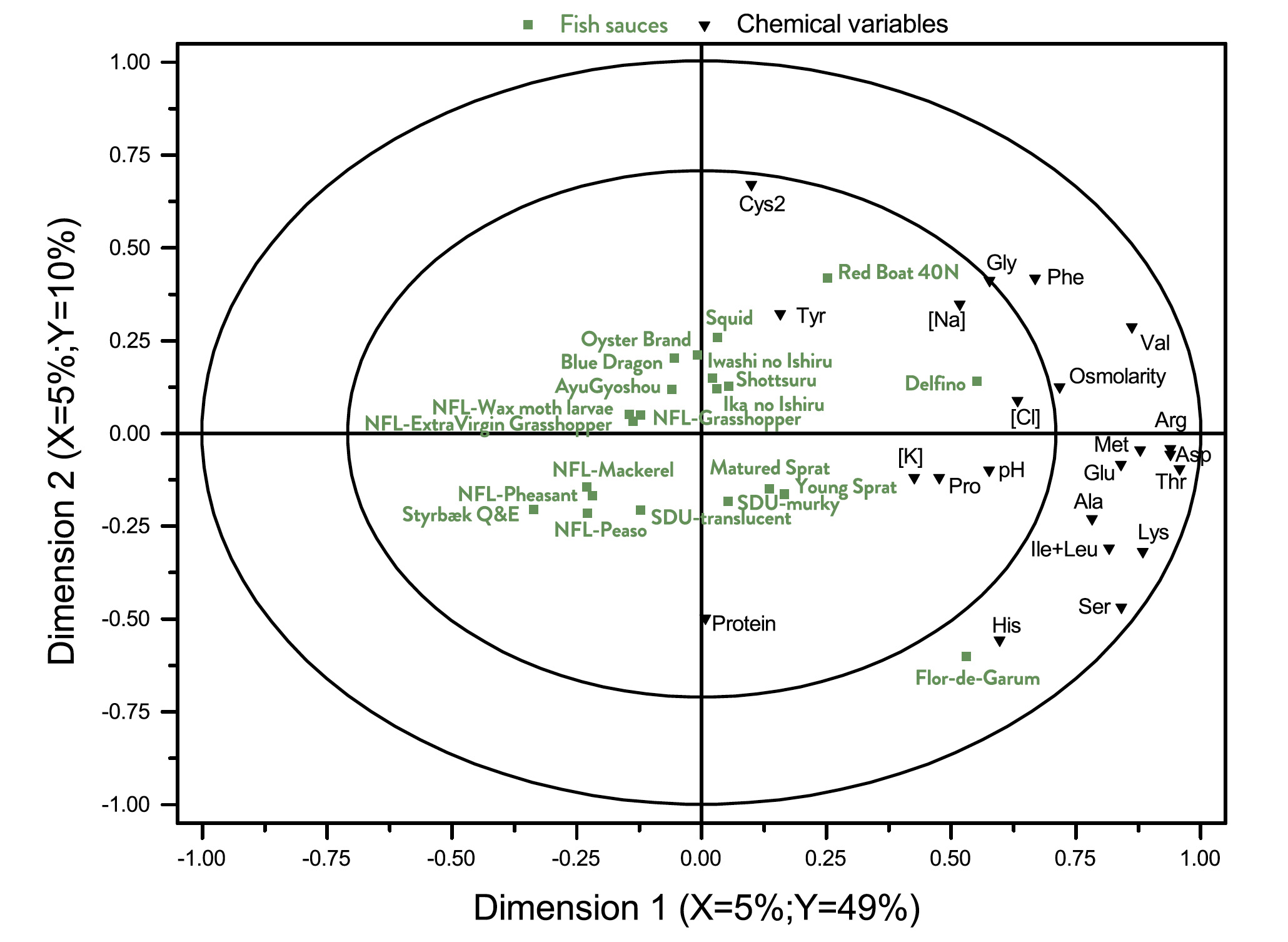
Fig. 3. Correlation loading bi-plot for dimension 1 and 2 derived from an A-PLSR analysis of sensory variables. See Table 1 for sample identities. The sensory variables are listed in Table 4. This common map of samples and sensory variables demonstrate the interrelationship and differences between the different sauces.
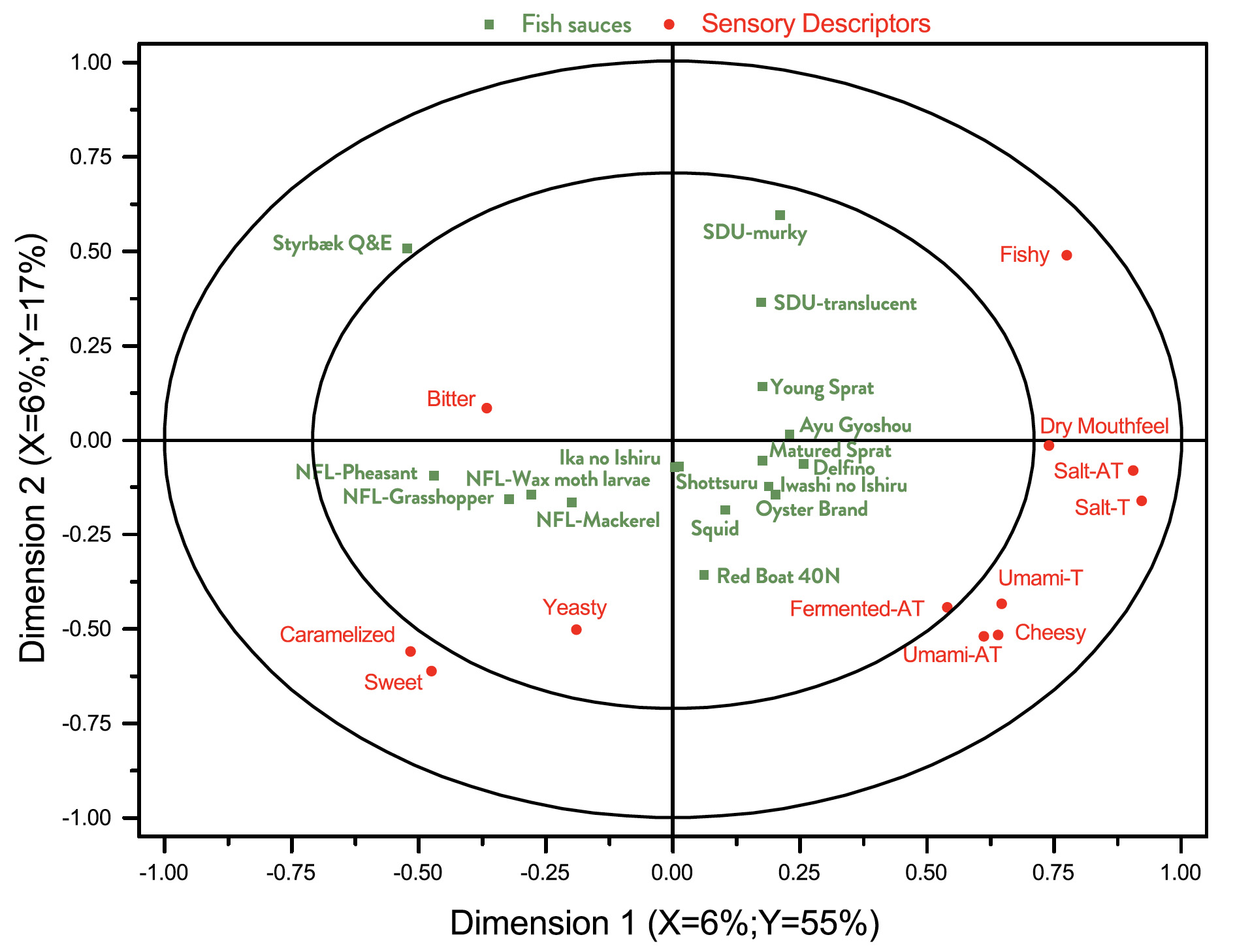
Fig. 4. Correlation loading bi-plot for dimensions 1 and 2 derived from a PLSR analysis of the relationship between chemical characterisations and sensory analysis. See Table 1 and Table 4 for sample identities and sensory variables, respectively.
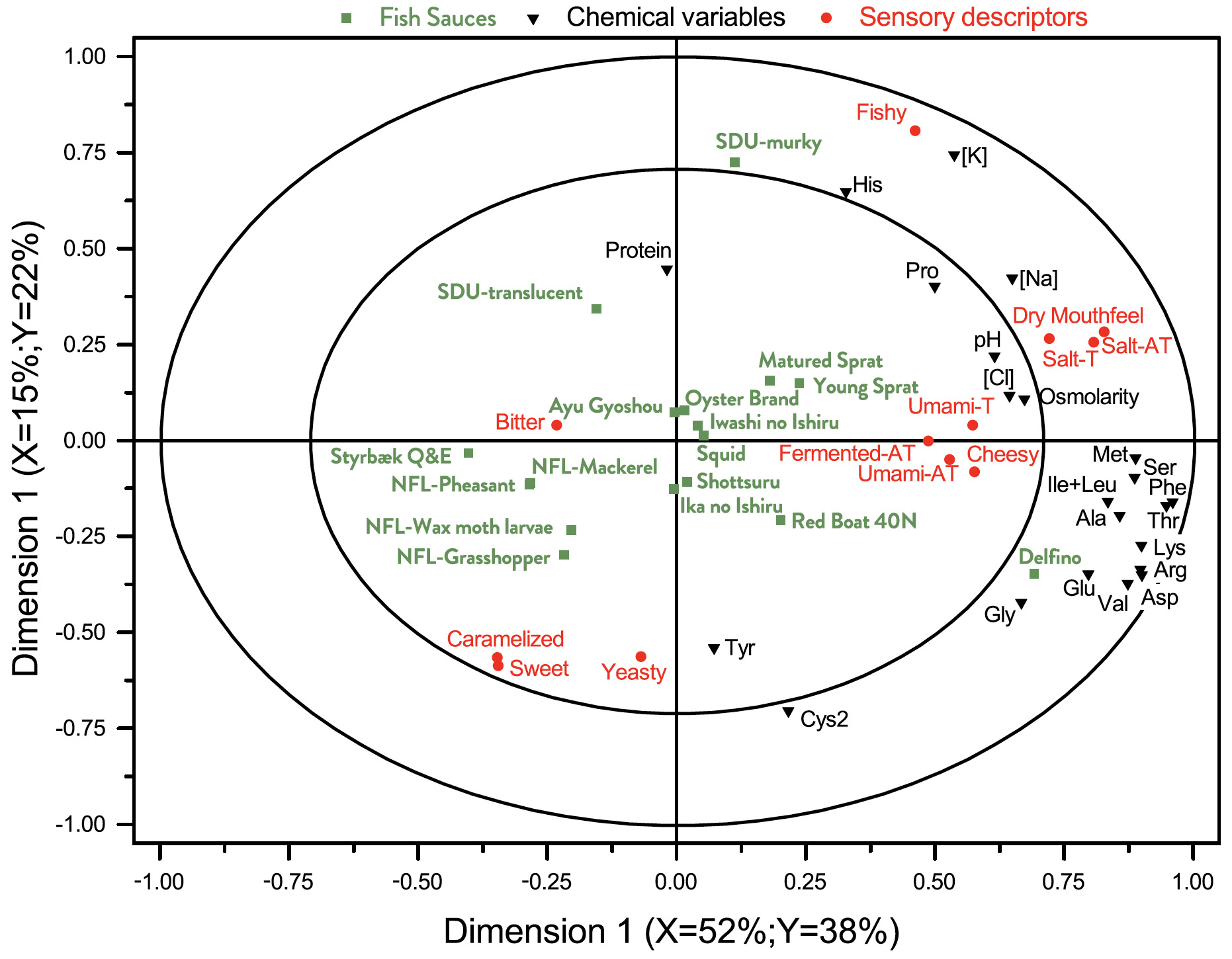

Table 4
Mean rating (over panellists and replicates) of intensity for all sensory descriptors for the 17 samples subjected to descriptive analysis. p-values and 95% confidence intervals (CI95%) are from ANOVA. Labels T and AT refer to ‘taste’ and ‘aftertaste’, respectively.
We have in the present paper performed a comparative study of a range of fermented sauces based on fish, molluscs, insects, pulses, and peas. The range of sauces encompasses both experimental sauces from our own laboratories as well from others. In addition we have investigated a range of commercial fish sauces. The purpose of the study was to characterise the different sauces by chemical, physicochemical, as well as sensory evaluation and uncover possible relationships between production methods and materials, chemical composition, and sensory characteristics.
Fermented sauces are commonly used as condiments in cuisines across the world, in particular with respect to add salty and umami taste to foodstuff. Most sauces available commercially are derived from a variety of fish, molluscs, and beans (in particular soy beans) but there is in principle no reason not also to consider producing fermented sauces from other raw materials with high contents of proteins, such as insects, pulses, and meat. In the present paper we have performed the first analyses of fermented sauces based on insects, and we have in addition studied fermented sauces from yellow peas and pheasant. We have found that these novel sauces have some superior sensory qualities and should be further considered for a wider use not only in the innovative kitchen, but possibly also on a commercial basis.
The quality, and with it the content of substances that impart umami, of all of these fermented sauces is very dependent on the raw ingredients that go into them and the method of production. Many of the commercially available products contain a great deal of salt and added MSG, and they do not live up to the high standard that is the hallmark of traditionally made fish sauces.
We have found, that all fermented sauces contain high levels of free amino acids, particularly Glu and Asp that are known to elicit umami taste. In contract, none of the sauces contain any measurable trace of free nucleotides. Hence, there is no basis for umami synergy in any of the sauces. This is also the case for those sauces where the fermentation has also involved the use of a koji mold. This finding is consistent with results of a previous study that did not find free nucleotides in fermented mackerel using soy sauce koji (Funatsu et al., 2000a, 2000b). As is well known from katsuobushi production special attention must be paid to the early stages of the production such that inosinate is not converted to inosine. Moreover, it is well-known that the inosinate produced in the dead fish from muscular ATP over time decays into inosine after some days (Howgate, 2006).
Use of koji in production of the NFL-garums appears to have placed all these sauces, it be produced by fish, insects, pulses, or game, in a special group with low salt and good flavour characteristics. Earlier work on fermented fish sauces based on mackerel (Funatsu et al., 2000a; 2000b) and salmon (Takeshima et al., 2001) also found that koji imparted a special flavour to the sauces.
There are a number of issues we have not dealt with in the present paper. One is the aspect of microbiology which we have circumvented by always using high amounts of salt in the experimental sauces in addition to reasonably low values of pH. Another issue is the content of histidin variation during fermentation (Taira et al., 2007), which is important because histidin can be converted to histamine that can provoke allergic reactions that can be a problem with some fish sauces with very high levels of histidin and histamine. By using extremely fresh fish for fermentation this problem can to some extent be alleviated.
One of the more surprising outcomes of the present study is that, although the sauces are generally high in free glutamate, umami synergy is not expected to play any significant role for the flavour of these fish, insect, game, and pea sauces. The sensory analysis shows a fairly good prediction of sensory properties from the chemical characterization of the sauces. However, the relationship between glutamate/ aspartate concentration and intensity of umami taste is not simple. It demonstrates that in the complex solutions that constitute these sauces, there may be other perceptions that interfere with the main umami-tasting compounds.
In the present paper we analyse the chemical composition of various fermented products, both commercial and experimental ones, with a view to relate their chemical composition to umami taste. We describe simple procedures for preparing fish sauce from mackerel, both fast cooking techniques and long-lasting fermentation techniques inspired by traditional garum production in the antiqueue Roman period as well as by use of ancient Japanese fungal inoculation methods. We extend these techniques to fermentation of insects, like moth and grasshoppers, pulses like yellow peas, and game like pheasant. Finally, we deliver a sensory evaluation of the various fermented products and make an assessment of their umami potential.
Regarding the potential umami flavour of the fermented sauces, our finding is, that whereas the various sauces contain substantial levels of free glutamate that elicits basic umami we find no trace of free nucleotides that could provide for umami synergy.
This work was supported in part by a grant to Smag for Livet (Taste for Life) from Nordea-fonden (both to University of Southern Denmark and Nordic Food Lab at University of Copenhagen). The HPLC-MS equipment was supported by a grant from the VILLUM Foundation, and the AAS was acquired via a grant from the Carlsberg Foundation.
Cuong T. Pham is thanked for kindly providing free samples of Red Boat Fish Sauce. Josh Evans is thanked for transforming Nordic Food Lab ׳s garum recipes into a format suitable for this publication. Klavs Styrbæk has provided the quick-and-easy garum. Poul Rasmussen has kindly supplied the fresh mackerel used for our garum experiments.
Søren Mørch is gratefully acknowledged for providing us with a sample of his homemade garum from mackerel gills and blood. Mio Kuriwaki and Kumiko Ninomiya from the Umami Information Center are thanked for sending us free samples of different Japanese fish sauces.
Fini Sánchez García kindly provided the experimental Flor-de-Garum from Cádiz based on a recipe from Pompeii. Jacob Sørensen (Montenegro Sea Food, Thyborøn) has kindly supplied a sample of fish sauce made with young sprats. Koji Kinoshita is thanked for help with Japanese language issues.
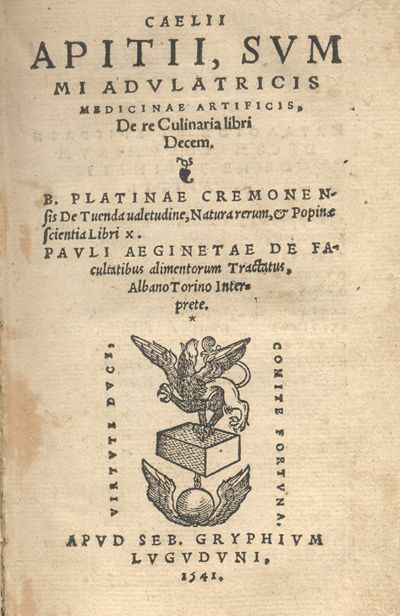
De re coquinaria (ou Ars Magirica, ou Apicius Culinaris) é um compêndio de receitas culinárias da Roma antiga, de autoria atribuída ao gastrônomo Marcus Gavius Apicius (25 a.C. – 37 d.C.), que ficou conhecido a partir de manuscritos organizados por monges de Fulda, na Alemanha, nos séculos VIII e IX e editados somente no século XIX. Originalmente escrito em latim, as receitas trazem exemplos de outras culinárias além da romana, como a grega por exemplo.
No De re coquinaria, o garum é referido quarenta e duas vezes (Lagóstena Barrios, 2007: 275), constituindo um ingrediente imprescindível de muitos pratos deste livro de receitas. Todavia, os molhos de peixe, quase sempre referidos como liquamen, estão presentes de alguma forma em cerca de 350 das pouco mais de 500 receitas apresentadas, ao passo que o sal aparece em 31 receitas (Curtis, 1984: 439).
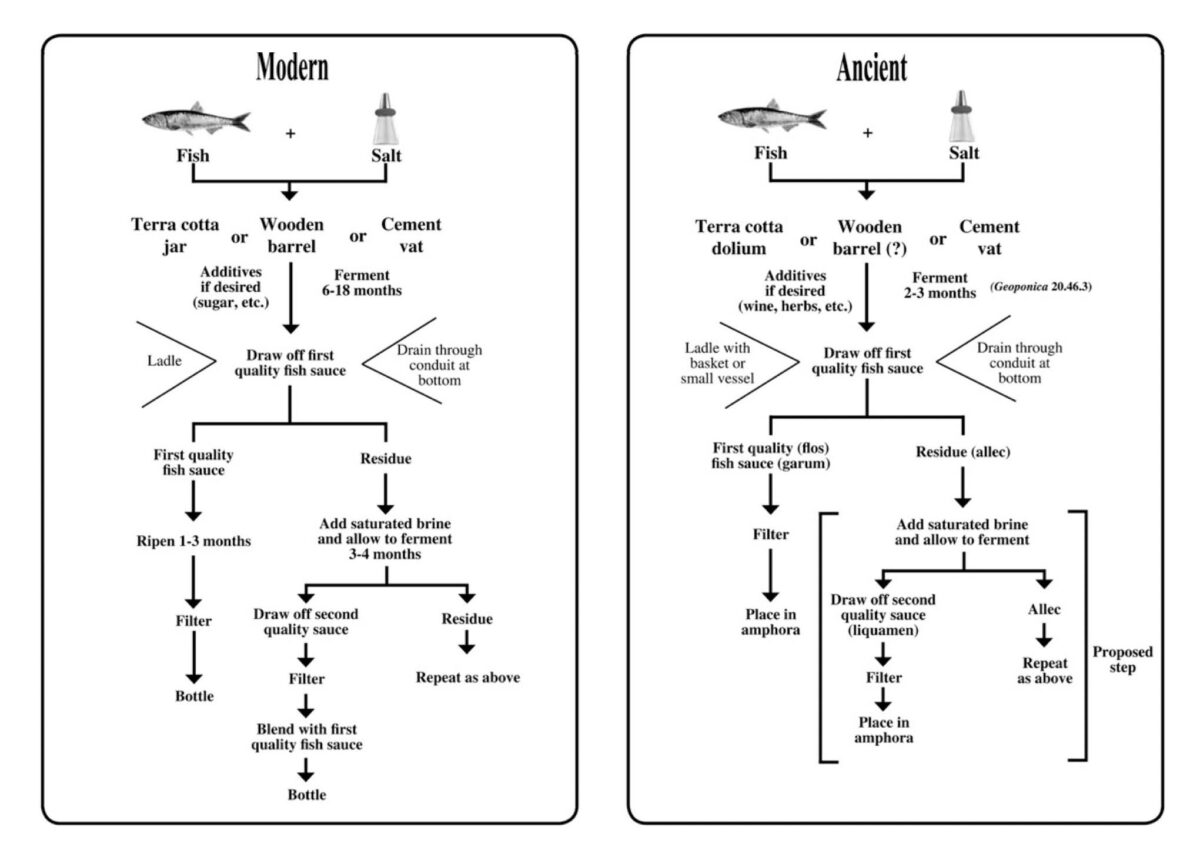
Trinh Fred Carpenter, Metro State and Gaius Stern, UC Berk (retired
fred.carpenter@metrostate.edu
gaius@berkeley.edu
The poet Ovid was exiled to the far reaches of the ancient Roman Empire by the Emperor Augustus in 8 CE. In his exile at Tomis, now modern day Romania, he lamented the things he missed, including food and the sound of his language. It is with this thought that we discuss a common ingredient in Roman cookery, garum, which has suffered unfair notoriety as “a disgusting sauce made from rotting fish guts”[1] by those who have never tasted it. The journey of garum from prominence to exile and return strangely runs parallel to Ovid whose fame returns centuries after his exile.
[1]See for example, clumsydisaster: “… the mere idea of fish guts fermenting in a jar just makes me want to gag. It was popular enough though that its end product was sought after by pretty much everyone. It would be mixed with wine, vinegar, black pepper, oil, diluted with water, etc. They even thought it was the best cure for dysentery and was a great hair remover. It seems that not only are the Romans out for tastiness but they’re out for versatility.
I’d like to add though that the end product (after all the petrifying and liquifying and obvious vomiting I’d have been doing if I had to make it) was considered quite yummy. Kind of on par to certain Asian sauces used in Asian cuisine today. I think I just get caught on the smell. Could you imagine that? Yuck.” From https://clumsydisaster.wordpress.com/2011/08/25/what-is-that-smell/ posted 25 Aug. 2011, 20 Sept. 2012.
What is garum? Garum, to put it simply, is a preserved fish product. Its origins trace to ancient Greece with the word, garos, and into Latin as garum. Garum is simply salt, fish, sun and time: Time for the fish to decay into a liquid and decomposed flesh at the bottom of a container. Garum is produced in a very similar manner to Asian fish sauce, or perhaps more correctly, Asian fish sauce is produced much like Garum. We can assume that the nutritional profile is similar with a product that is rich in umami or the fifth taste, usually associated with savoriness. It has a taste that is called “meaty.” Foods that are considered heavy umami are rich in glutamic acid, ribonucleotides, and inosinates, such as soy sauce, tomatoes, mushrooms, cheese, and preserved meats. Fish sauce is also rich in nutrients and can serve as a source of amino acids and protein (Thongthai). Brillat Savarin said that, “cheese was milk’s leap towards immortality,” and the same could be said of garum. Using salt and fermentation, a volatile product, fish, is transformed into a long stored food item that is easily transported over long distance and served as a source of salt and protein to a growing empire that was still eaten into the Byzantine period.
The earliest surviving mention of a form of garum comes from the Greeks from the 5th century BCE Athenian Old Comedy playwright Cratinus (519 – 422 BC), an older contemporary of Sophocles.[2]
[2]Kock fragment 1.95 apud Athen. 2.67c: ΓΑΡΟΣ. Κρατῖνος 1.95 K: ὁ τάλαρος ὑμῶν διάπλεως ἔσται γάρου.
Regarding garum: Cratinus says — Your basket will be full of pickled fish sauce.
For other sources mentioned throughout viz. Manil. Astron. 5.671 ff; Seneca Ep. 95. 25; Pliny NH 31.93ff; Martial Epig. 3.77.5, 11.27; Oneirocritica1.68; Isidore of Seville, Etymologies, 20.3.19-20.
Other fragments survive from Pherecrates, Sophocles, Aeschylus and a poet named Plato.[3]
Our main source of information on how to use garum and Roman cookery is the lone surviving cookbook from the Roman empire, Apicius’ De re coquinaria (“On the Subject of Cooking:) Over 70% of the ~465 recipes in the cookbook use liquamen, the first draw of garum (think of virgin olive oil). We are at a loss for the absence of these and other sources except as quotes in the Deipnosophistae of Athenaeus, a collection of dinner table discussions on everything from human virtues to types of vases and cups. Garum comes up as a subject at least twice, Deip. 2.67c, 9.366c: “And I also see garum sauce beaten up in a mixture with vinegar.
[3]Kock fragments 1,197, 545 = T.G.P.2 264, Kock fragment 1.656, 55 = T.G.P.2 71 apud Athen. 2.67c: Φερεκράτης 1.197 K: ἀνεμολύνθη τὴνὑπήνην τῷ γάρῳ.
And Pherecrates says—
His beard was all soaked with fish sauce.
Σοφοκλῆς Τριπτολέμῳ fr. 545 N: τοῦ ταριχηροῦ γάρου.
And Sophocles, in his Triptolemus, says — Eating this briny season’d pickle.
Πλάτων 1.656 K: ἐν σαπρῷ γάρῳ βάπτοντες ἀποπνίξουσί με. = fr. 198 Edmonds.
ὅτι δ᾽ ἀρσενικόν ἐστι τοὔνομα Αἰσχύλος δηλοῖ εἰπών fr. 55 N: καὶ τὸν ἰχθύων γάρον.
And Plato the comic writer says—
These men will choke me, steeping me in putrid pickle.
But the word γάρος, fish sauce, is a masculine noun, as Aeschylus proves, when he says “and the fishy sauce.”
“And I also see garum sauce beaten up in a mixture with vinegar. I know that in our day some inhabitants of Pontus prepare a special kind which is called vinegar garum.”[4] This line indicates yet another far from Rome local industry of garum production in the 2nd century AD, for the consumption of garum became an identity establishing feature of the Roman Empire, not unlike making a daily visit to the public baths or wearing the toga.
The Romans had four types of preserved fish product that we will broadly call garum:
· Garum: The general product made from preserving fish with salt. Later becomes interchangeable in word use with liquamen. Earlier sources indicate that this particular classification was made from blood and innards of larger fish, such as tuna and mackerel.
· Liquamen: First liquid draw from garum without fish flesh
· Muria: By product of fish salting process. The liquid brine
· Allex: Undissolved fish parts
Garum had both its fans and detractors, surprisingly, often the same people, including Seneca and Pliny, being but two of many. The astronomer Manlius Astron. 5.671 describes its preparation:
This part is better if the juices are given up; that part when juices are retained,
On this side a precious bloody matter (sanies) flows and vomits out the flower of the gore
And vomits out the taste after salt is mixed in, it tempts the lips;
on that side the putrid slaughter of the crowd (of fish) flow all together
and mix their shapes in another melting semi-liquid slosh
and provide a widely used liquid for foods.
…
their mutual gift of liquid flows out alike
and their inner parts melt and issue forth as a stream of decomposition.
Nay in fact they could fill the great salt pans
and cook the sea and also extract the poison of the salt sea.[5]
[4]Athen. Deip. 9.366c: ὁρῶ δὲ καὶ μετὰ ὄξους ἀναμεμιγμένον γάρον. οἶδα δὲ ὅτι νῦν τινες τῶν Ποντικῶν ἰδίᾳ καθ᾽ αὑτὸ κατασκευάζονταιὀξύγαρον. The translation came from Bill Thayer’s scan of the Loeb.
[5]Manil. Astron. 5.671-75: hinc sanies pretiosa fluit floremque cruoris / evomit ex mixto gustum sale temperat oris; illa putris turbae strages confunditur omnis / permiscetque suas alterna in damna figuras / communemque cibis usum sucumque ministrat. Check also Geoponika 20.46.6.
Seneca the Younger Ep. 95. 25 advises his correspondent Lucilius Junior against gluttony and excess when he says “What? Don’t you think the garum made by our allies, the bloody remains of harmful (the meaning may be poisonous) fish, burns the stomach (diaphragm) with salted putrification.[6]
Garum was a luxury good, produced in many parts of Italy, so if Seneca and Lucilius Junior know others import the Spanish product, not only is it more expensive (wastefulness) but actually harmful due to the local Spanish fish from which it is produced. It had the allure of pufferfish sushi or questionable Russian caviar. In an age of vice, described to a considerable extent in Petronius, people were engaging in a doubly harmful form of conspicuous consumption, as Eugene Weber of UCLA liked to mention, just to show they could afford to get the garum sociorum, even though it was not better than that of Pompeii. Some distantly-made garum was a status symbol (like Belgian beer or champagne today).
Pliny the Elder NH 31.43-44.93-97 describes both the spread of garum and the widespread garum production industry. He says garum has a delicious flavor and medicinal benefits, making it a luxury good and at the same time an edible form of Roman-ness.
There is yet another kind of choice liquor, called garum, consisting of the guts of fish and the other parts that would otherwise be considered refuse; these are soaked in salt, so that garum is really the bloody matter of the putrefying leftovers [illa putrescentium sanies]. Once this used to be made from a fish that the Greeks called garos; they showed that by fumigation with its burning head the after-birth was brought away. Today the most popular garum is made from the scomber in the fisheries of Carthago Spartaria—it is called garum of the allies—1,000 sesterces being exchanged for about two congii of the fish. … Clazomenae, too, is famous for garum, and so are Pompeii and Leptis, just as Antipolis and Thurii are for muria, and today too also Delmatia.
44.95. Allex is sediment of garum, the dregs, neither whole nor strained. It has, however, also begun to be made separately from a tiny fish, otherwise of no use. The Romans call it apua, the Greeks aphye, because this tiny fish is bred out of rain. The people of Forum Julii call lupus (wolf) the fish from which they make garum. Then allex became a luxury, and its various kinds have come to be innumerable; garum for instance has been blended to the color of old honey wine, and to a taste so pleasant that it can be drunk. But another kind <of garum> is devoted to superstitious sex-abstinence and Jewish rites, and is made from fish without scales. Thus allex has come to be made from oysters, sea urchins, sea anemones, and mullet’s liver, and salt to be corrupted in numberless ways so as to suit all palates. These incidental remarks must suffice for the luxurious tastes of civilized man. Allex however itself is of some use in healing. For allex both cures itch in sheep, being poured into an incision in the skin, and is a good antidote for the bites of dog or sea draco; it is applied on pieces of lint. By garum too are fresh burns healed, if it is poured over them without mentioning garum. Against dog-bites it is beneficial and especially against those of crocodiles..(7)
[6]Quid? Illud sociorum garum, pretiosam malorum piscium saniem, non credis urere salsa tabe praecordia? For garum sociorum, see Robert Etienne, “A propos du ‘garum sociorum’,” Latomus 29 (1970) 297-313. Translation Gaius Stern, tabes = corruption, wasting away.
[7]Aliud etiamnum liquoris exquisiti genus, quod garum vocavere, intestinis piscium ceterisque quae abicienda essent sale maceratis, ut sit illa putrescentium sanies. hoc olim conficiebatur ex pisce quem Graeci garon vocabant, capite eius usto suffito 94extrahi secundas monstrantes. nunc e scombro pisce laudatissimum in Carthaginis Spartariae cetariis—sociorum id appellatur—singulis milibus nummum permutantibus congios fere binos. … laudantur et Clazomenae garo Pompeique et Leptis, sicut muria Antipolis ac Thuri, iam vero et Delmatia.
All the same, while reporting garum’s merits and medicinal value, Pliny disgusts the modern reader by mentioning the decomposing fish. This seemingly very mixed presentation probably did not faze the Roman audience who was practical and not disgusted by the same smells and tastes as us (e.g. sulphur as a cleanser, fullers using urine as detergent). In the ancient world, nothing edible was thrown away, because many people struggled with hunger.
The poet Martial 3.77.5, like Seneca before him, regards garum as a luxury good, but one that everyone can afford, and that everyone enjoys. He criticizes a certain Baeticus for eating capers and onions “swimming” in putrid allex: capparin et putri cepas allece natantis. Again here the idea is that Baeticus is no gourmet. He shuns hare, boar, thrush, and mullet (the latter much praised by T. Annius Milo in a letter to Cicero), but eats simple capers and onions and pours on the garum. Baeticus is the sort of person who prefers burgers at MacDonalds over duck confit at a French restaurant, and any kind of mustard will do. He does not need Grey Poupon.
Likewise, in a second epigram, Martial 11.27, the unnamed girlfriend of Martial’s friend Flaccus is satisfied with fairly modest requests from her boyfriend, including garum,whereas Martial’s own girlfriend makes far greater demands, which he fails to deliver, but he likes the fact that she has highbrow tastes. For us, the point emerges from both epigrams that garum is something everyone can afford, at least the less expensive varieties, so as a luxury good it compares to exotic jam in the US: not everyone can afford to buy imported Swedish cloudberry jam or Michigan Thimbleberry jam at $12 per eight-ounce bottle, but everyone can afford Safeway raspberry jam (9)
You are made of iron, Flaccus, if your cock can stand
when your girlfriend begs you for six cyathi (half a pint) of garum,
or asks in vain for two pieces of tuna or a slim fillet of mackerel
and thinks herself unworthy of a whole bunch of grapes;
one to whom her maid with delight carries on a red platter
allecem fish-sauce, but she devours it immediately.[8]
44.95 Vitium huius est allex atque imperfecta nec colata faex. coepit tamen et privatim ex inutili pisciculo minimoque confici. apuam nostri, aphyen Graeci vocant, quoniam is pisciculus e pluvia nascitur. Foroiulienses piscem ex quo faciunt lupum appellant. transiit deinde in luxuriam, creveruntque genera ad infinitum, sicuti garum ad colorem mulsi veteris adeoque suavitatem dilutum ut bibi possit. aliud vero . . . castimoniarum superstitioni etiam sacrisque Iudaeis dicatum, quod fit e piscibus squama carentibus. sic allex pervenit ad ostreas, echinos, urticas maris, mullorum iocinera, innumerisque generibus ad saporis gulae coepit sal tabescere. 96 haec obiter indicata sint desideriis vitae, et ipsa tamen non nullius usus in medendo. namque et allece scabies pecoris sanatur infusa per cutem incisam, et contra canis morsus draconisve marini prodest, in linteolis autem concerptis inponitur. 97 Et garo ambusta recentia sanantur, si quis infundat ac non nominet garum. contra canum quoque morsus prodest maximeque crocodile …
[8]Ferreus es, sista repotest tibi mentula, Flacce,/ cum te sexcyathos oratamica gari. vel duo frusta rogat cybii tenuemve lacertum nec dignam toto se botryone putat; cui portat gaudens ancilla paropside rubra allecem, sed quam protinus illa voret.
The professional diviner from 2nd century AD Ephesus, Artemidorus Daldianus Oneirocritica 1.68, was no fan of garum: idcirco Artemidorus garum nihil aliud esse nisi putredinem contendit: ouden allo h shpedwn, quae sentential in Zonorae et Suidae lexica abiit; – “about it, Artemidorus contends that garum is nothing other than putrid when he says (in Greek) ‘nothing other than rottenness,’ which opinion was absent in the lexicons of Zonoras and Suidas.” (10)
Garum was used extensively in Roman cuisine and found throughout the Empire. Garum factories were found in Pompeii and Roman Hispania. Further evidence of garum’s availability and common access appear in two price sources, Tariff of Zarai, CE 202, and the Price Edict of Diocletian, AD 301. In the Tariff of Zarai the pricing of garum is comparable to wine of the same amount. In the Price Edict of Diocletian the fish sauce was broken into two quality classifications (first and second). Again, in comparing with other goods listed in the Edict, it is found that first and second quality garum was priced comparably with first and second class honey. Inferring from these two sources we can deduce that garum was common enough to be taxed regularly and fell within the price access of the Roman public, corroborating our inferences from Martial (above) 150 years later. Further, excavation in Pompeii and Herculaneum show amphorae of garum in the homes across a wide stratum of society with all four types found.
Obviously garum started in Italy for local consumption, but as the Roman Empire expanded, so did the need for garum and the need for local production. And the need grew as it went, meaning that many new Romans adopted a taste for garum, either because it tastes good (as we argue) or because its consumption was seen as a status symbol. Augustus settled many Italians in the provinces in the settlements of the 20s BC. One mostly overlooked way they Romanized the provinces, besides recreating grid-pattern Roman cities with baths and a forum, was to bring their tongues with them, meaning both the speaking of Latin – on which much has been said and written before – but also the taste for Roman food. They imported and eventually produced their own garum to enjoy the flavors of home far from Italy.
[9]I can hardly recommend highly enough Thimbleberry Jam to those who can afford it, sold in eight ounze jars for $12 each, http://thimbleberryjamlady.com/store/index.php?main_page=index&cPath=1&zenid=up3j3qmnejg0ms7u34dbu530q1
[10]See also Galen, Concerning the Properties of Foods 1.1.42-43, Corpus medicorum graecorum, 5.4.2.
Because of the species of fish used, production of garum was mostly based around the shores of the Mediterranean, and the products of Hispania, Lusitania, and North Africa near Carthage were considered the best.[11] Remains of the garum works in present day Spain testify to the size of production and the wide shipping network of the product. Garum production eventually spanned coastal Hispania, Lusitania, Gaul, and North Africa. The Eastern Empire also had processing centers along the Black Sea even beyond Roman territory in the Crimea and the Strait of Kertch. The most extensive findings have been in Spain and Portugal; one location, Troia had the production capacity of 600 cubic metres. The largest center is at Lixus in Nothern Morocco, whose capacity was greater than 1000 cubic metres. These sites indicate how large the production was of the garum. It was so widely consumed that a kosher variety was available for the Jewish population in Alexandria.
It is a wonder then that garum declined completely in its use and distribution in the Roman and Byzantine world. But we know what disrupted the centuries-long production and trade of garum: war and the loss of order. Beyond the basics of fish, salt and time in producing garum in the Byzantine period large fishing fleets were essential and so were beachfront facilities (especially after regulations were put in place by Constantine Harmenopoulus that garum works could not be within a certain distance of a town due to the odors) and safe shipping routes from areas of production to faraway clients. Other factors that may have affected garum pricing and access were the requirement of a large workforce, land for facilities, and credit during a tumultuous time where shipping routes would not necessarily be secure. The Empire’s decline and the contraction of the Empire pulled apart the trade routes and threads from production to the client. According to archaeologist Claudio Giardino, two additional issues were the salt tax, a heavy burden on a major ingredient of garum, and the lack of security in coastal regions once the Empire could no longer protect itself. The increase in production and shipping costs made garum far more difficult product to acquire. For a fuller sense of the change in Roman cuisine through time, observe the list of ingredients and flavoring ingredients that could no longer or rarely be found, including sylphium, lovage, passum, and defrutum. However, the love of preserved fish is still found in modern Italy with salted cod taking the place of Egyptian red mullet, salted anchovy for garum/muria/alec, and salted tuna. Interestingly enough, garum was rediscovered by Cistercian monks in Campania where Colatura di Alici is produced. It is produced differently than classic garum and Asian fish sauce, where the brine of the salted anchovies is drawn away from the vat as fermentation occurs. It is closer to muria than classic liquamen, which was decanted from the container.
[11]Strab. Geog. 3.4.6: εἶθ᾽ ἡ τοῦ Ἡρακλέους νῆσος ἤδη πρὸς Καρχηδόνι, ἣν καλοῦσι Σκομβραρίαν ἀπὸ τῶν ἁλισκομένων σκόμβρων, ἐξ ὧν τὸἄριστον σκευάζεται γάρον: εἴκοσι δὲ διέχει σταδίους καὶ τέτταρας τῆς Καρχηδόνος.
Next is the island of Hercules, near to Carthage, and called Scombraria, on account of the mackerel taken there, from which the finest garum is made. It lies 24 stadia from Carthage
In contrast, the production of fish sauce in Asia has been uninterrupted for centuries. There is a question of west-east transfer of fish sauce technology, but this paper avoids that controversy and limits its focus to the similarity of the two food products developed in different areas of the world. One does not know for certain whether Asian fish sauce (fish water) originated in China or Southeast Asia. Apparently, the diffusion of the concept emerges out of China prior to the Han dynasty (206 BC – AD 220). Roman and Vietnamese fish sauce have a similar ratio of fish to salt ≤ 5:1, but the Romans fermented garum for less time before bottling it. Both Roman and Southeast Asian cuisines use fish sauce in similar manners, as both an ingredient in cooking and as a condiment that can be diluted with other ingredients like vinegar or sweetener. Both have grades of quality. Vietnamese and Thai fish sauce divide into four grades. The first grade is similar to Roman flos, it is the first draw from the vat. The fish remains from the vat are mixed with salt water to ferment for two to three additional months to create the second and third grades. The is where the fish remains from the third grade fermentation are boiled with salt water to produce the lowest grade (probably what Baeticus slathers on his capers. For a clearer chart of production, see Curtis’ chart from “Umamni and the Food of Classical Antiquity. (12)
Asian fish sauce production is as diffuse as the ancient Roman was, but rather than suffer a fall back in production, it has expanded into a multi-million dollar industry with EU origin classification. The popularity of Southeast Asian cuisines, in particular, Thai and Vietnamese has magnified the customer base of fish sauces (13)
[12]Robert I. Curtis, “Umamni and the Food of Classical Antiquity,” The American Journal of Clinical Nutrition 90.3 (2009), 7125-85.
[13]Another area of expansion is Africa, where fish sauce is used in Senegalese and other West African cuisines sometimes to replace other preserved fish products (momone or guedj). Though fish sauce is on the rise, there are still issues that could see the decline of Asian fish sauces, such as climate change and the collapse of fish stocks in the coastal regions of Asia. Vietnamese fish sauce uses pelagic fish, such as anchovy. The Romans used more varieties of fish including larger fish, such as tuna and mackerel in addition to pelagic fish. The Asian industry uses a smaller base of fish species in its production.
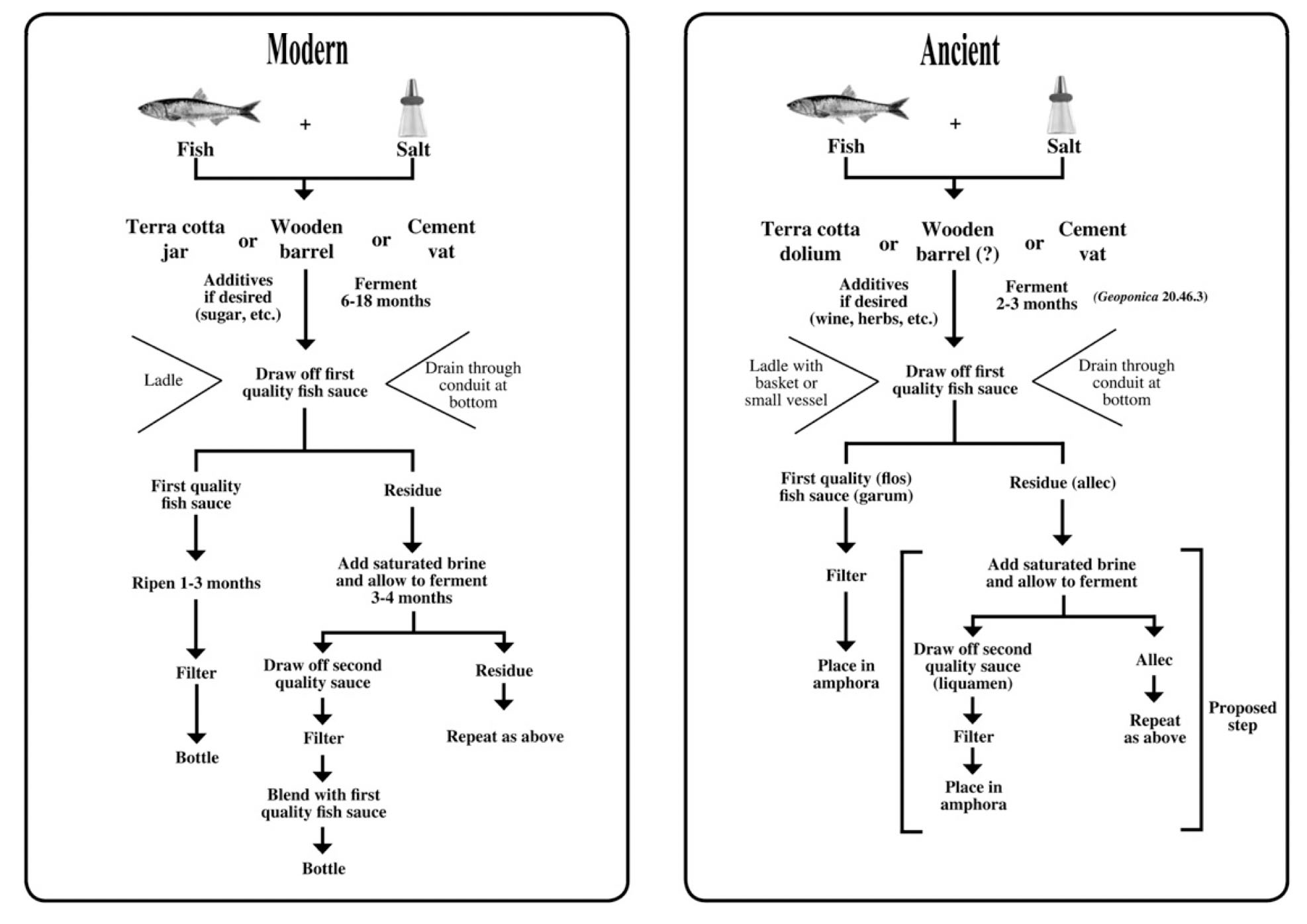
In the end, we have a food item that has been around to see its own decline and re-birth. Fish sauce was a dominant flavoring agent of the large Roman Empire and declined with it. It simultaneously emerged in Asia and now is the dominant flavoring agent for cuisines that are finding homes throughout the global economy. Ovid, I think, would have been pleased to eat at a Thai or Vietnamese restaurant, if one opened in Tomi.
Now try a bit of Roman patina cooked with garum and pine nuts

References:
Brothwell, Don R, and Patricia Brothwell. Food in antiquity: a survey of the diet of early peoples. JHU Press, 1969.
Corcoran, Thomas H. “Roman fish Sauces,” Classical Journal 58 (1963), 204-10;
and Curtis, Robert I. “In Defense of Garum,” Classical Journal 78 (1983), 232-40.
Curtis, Robert Irvin. “Umamni and the Food of Classical Antiquity,” The American Journal of Clinical Nutrition 90.3 (2009), 7125-85.
Garum and Salsamenta: Production and Commerce in Materia Medica. Brill Academic Pub. (1991).
The Production and Commerce of Fish Sauce in the Western Roman Empire: A social and Economic Study. (Diss. 1978).
Ancient food technology. Brill Academic Pub. (2001).
Dalby, Andrew, and Sally Grainger. The classical cookbook. Getty Publications, 1996.
Faas, Patrick, and Shaun Whiteside. Around the Roman table. University of Chicago Press, 2005.
Giacosa, Ilaria Gozzini. A taste of Ancient Rome. Rand Corporation, 1994.
Grainger, Sally. Cooking Apicius: Roman recipes for today. Prospect Books, 2006.
Grimal, Pierre and Monod, Thomas “Sur le veritable nature du ‘garum,'” Rev. Étud. ancien., 34: 27-38, 1952;
Claude Jardin, “Garum et sauces de poisson de 1’inriquiti,” JZiV. Stud. Liguri, 2T70-96, 1961;
Ruddle, Kenneth, and Naomichi Ishige. “On the origins, diffusion and cultural context of fermented fish products in Southeast Asia.” lobalization, Food and Social Identities in the Asia Pacific Region. Sophia University Institute of Comparative Culture, Tokyo (2010).
Thongthai C, Gildberg A. Asian fish sauce as a source of nutrition. In: Shi J, Ho CT, Shahidi F, eds. Asian functional foods. Boca Raton, FL: Taylor & Francis, 2005:215–65.
R. Zahn, “Garum,” A.Pauly, et al, ed. in Real-Encyclopedie der classischen Altertumswissenschaft, 80 vols., Stuttgart, J. B. Metzler, 1893-1974, 1st series, 8, cols. 841-849, 1912 (hereinafter referred to as RE).
http://www.thaifoodandtravel.com/features/fishsauce1.html
http://vietworldkitchen.typepad.com/blog/2008/11/fish-sauce-buying-guide.html
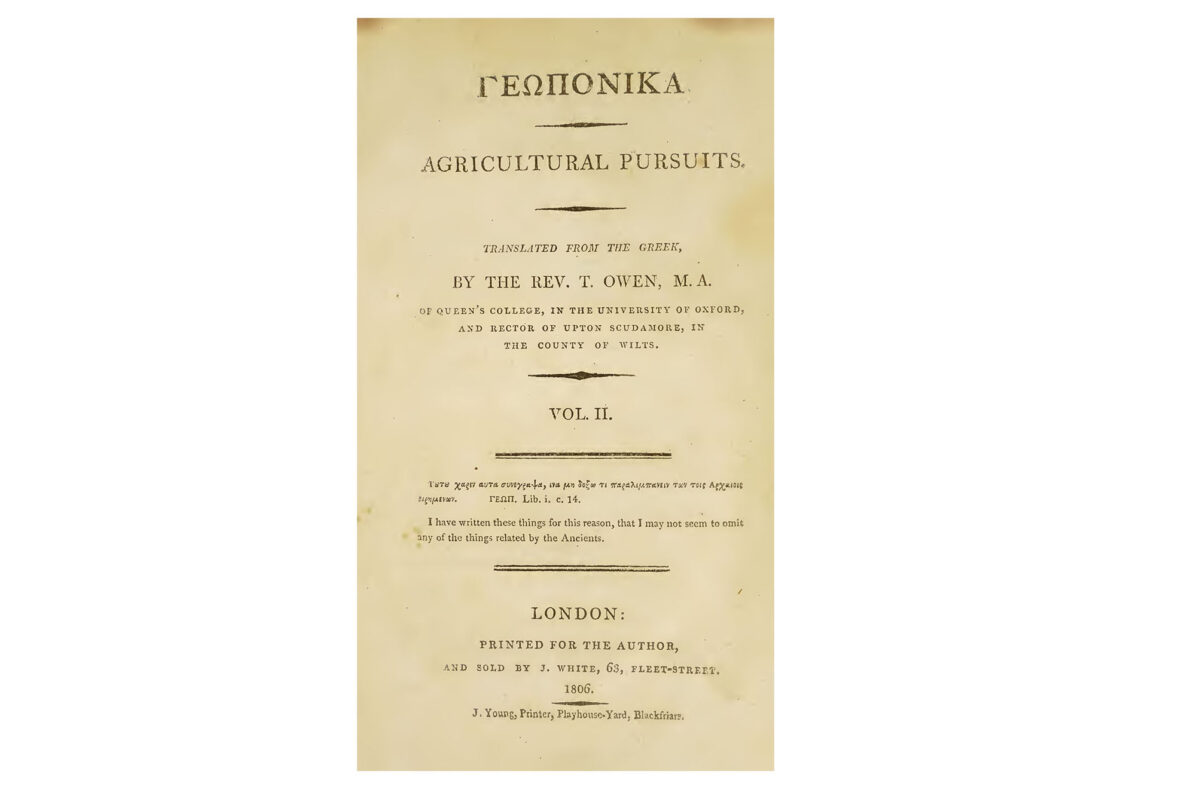
The Geoponica (also spelled Geoponika, Greek: Γεωπονικά) is a twenty-book collection of agricultural lore, compiled during the 10th century in Constantinople for the Byzantine emperor Constantine VII Porphyrogenitus.
The Greek word Geoponica signifies "agricultural pursuits"
The 10th century collection is sometimes (wrongly) ascribed to the 7th century author Cassianus Bassus, whose collection, also titled Geoponica, was integrated into the extant work.
Bassus drew heavily on the work of another agricultural compiler, Vindonius Anatolius (4th century).
The ultimate sources of the Geoponica include Pliny, various lost Hellenistic and Roman-period Greek agriculture and veterinary authors, the Carthaginian agronomist Mago, and even works passing under the name of the Persian prophet Zoroaster.
The Geoponica embraces all manner of "agricultural" information, including celestial and terrestrial omina, viticulture, oleoculture, apiculture, veterinary medicine, the construction of fish ponds and much more.
Geopónica o Extractos de agricultura de Casiano Baso;
traducción y comentarios de María José Meana, José Ignacio Cubero, Pedro Sáez;
Instituto Nacional de Investigación y Tecnología Agraria y Alimentaria 1998
Geoponica (XX, 46, 1 e seguintes) – séc. IX, bizantino.
Pôr num recipiente as vísceras de peixes e peixes pequenos com sal e deixar ao sol mexendo frequentemente. Terminada a maceração por efeito do calor, retira-se o garum introduzindo um cesto. O garumescorre para dentro do cesto e é filtrado através dele, podendo-se recolher o chamado liquamen. A parte sólida que fica é o alex. Alguns misturam duas medidas de vinho velho por cada medida de peixe.
Se se precisar de usar o garum sem o ter tanto tempo ao sol , coze-se rapidamente pondo o peixe em água do mar concentrada de modo a que um ovo bóie (…). Mas a flor do garum obtém-se com as entranhas, o sangue e o suco dos atuns sobre os quais se deita sal e se deixa macerar durante dois meses.
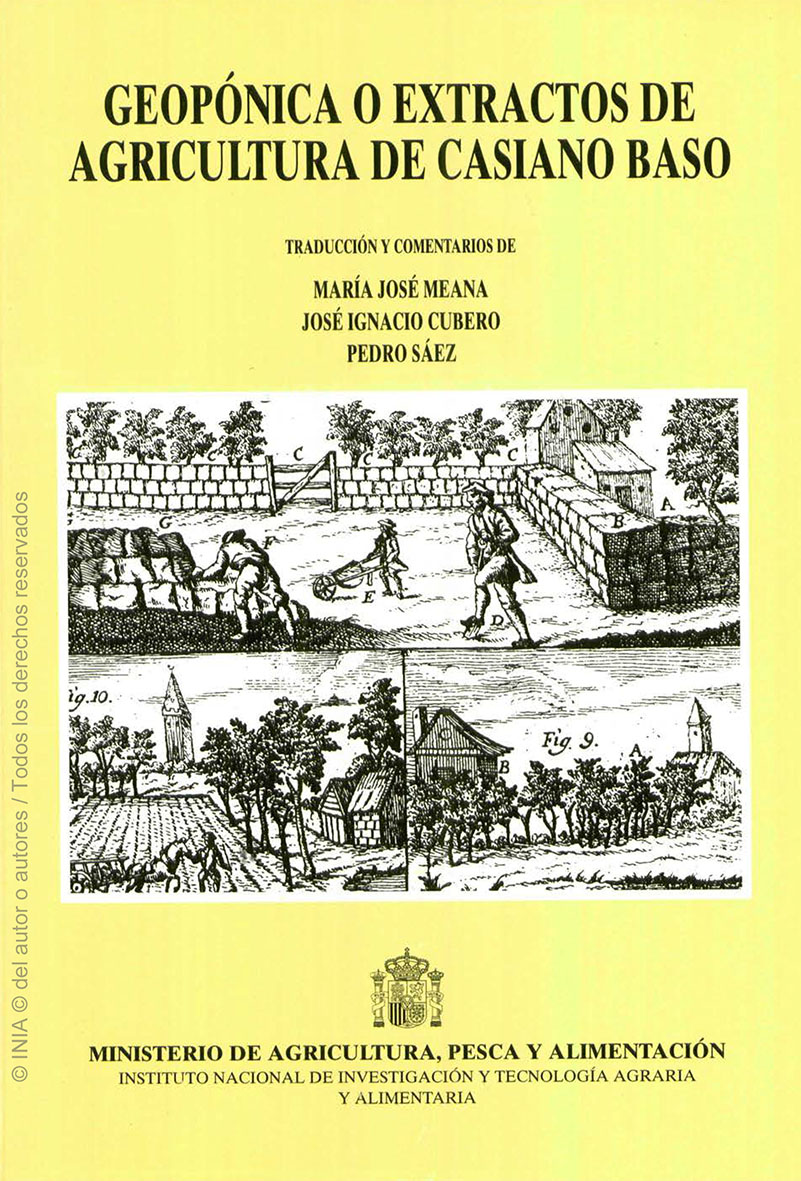
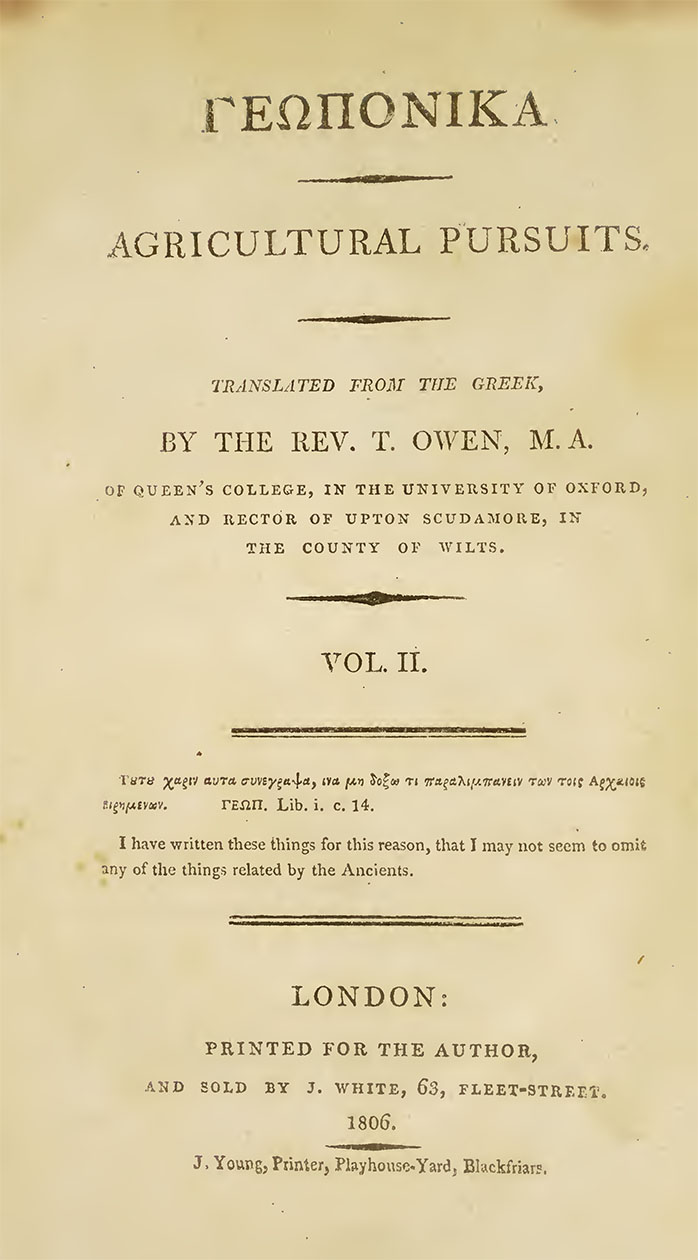
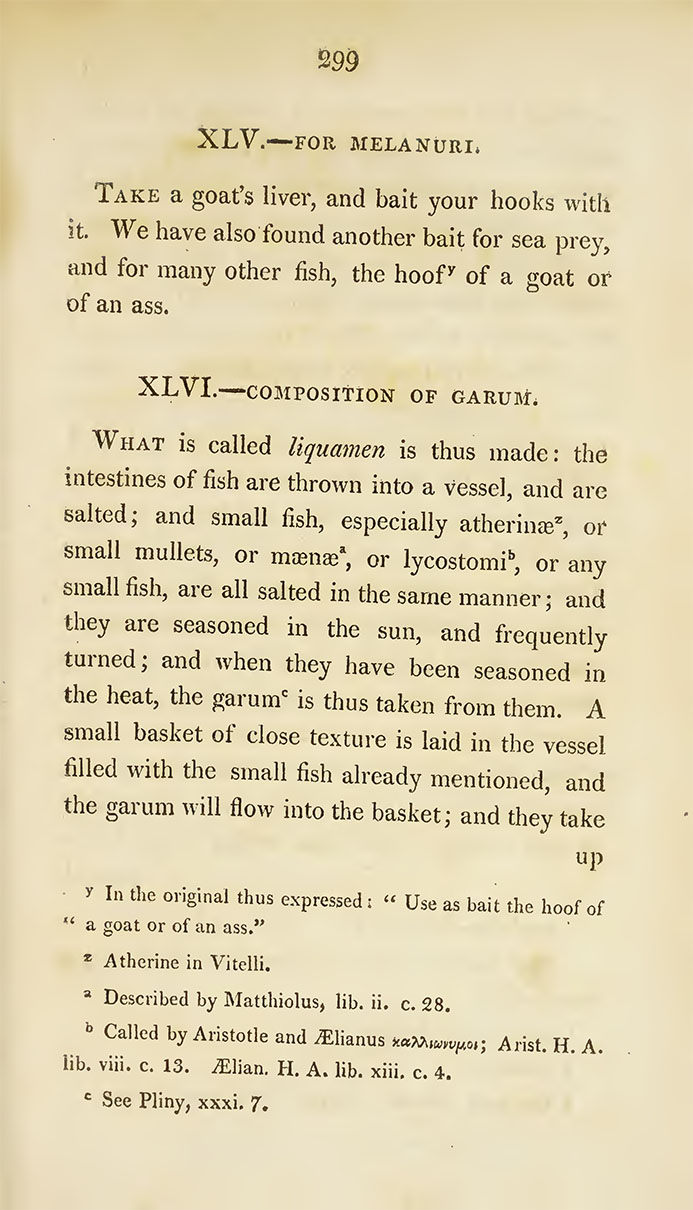
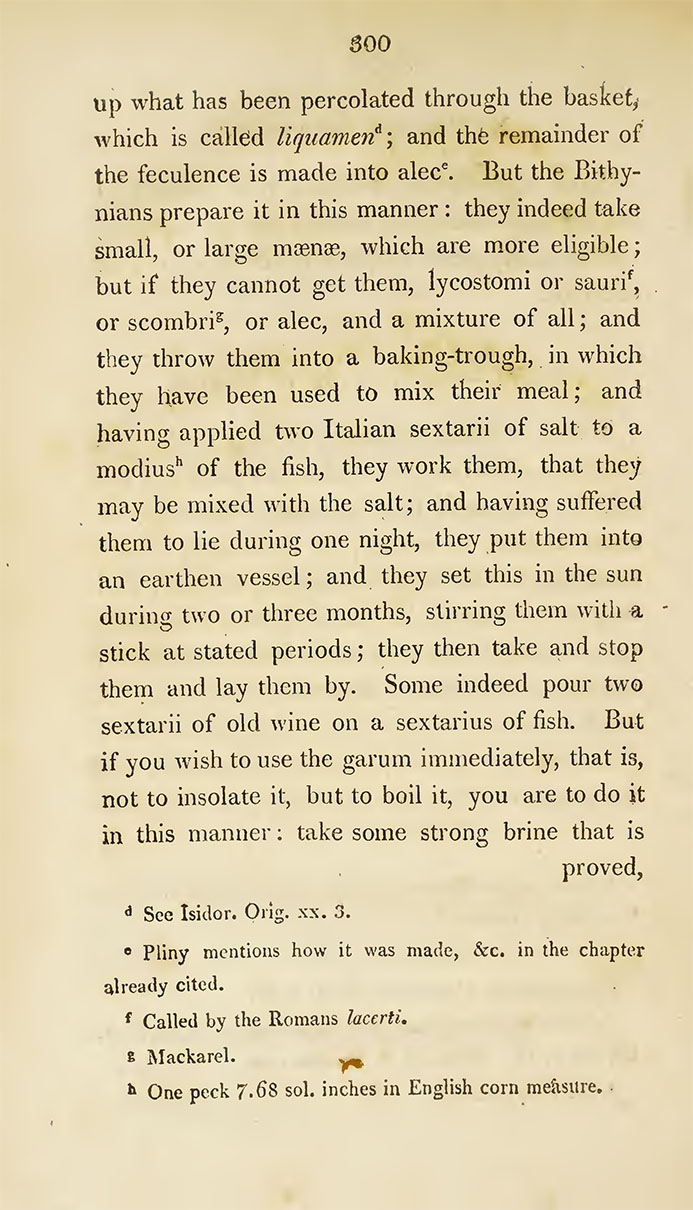
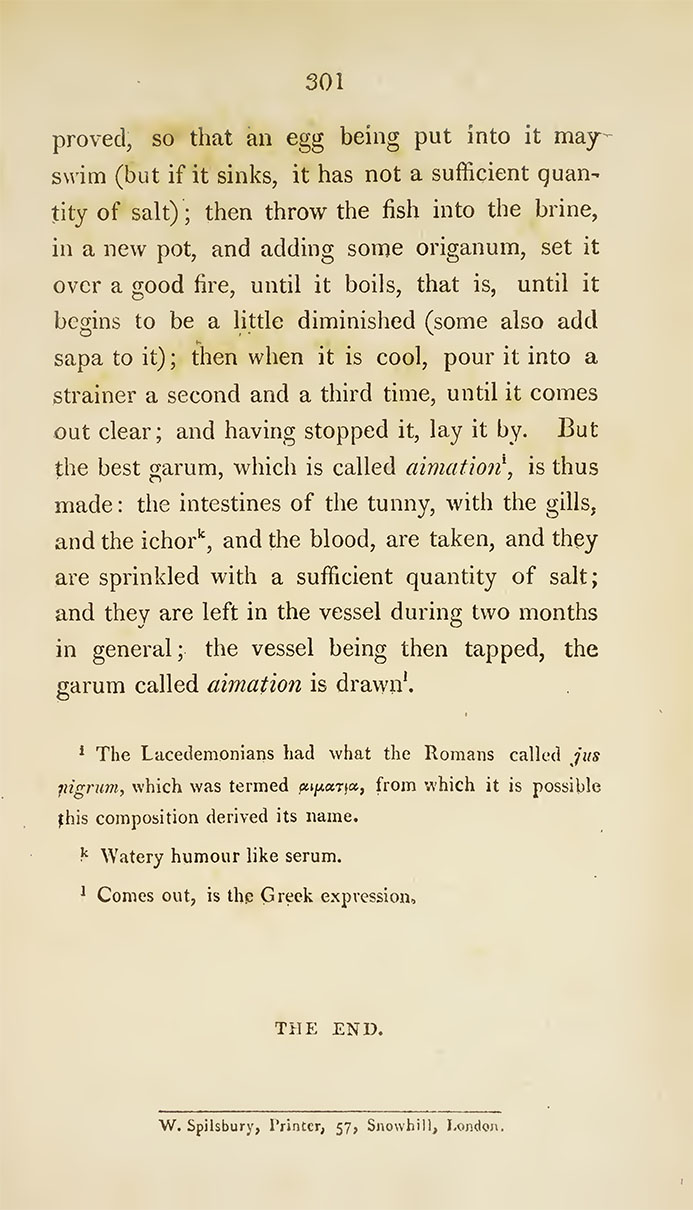
XLVI
Making gara
1. The so-called liquamen is made thus. Fish entrails are put in a container and salted
and little fish, especially sand-smelt or small red mullet or mendole or anchovy, or any small enough, are all similarly salted; and left to pickle in the sun, stirring frequently.
2. When the heat has pickled them, the garos is got from them thus: a deep close-woven basket is inserted into the centre of the vessel containing these fish, and the garos flows into the basket. This, then, is how the liquamen is obtained by filtering through the basket; the residue makes alix.
3. The Bithynians make it thus. Take preferably small or large mendole, or, if none, anchovy or scad or mackerel, or also alix, and a mixture of all these, and put them into a baker’s bowl of the kind in which dough is kneaded; to one modios of fish knead in 6 Italian pints pints of salt so that it is well mixed with the fish, and leaving it overnight put it in an earthenware vessel and leave it uncovered in the sun for 2 or 3 months, occasionally stirring with a stick, then take [the fluid?], cover and store.
4. Some add 2 pints of old wine to each pint of fish.
5. If you want to use the garon at once, that is, not by ageing in the sun but by cooking, make it thus. Into pure brine, which you have tested by floating an egg in it (if it sinks, the brine is not salty enough) in a new bowl, put the fish; add oregano; place over a sufficient fire, until it boils, that is, until it begins to reduce a little. Some also add grape syrup. Then cool and filter it; filter a second and a third time until it runs clear; cover and store.
6A rather high quality garos, called haimation, is made thus. Take tunny entrails with the gills, fluid and blood, sprinkle with sufficient salt, leave in a vessel for two months at the most; then pierce the jar, and the garos called haimation flows out.
23. Garum was a fish sauce resulting from the maceration of certain fish in the presence of an antiseptic, in this case salt. It was a condiment much appreciated in ancient times.
read more
P. Grimal e Th. Monod, “Sur la véritable nature du Garumm” REA, 54 (1952), pp. 27-38; J. Andre, L´alimentation … pp.195-198;
R. Curtis, Garum e Salsamenta. Produção e Comércio em Matéria Médica. Leiden, 1991.
For Hispanic garum, one of the most famous:
M. Ponsich e M. Tarradell, Garum et Industries antiques de la salaison dans la Mediterranee occidentale. Paris, 1965
and
M. Ponsich, Azeite e peixe salgado. Fatores geoeconômicos de Bética e Tingitânia. Madrid, 1988.
24. Liquamen appears mentioned for the first time in the middle of the century. I A.D. (Col. 6,2,7) although the same word is also used to refer to liquids. It is the most Roman fish sauce, which is the most used term to designate these sauces, although this does not mean that the term garum has disappeared. It seems that the only difference is in the use, in the production process, of different fish, usually smaller ones. In this text, the liquamend manufacturing process seems to differ from garum, being the second product of the first.
R. Curtis, cit. pp. 7 e 135. 25 · Allec is a fish sauce that the Romans made. It was the paste, or sediment, that was left at the bottom of the container or barrel that other fish sauces such as garum, liquamen or muria were made in.
Ver R. Curtis, cit. pp. 7-8 e 14. 26 ·
R. Curtis, cit pp. 135 173. CURTlS, R. Garum e Salsamenta. Produção e Comércio em Matéria Médica. Leiden, I 991.
*Sextário A Roman measure of capacity, one sixth of a congius, about 546 ml or approximately one pint.
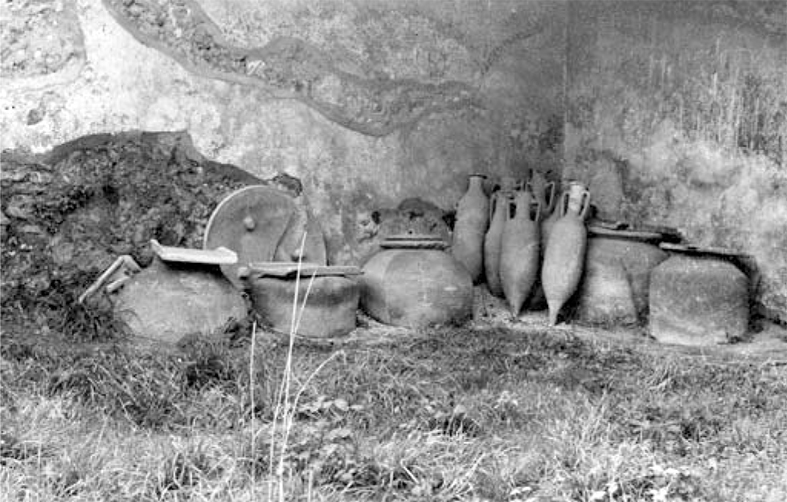
Síntesis de la primera campaña del proyecto hispano-italiano
D. Bernal Universidad de Cádiz D. Cottica
A. Zaccaria Università Ca’ Foscari di Venezia
We present in this paper the project named “From Fishing to Garum at Pompeii and Hercolaneum. Exploitation of marine resources in the Vesubian area”, carried out by the University of Cádiz (south Spain) and the University Ca’ Foscari of Venice (Italy) from 2008 to 2012. The lack of knowledge on this topic in Campania in the last decades is shown by modern scholars who have to use literature dating back to the seven-ties in the 20th century. The three main aims of the project are: gathering all evidences on ancient fishing in these campanian cities, trying to reconstruct ancient fishing gear and the spcies fished and eaten daily (by the compilation and study of fishing equipment –hooks, weights, etc.-, archaeozoological data –fish bones and marine shells- & pictorial evidence –mosaics, etc.-); secondly, studying all data related to fishprocessing, such as regional garum amphorae and related vessels as the well known Scaurus’ urcei, as well as analysing their paleo-contents, and the buildings inside the city related to those activities, such as the House of A. Umbricius Scau-rus (VII, Insula Occidentalis, 12-15) and the so called “Garum Shop” (I, 12, 8). At last a medium-term synthesis on the ma-ritime economy of Pompeii and Hercolaneum should be pre-sented. All activities developed during the first archaeologi-cal season in 2008 are presented, showing the first results of the project and other complementary activities such as the collaboration in the Venetian Regio V project (archaeological trench named Saggio 3 placed in V, 4, 3) and the making of a documentary on methodology of the archaeological research.
Antecedentes. De la pesca y la industria en ámbito campano
El entorno vesubiano es un ambiente especialmente sensible y bien atendido por la investigación arqueológica, que desde el siglo XIX se convirtió en epicentro de la investigación internacional, por el excepcional estado de conservación de sus evidencias. Dicha tónica científica se ha mantenido de manera prácticamente constante hasta la actualidad, gozando en la última década de una especial vitalidad, como denotan los dos Congresos Internacionales en los cuales se han dado a conocer las principales novedades de la investigación (Guzzo y Guidobaldi, 2005 y 2007). No obstante, las tendencias “historiográficas”, como se puede documentar a vuelaplu-ma en los dos volúmenes citados, han focalizado la atención en los principales temas por los cuales estas ciudades del entorno campano son excepcionales, sobre todo su topogra-fía y urbanismo, la pintura/musivaria y aspectos diversos de tipo socio-económico y de la vida cotidiana. Adicionalmente, los proyectos internacionales en curso de desarrollo tienden a centrarse en uno o varios inmuebles de la ciudad de Pompeya (normalmente una “casa” o una insula completa), procediendo a su contextualización e interpretación histórica, ya que son múltiples los ambientes excavados de antiguo necesitados de una revisión científica en profundidad.
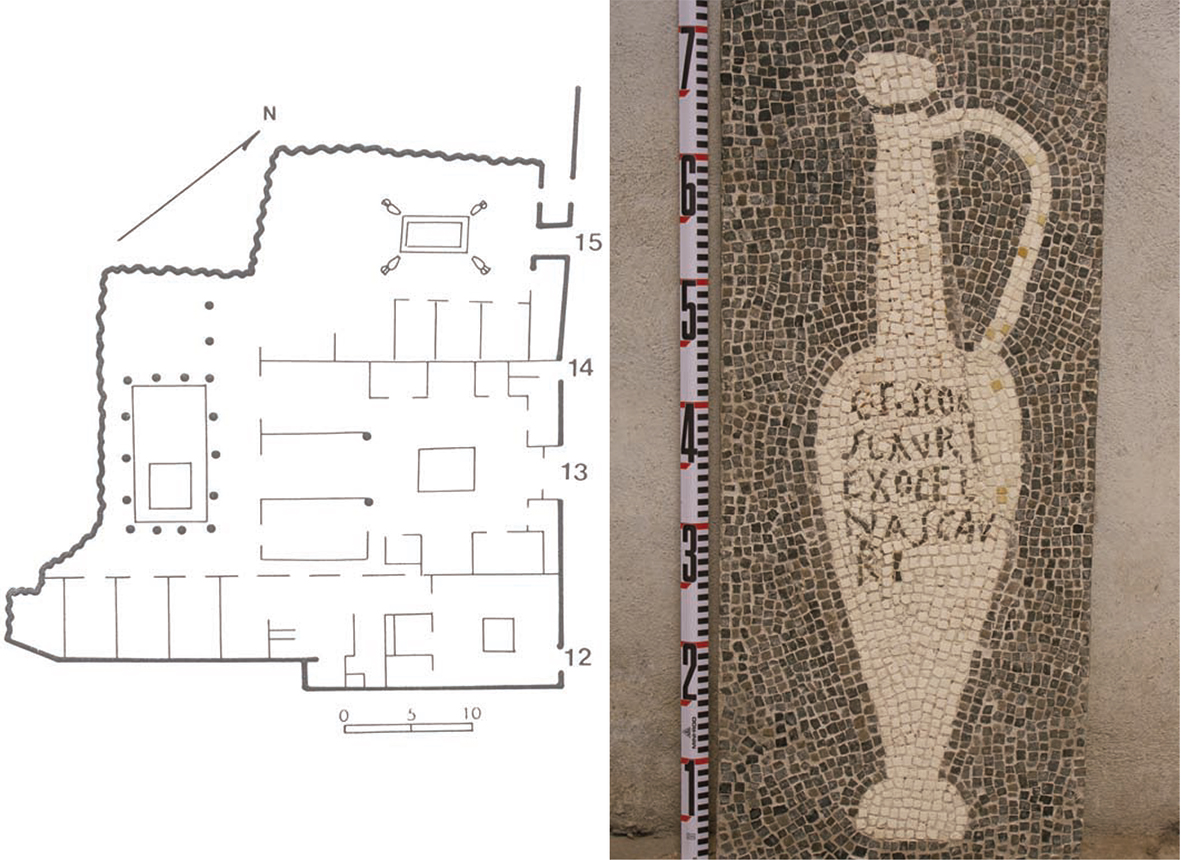
Figs. 1A y 1B Casa de A. Umbricius Scaurus según Curtis (1991, 93, fig. 5), con los conocidos mosaicos del atrio, actualmente en las dependencias de la Soprintendenza (nº inv. SAP 15190).
A pesar del elevado nivel de conocimientos sobre múltiples aspectos de Pompeya y Herculano, hay otras parcelas de Historia Económica que se encuentran aún en estado embrionario. Tal es el caso de la Historia Marítima del golfo napolitano, de su vinculación con el mar y de la problemática de la implicación de estas comunidades en las actividades haliéuticas. En este contexto encontramos mínimas referencias a estudios centrados específicamente en la pesca en la Antigüedad, habiéndose centrado los trabajos precedentes en la valoración general de los registros ictiológicos y malacológicos conservados de las antiguas excavaciones y su conexión con la información iconográfica, procedente básicamente de la pintura y de los mosaicos, como se puede comprobar en los trabajos más recientes sobre el yacimiento (Genovese, Cocca, Russo, 2001; Reese, 2002 a y 2002 b; Carannante, Chilardi, Della Vecchia, 2009). En múltiples estudios sobre la ciudad campana y su entorno se han dado a conocer piezas relacionadas con la pesca y la explotación de recursos del mar —anzuelos o restos de fauna marina normalmente—, como en la monografía Cibi e sapori a Pompei e dintorni (AA.VV., 2005, fichas 89-91, 96-100, 102, 120, 121), si bien los mismos se han tratado siempre de manera aislada y puntual. Respecto a la elaboración de garum y otras conservas de origen piscícola, contamos con numerosos trabajos de R. I. Curtis, realizados especialmente en los años setenta e inicios de los ochenta del siglo pasado (1979 a, b y c; 1984 a y b), aunque matizados con posterioridad en otras síntesis (Curtis, 1988-89; 1991, 90-96). Y evidentemente sin olvidar la aportación de la anforología al conocimiento del comercio de salsas de pescado en Pompeya, procedentes mayoritariamente de Hispania (Manacorda, 1977), y el excepcional corpus de inscripciones pintadas —tituli picti— recuperadas en las antiguas excavaciones (Schöne, 1871; Mau, 1909), que junto al volu-men del C. I. L. de Roma siguen constituyendo las colecciones epigráficas más nutridas para la caracterización del garum y de las diversas variedades de salsas de pescado confeccionadas y consumidas en el Mare Nostrum. Tampoco debemos olvidar los trabajos en torno a A. Umbricius Scaurus, uno de los comerciantes conserveros más conocidos de la Antigüedad precisamente gracias a los mosaicos que ornamentaban el atrio de su casa sita en el civico 15 de la insula Occidentalis (Fig. 1A), en los cuales se representaron urcei con inscripcio-nes alusivas al liquamen y a la “flor del garum de escómbrido” (Fig. 1B) elaborado según una “receta” singular —ex officina scauri—, sobre lo cual han corrido ríos de tinta (Etienne y Mayet, 1991; Curtis, 1991), ya que no existen ejemplos simi-lares en todo el Mundo Antiguo. A pesar de la cantidad de información disponible, los estudios más recientes denotan la escasez de evidencias empíricas sobre la industria conservera local/regional (Bernal, 2007), y la constante recurrencia a tópicos en la interpretación de la economía de las ciudades campanas en los análisis de las industrias haliéuticas de la Italia romana (Marzanno, 2007). En este contexto, se iniciaron una serie de colaboraciones científicas en el año 2007 entre la Università Ca’ Foscari de Venecia (en adelante, UNIVE) y la Universidad de Cádiz (en adelante, UCA), plasmadas en la colaboración de esta última en el estudio de las ánforas del proyecto “Impianto Elettrico”, un singular proyecto de catalogación patrimonial liderado por los colegas venecianos de las primeras excavaciones estratigráficas realizadas en Pompeya en los años ochenta del siglo pasado (Cottica y Curti, 2007). Dicha colaboración internacional ha generado unos vínculos estables de investigación, que se han concretado recientemente en la firma de un Convenio de Colaboración rubricado por los Rectores de ambas instituciones para los próximos seis años, con el objetivo de desarrollar “Excavaciones arqueológicas e investigaciones interdisciplinares en Pompeya y en el área vesubiana”.
En este contexto de colaboración se sitúa el proyecto que presentamos a continuación, que aúna a un equipo de investigación español (integrado en el Grupo HUM-440 del IV Plan Andaluz de Investigación de la Junta de Andalucía) especializado en arqueología marítima; y un equipo italiano con muchos años de experiencia en Pompeya, responsable actualmente de varios proyectos centrados en el estudio de las transformaciones del paisaje urbano y del ambiente económico en la Regio V y en la Regio VI (Zaccaria Ruggiu, 2006; Zaccaria y Maratini, 2007). Una de las especificidades de este proyecto hispano-italiano es el intercambio de docentes y de estudiantes —a través del Programa Erasmus, activado entre ambas universidades desde el año 2008— y de la transferen-cia tecnológica y el intercambio de experiencias. El equipo de investigación español constituye uno de los más consolidados en España en Arqueología de la Pesca y en la problemática de la industria pesquero-conservera en el Mundo Antiguo, con más de una década de trabajos y estudios histórico-arqueoló-gicos en torno a esta temática (recientemente Bernal, 2006 y 2009, ed.; Lagóstena, Bernal y Arévalo, 2007, eds.), con directa implicación en la dirección de las excavaciones excavaciones arqueológicas y en los estudios de algunos de los yacimientos pesquero-conserveros mejor conocidos de Hispania, como es el caso de las factorías de salazones de Baelo-Claudia (Arévalo y Bernal, 2007, eds.), el barrio conservero urbano de Iulia Traducta (Algeciras), los alfares y factorías salazoneras de Villa Victoria/Carteia (San Roque) en la orilla norte del Estrecho de Gibraltar; o las cetariae de Septem Fratres (Ceuta) y algunos yacimientos marroquíes como Metrouna en la Mauretania Tingitana. Las perspectivas de análisis y de comparación de los modelos económicos potencialmente aplica-bles al área campana son notables a través del proyecto de investigación planteado.
Un singular proyecto italo-español. Planteamiento y objetivos
El formato de colaboración elegido ha sido un proyecto de investigación bilateral, que aúne investigadores de ambas instituciones, y con un plazo de ejecución quinquenal, iniciado en el año 2008. La temática, “Pesca y garum en Pompeya y Herculano. La explotación de recursos del mar en ámbito vesubiano”, trata de desarrollar tres objetivos generales: — Recopilación y estudio arqueológico de todas las evidencias sobre la pesca en Pompeya y Herculano, con el objetivo de realizar una aproximación histórico-arqueológica precisa sobre las técnicas de pesca y los productos obtenidos del mar. — Recopilación y estudio arqueológico de todas las evidencias sobre la elaboración de conservas de pescado (Garum, salsamenta y otros derivados) en ambas ciudades, con el objeto de rastrear la repercusión de los mismos sobre la paleodieta y el comercio de dichos productos piscícolas en el Imperio por parte de las ciudades vesubianas. — Realizar una síntesis a medio plazo sobre la economía marítima de Pompeya y Herculano y de todos los aspectos relacionados con la explotación de los recursos marinos por ambas ciudades campanas. Para acometer los objetivos anteriormente esbozados y una vez obtenido el pertinente permiso de la Soprintendenza Archeologica di Pompei (en adelante, SAP) se plantean las si-guientes actividades científicas, vinculadas a cada uno.
Objetivo 1 (Pesca)
1.- Inventario y estudio del instrumental pesquero (básicamente anzuelos, pesas de red de plomo/cerámica/piedra, agujas para la reparación de redes y cualquier otro instrumental asociado, incluidos restos de redes).
2.- Inventario y estudio arqueozoológico de los restos de fauna marina existentes (ictiológicos, malacológicos y de otra naturaleza —corales, etc…—).
3.- Inventario y estudio de los restos muebles e inmuebles con iconografía marina, como complemento al estudio de la fauna (mosaicos, pinturas, etc…).
4.- Inventario de las piscinas utilizadas en los ambientes domésticos para el mantenimiento y posible engorde del pescado, es decir para tareas de acuicultura. Contamos con casi una decena de ejemplos recogidos recientemente, incluyendo algunas piscinas con oquedades para permitir guarecerse a los peces, como la del jardín de la casa VIII, 2, 14 (según Reese, 2002 a, 274-275 y figura 225).
Objetivo 2 (Salazones y salsas de pescado)
1.- Inventario y estudio de las ánforas y otros elementos cerámicos o de otra naturaleza (vítreos o metálicos) utilizados para envasar las salsas de origen local campano. Básicamente las denominadas ánforas del tipo Dr. 21/22, recientemente sistematizadas (Botte, 2007, 2008, 2009 a y b), los urcei del grupo de Umbricius Scaurus y otros con restos de preparados piscícolas —dolia o vasijas diversas, algunas con conservas en su interior— (AA.VV., 2005, 87 y 92).
2.- Inventario y estudio de los ambientes pompeyanos relacionados con el procesado/venta de pescado y con los responsables de la comercialización. Al menos, contamos apriorísticamente con dos ejemplos, que son la Casa de A. Umbricius Scaurus (VII, Insula Occidentalis, 12-15) y la denominada “Tienda del Garum (I, 12, 8), esta última de especial interés.
El tercer objetivo se desarrollará a medio plazo, cuando se ultime el proyecto y una vez que se disponga de los resultados científicos del mismo. En cuanto a la metodología de investigación arqueológica, y además de las estrategias tradicionales en el estudio de materiales arqueológicos muebles —el dibujo, la documentación gráfica y la toma de muestras—, está prevista la realización de estudios arqueométricos, especialmente en los que se refiere a la caracterización de restos físicos de paleocon-tenidos (como es el caso de los estudios arqueozoológicos, como por ejemplo de los restos de conserva de peces en un ánfora precisamente de la Tienda del Garum, ambiente 13; AA. VV., 2005, 87), así como analíticas orgánicas en envases relacionados potencialmente con conservas de origen piscícola, caso de los conocidos urcei de Umbricius Scaurus (AA.VV., 2005, 88, ficha 100) o los dolios utilizados aparen-temente para las conservas. El estudio de los ambientes inmuebles, adaptado a las exigencias habituales de la arqueología moderna, incluirá la topografía detallada de los ambientes, el estudio paramental y arqueo-arquitectónico y, en caso necesario, sondeos estratigráficos para la datación de los ambientes, todo ello bajo autorización expresa de la SAP. Ello ha conllevado la conformación de un equipo permanente conformado por arqueólogos, arqueozoólogos —ictiólogos y malacólogos—, arqueobotánicos, químicos.
La campaña del año 2008. Actividades y resultados preliminares
La campaña del año 2008 ha contado con la financiación por parte española del Ministerio de Cultura, a través del programa de Proyectos Arqueológicos en el Exterior, así como con la colaboración de la Fundación Pouroulis (Contrato OT2007/ 130 de la Universidad de Cádiz); asimismo a través de diversos proyectos PRINN financiados por el gobierno italiano.
Las actividades se han desarrollado entre mediados de junio y mediados de julio del año 2008, habiendo trabajado conjuntamente los investigadores italo-españoles. El equipo de trabajo ha estado coordinado por los tres codirectores—Dr. D. Bernal, Profesor Titular de Arqueología del Departamento de Historia, Geografía y Filosofía de la UCA y las Dras. D. Cottica y A. Zaccaria, Profesoras de Arqueología del Departamento de Ciencias de la Antigüedad y del Próximo Oriente de la UNIVE— Además de la colaboración puntual de otros investigadores y alumnos, han formado parte del equipo permanente las doctorandas italianas C. Acqua y E. Cappelletto, de Venecia. Por parte de la UCA han partici-pado la Dra. A. Arévalo, Profesora Titular de Arqueología, y los doctorandos y Becarios de Investigación de esta institución M. Bustamante, J. J. Díaz, J. Lagóstena y A. M. Sáez, así como los licenciados M. Lara y J. Vargas. Han participado asimismo investigadores de otras instituciones españolas, concretamente J. Bermejo, doctorando y Becario de Investigación de la Universidad de Huelva, F. Villada Paredes, Arqueólogo Municipal de la Ciudad Autónoma de Ceuta, R. Jiménez-Camino, Arqueólogo Municipal de la ciudad de Algeciras (Cádiz), L. Lorenzo, Gerente de Figlina, Gabinete de Arqueología, Desarrollo y Servicios del Patrimonio Cultural S. L. y A. Pouroulis, por parte de la Fundación Pouroulis. Agradecemos muy especialmente a P. G. Guzzo, Superintendente de la SAP de Pompeya, y a M. P. Guidobaldi, responsable de Herculano, su amabilidad y predisposición para el avance del proyecto. Asimismo, en Pompeya, a A. D’Ambrosio y al restante personal de la SAP por su eficaz gestión y ayuda en todo momento, muy especialmente a G. Di Martino y al Sr. Cesarano por su permanente disponibilidad, así como a los conserjes y responsables de la tutela de los bienes muebles e inmuebles. En Herculano, la amabilidad del Sr. Sirano ha permitido que el trabajo fuese muy cordial y agradable y, adicionalmente, tremendamente operativo.
Indicar, por último, que las actividades realizadas han constituido una primera toma de contacto con las instituciones gestoras del patrimonio y, especialmente, con los diferentes departamentos, laboratorios, almacenes y dependencias en las cuales se articula la SAP. Como se verá a continuación sucintamente, dicha atomización ha complicado el proceso de rastreo documental, por lo que buena parte de las actividades iniciadas en la primera anualidad deberán ser continuadas en futuras campañas del proyecto.
Las actividades realizadas pueden ser divididas en dos grandes grupos. De una parte, una serie de actuaciones vinculadas con la obtención de documentación sobre la industria pesquero-conservera en ámbito vesubiano, que han permitido una toma de contacto con los dos yacimientos objeto de estudio (Pompeya y Herculano) y con su problemática científica y el volumen de documentación disponible. De todo ello trataremos de dar cuenta sucintamente en las páginas que siguen. Sí queremos indicar que esta primera campaña ha constituido un acercamiento preliminar, habiendo testado la potencialidad de las líneas de trabajo previstas en el proyecto de investigación aprobado por la SAP, y, especialmente, la correcta valoración de las líneas de investigación y actuaciones a desarrollar en el futuro. Sí se ha podido valorar in situ tanto la viabilidad del proyecto como el interés científico del mismo, por lo que se ha decidido llevar a buen término la programación planteada inicialmente, que es quinquenal (2008-2012). Por otro lado, y de manera complementaria, la parte española del equipo ha desarrollado una colaboración en el proyecto Regio V de la Universidad de Venecia, materializada en la ejecución de una actividad arqueológica puntual —sondeo estratigráfico— en una de las insulae objeto de estudio por el equipo italiano, con el objetivo de generar un documental didáctico sobre metodología de investigación arqueológica, como veremos más adelante.
Actividades arqueológicas en Pompeya
El material arqueológico mueble de Pompeya está depositado en diversas dependencias aisladas, así como la documentación administrativa relativa a las excavaciones arqueológicas y la bibliografía publicada relativa a temas campanos. De ahí que se hayan tenido que arbitrar diversos grupos de trabajo paralelos que han desarrollado su actividad tanto en las dependencias administrativas de la SAP en Pompeya (Biblioteca y Archivo) como en los Laboratorios (Ciencias Aplicadas), en los almacenes (Casa de Bacco y Graneros del Foro) y en algunos de los inmuebles del propio yacimiento (Tienda del Garum y Casa de Umbricius Scaurus). Ha sido necesario incluso desplazarse a almacenes e instalaciones situadas fuera del propio yacimiento, como sucede con el Antiquarium de Boscoreale. De ahí que logísticamente la obtención de la información haya sido más compleja de lo habitual y su homogeneización será difícil, al encontrarse la misma dispersa, no sistematizada y con diver-so gradiente de accesibilidad. A continuación presentamos un balance sucinto de cada una de las actividades desarrolladas.
En relación a la documentación en la Biblioteca de la SAP, la ingente actividad científica en esta ciudad vesubiana desde el s. XVIII ha generado un caudal informativo copiosísimo. Una buena parte del mismo no está inserto en los canales de distribución científicos debido en parte a su antigüedad, como sucede con trabajos como el de Helbig (1868), que necesitan de una atenta lectura y escrutinio de cara a la obtención de datos sobre la explotación de recursos marinos. En otras ocasiones la publicación de las Notizie degli Scavi o de informaciones diversas en foros de difusión local/regional han provocado su desconocimiento por parte de la comunidad científica internacional. A esta tarea se han dedicado tres investigadores en turnos rotativos, que han realizado un vaciado sistemático de la Biblioteca de Pompeya, con interesantes resultados, pues en ocasiones constituyen las únicas referencias disponibles sobre hallazgos de instrumental pesquero, ánforas de transporte o iconografía marina que no se conocen por otro tipo de fuentes. Esta actividad ha sido iniciada, si bien la amplitud de la información editada requiere futuros acercamientos en detalle a esta problemática. Se ha procedido a realizar una primera Base de Datos exhaustiva de títulos bibliográficos de interés para el proyecto, más allá de los monográficos sobre la pesca o las conservas de Pompeya/Herculano ya conocidos previamente, escaneando/fotografiando el material más significativo, al tratarse en muchos casos de obras de difícil acceso. Las múltiples referencias obtenidas son de gran interés para la reconstrucción de los ambientes objeto de estudio como la “Tienda del Garum” y, en otras ocasiones, claves para la identificación de la procedencia topográfica de mucho material mueble, actualmente descontextualizado, conservado en los almacenes de la SAP. Se ha llevado a cabo un Diario de Trabajo con el control de todo el proceso de documentación, procediendo a la ejecución de visitas de campo puntuales destinadas a verificaciones diversas. Algunos de los trabajos consultados han sido de gran interés en relación al inicio de la línea de rastreo iconográfico, tratando de sistematizar todo el instrumental o la musivaria/pintura con temas marinos y/o pesqueros, como sucede con el conocido trabajo de Della Corte (1955). Por último, se ha iniciado el vaciado documental de los expedientes informatizados de la SAP, con interesantes resultados. La valoración del escrutinio bibliográfico ha sido altamente satisfactoria, habiendo permitido una primera aproximación a las temáticas objeto de estudio y habiendo aportado mucha información para contextualizar materiales arqueológicos vinculados con la pesca desconocidos previamente y, en algunos casos, no localizados actualmente en los inventarios de la SAP. En los Archivos de la SAP se han acometido labores análogas. Dispersos por varias instituciones, básicamente en la zona de oficias del yacimiento y en el interior de los “Uficci Scavi” se ha procedido a la revisión del material documental de diversa naturaleza, especialmente los libros de inventario y/o diarios de excavación inéditos y manuscritos (Fig. 2). Algunos de los diarios de excavación se encuentran informatizados y transcritos, mientras que en otras ocasiones la con-sulta de los mismos es manual, siendo un proceso lento y muy detallado. El vaciado sistemático de algunos de los libros de inventario ha proporcionado información de primera ma-no, como sucede con los diversos taxones de fauna marina —especialmente malacológicos— y restos de instrumental pesquero referidos en el Libro 4 del Anticuario Pompeiano (Vetrina 14, pp. 186-199, nº inventarios 1349-1519). Otro de los resultados interesantes del trabajo en los archivos ha sido la documentación de multitud de material gráfico y fotográfico de las antiguas excavaciones acometidas en los ambientes objeto de atención por parte del proyecto. Un buen ejemplo es el de la “Tienda del Garum”, inmueble del cual se ha podido rescatar parte del material fotográfico de las antiguas excavaciones en los años sesenta del siglo pasado así como de diversas intervenciones posteriores de la SAP en este ambiente (Fig. 3), que permiten contextualizar los hallazgos de ánforas y dolia en su interior.
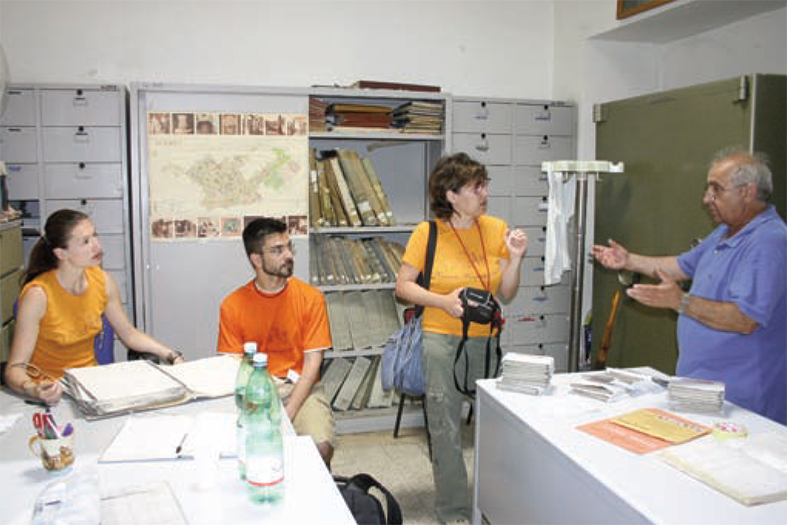
Fig. 2 Detalle del proceso de revisión y transcripción de la documentación original de los diarios de excavación (Casa di Bacco, Pompeya).

Fig. 3 Fotografía del Ambiente 9 de la “Tienda del Garum” (I, XII, 8), con los dolia y ánforas in situ (Archivo de la SAP).
Especialmente interesantes son una serie de bocetos, realizados por M. Oliva, cuyo estudio en curso permitirá en su momento la reconstrucción del ambiente arqueológico inmediatamente tras la finalización de las excavaciones en este inmueble por A. Maiuri (Fig. 4).
Se han realizado los contactos pertinentes con la Directora del Laboratorio de Ciencias Aplicadas de la SAP, Dra. A. M. Ciarallo, de cara a iniciar vías de colaboración. Además de una serie de visitas de cara al conocimiento de la colección de biofactos, se iniciaron los contactos con diver-sos colegas arqueozoólogos y biólogos de Nápoles para futuros trabajos conjuntos. Especialmente significativa es la colección de malacofauna procedente de las antiguas excavaciones (Fig. 5), en parte accesible desde la red, si bien las referencias topográficas y contextuales de una buena parte de los ejemplares son mínimas o inexistentes.
Asimismo, se iniciaron los estudios de localización, inventario y estudio preliminar del material arqueológico depositado en los almacenes de Pompeya, De una parte, se comenzaron los trabajos en la denominada “Casa di Bacco”, donde actualmente se encuentra la Dirección de las Excavaciones y otras dependencias administrativas, así como los ficheros con la información del material mueble inventariado preliminar mente. En primer lugar se ha procedido al vaciado selectivo de las fichas de inventario (“schede”), tratando de aislar ma-teriales objeto de interés por las descripciones temáticas y/o las ilustraciones. Especial interés se ha demostrado hacia el utillaje de pesca, las ánforas de producción local/regional, los restos de fauna o los elementos musivos o de otra naturale-za depositados en estas dependencias —como los conocidos mosaicos de la casa de A. Umbricius Scaurus— Debido a las características de los depósitos/almacenes, en los cuales el material custodiado es el especialmente relevante/selecto, los resultados positivos han sido los relacionados con materiales metálicos, destacando especialmente los anzuelos, las agujas de reparar redes/lanzaderas, las pesas plúmbeas, algunas relacionables con redes/artefactos pesqueros (Fig. 6).
Debido a la ingente cantidad de materiales y especialmente a la dificultad de acceso a los mismos, se decidió proceder a una primera selección de cara a su estudio, que ascendió a unos 50 ejemplares entre anzuelos y lanzaderas, procedentes en su mayor parte del ámbito periurbano (Pago Marittimo). Por su parte, en los almacenes conocidos como “Granai del Foro” se realizó un escrutinio de las procedencias del material mueble procedente de la “Tienda del Garum”, pues contábamos con información oral y gráfica del inventariado de parte de las ánforas de estas dependencias en los años noventa del siglo pasado. Especialmente interesante fue la documentación de parte del material de la “pila” de ánforas procedentes del Ambiente 13 de la “Tienda del Garum”, cuyo proceso de reubicación en los ambientes de procedencia pudo ser iniciado. Como ya se ha indicado anteriormente, se realizó el vaciado del Antiquarium de Boscoreale, un Museo de Sitio en el entorno periurbano de Pompeya en el cual la exposición permanente gira en torno a las relaciones hombre-medio, documentándose diversas evidencias relacionadas con los temas marinos. De una parte una interesante colección malacológica y en menor medida ictiológica, que ha sido debidamente inventariada y estudiada por nuestro equipo. Además de ello, se han estudiado aparejos de pesca broncíneos procedentes de diversas localizaciones y, especialmente, se han muestreado algunas ánforas que aún conservaban restos de sus paleocontenidos originales, concretamente el tercio inferior de una Dr. 21/22 (Fig. 7) y un ánfora oriental, cuya importancia es capital, ya que no superan la cifra de 50 las ánforas con este tipo de evidencias procedentes del Mediterráneo. Estos restos están actualmente en proceso de caracterización arqueozoológica por parte de los colegas C. G. Rodríguez Santana y R. Marlasca. De excepcional interés ha sido la localización de 13 fragmentos de una posible red de pesca, procedentes de la “Casa dell’Albergo” de Herculano, ya que son escasísimos los restos físicos de redes romanas conservadas, que no llegan a una decena en ámbito mediterráneo, cuyo muestreo de cara a la determinación del tipo de fibra utilizada ha sido realizado.
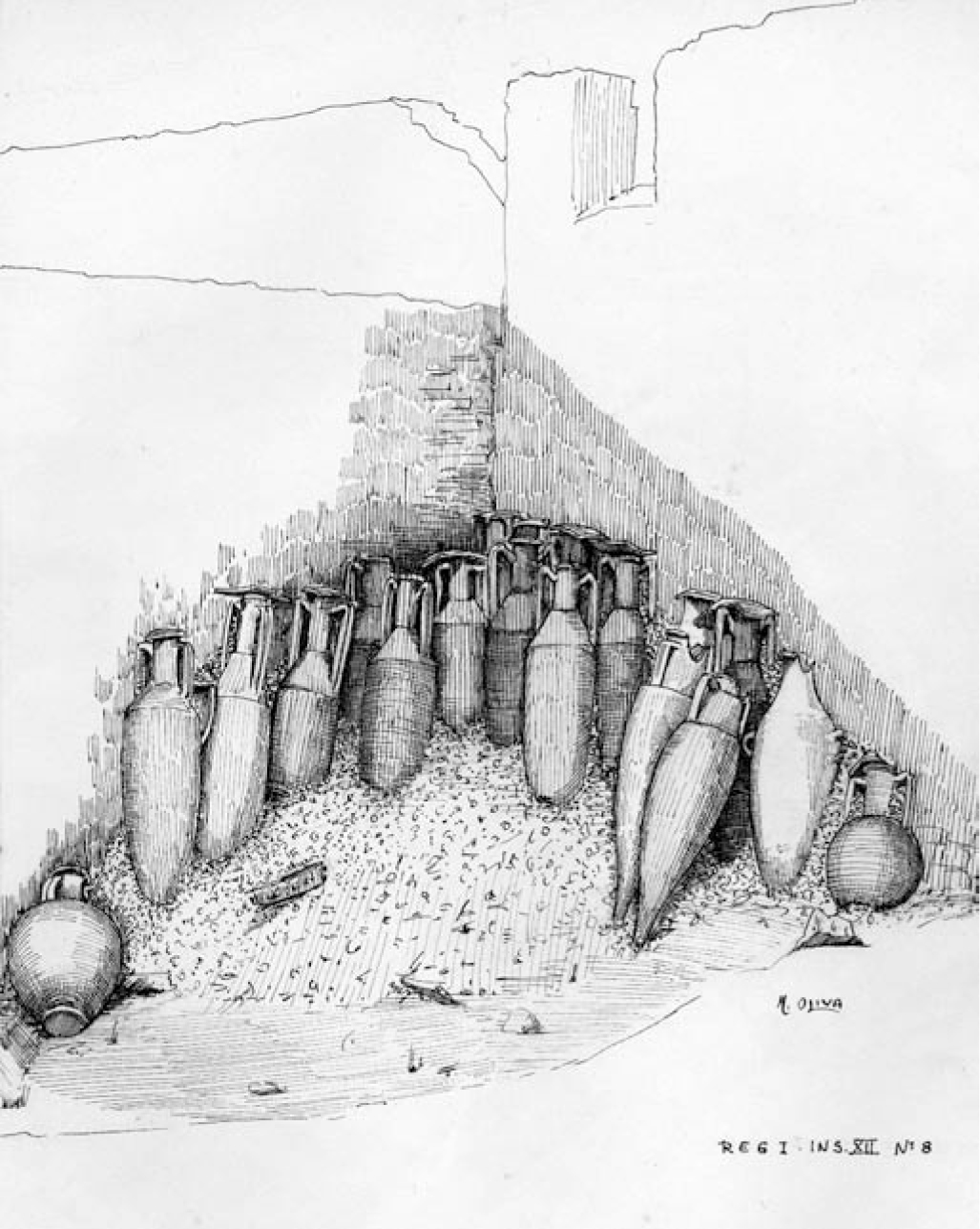
Fig. 4 Boceto a plumilla del Ambiente 13 de la “Tienda del Garum” (I, XII, 8), con una acumulación de ánforas mayoritariamente vinarias in situ, ac-tualmente en los almacenes de la Soprintendenza (Archivo de la SAP).
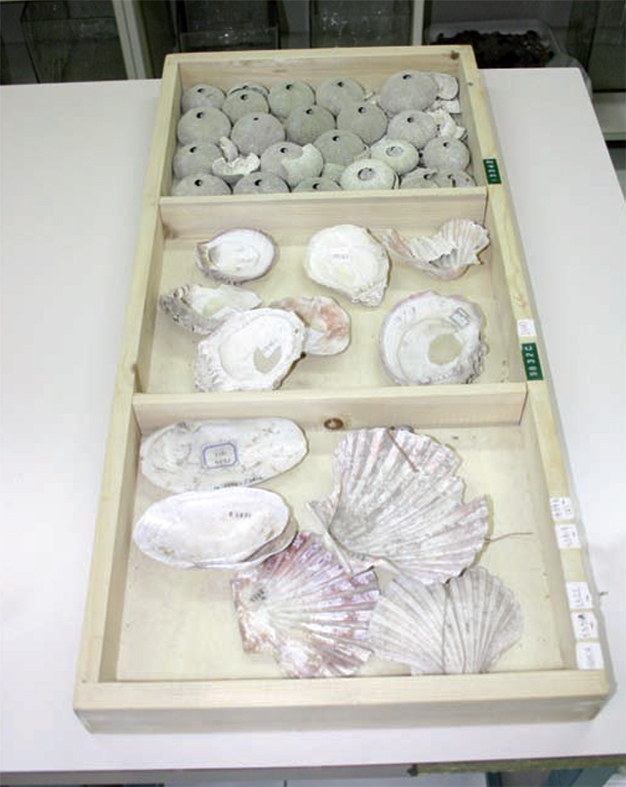
Fig. 5 Selección de malacofauna conservada en el Laboratorio de Ciencias Aplicadas de Pompeya.
De todos los ambientes pompeyanos, el más significativo para el proyecto es la conocida como “Garum Shop” o “Bottega del Garum” (Figs. 3 y 8), ya que su relación con la industria conservera es evidente según confirma el hallazgo en su interior de diversos dolia y algunas ánforas que aún preservaban restos de sus paleocontenidos originales. En este inmueble se realizaron durante la campaña del año 2008 una serie de actividades, consistentes básicamente en la localización en los archivos de la SAP de toda la información relativa a las excavaciones en este inmueble, transformada en ambiente industrial con posterioridad, posiblemente en época neroniana; en el inicio del estudio del material mueble conservado actualmente en su interior. Se trata de los restos en posición primaria —ánforas y especialmente dolios— como restos muebles de pequeñas dimensiones —fundamentalmente pondera— almacenados en diversos ambientes de la casa; y, por último, en la búsqueda y estudio en almacenes y otras dependencias de la SAP de materiales procedentes de este inmueble, desplazados con posterioridad. El resultado ha sido muy esperanzador, ya que la cantidad de documentación existente permitirá en el futuro reposicionar buena parte de los objetos en su ambiente, restituyendo la situación inmediatamente posterior a las excavaciones de Maiuri, y aportando un caudal de información que permitirá en su momento superar las apreciaciones contenidas en los estudios realizados en los años setenta (Curtis, 1979 a). De especial interés ha sido el muestreo de los siete dolios conservados en la tienda de cara a futuros estudios arqueozoológicos y pali-nológicos, estos últimos a cargo de las Dras. B. Ruiz Zapata y M. J. Gil de la Universidad de Alcalá de Henares.
Se ha procedido asimismo a la valoración in situ de la po-tencialidad de la casa de Aulus Umbricius Scaurus (VII, Insula Occidentales, 12-15), que apriorísticamente constituía unos de los ambientes arquitectónicos de mayor interés, dada la notable literatura editada y el conocido pavimento de su atrium con los urcei y las recetas alusivas a las conservas de pescado. No obstante, tras los trabajos de prospección visual en la misma, totalmente excavada, se ha decidido no focalizar la atención a esta cuestión, ya que constituye únicamente la casa de un rico comerciante o negotiator salsamentarius, en la cual la información existente sobre la industria conservera es mínima. No obstante, sí se considera conveniente para el futuro la necesidad de profundizar en el conocimiento de los ambientes cercanos (Casa del Marinaio e inmuebles adyacentes), procurando verificar la existencia de un posible barrio portuario en esta zona en torno a Porta Marina y las Termas Suburbanas.
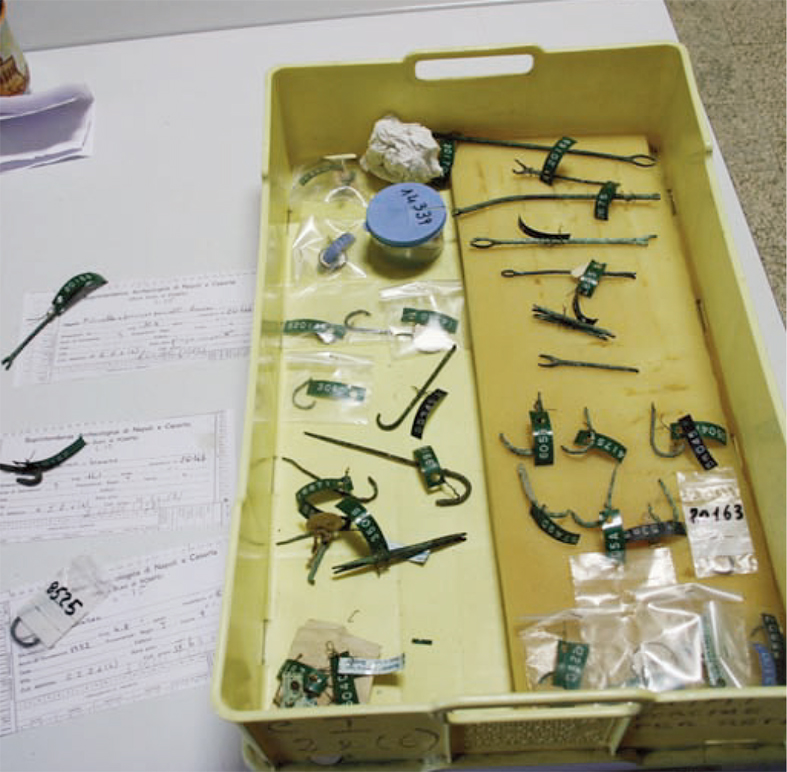
Fig. 6 Instrumental pesquero de Pompeya conservado en la “Casa di Bacco”.
Fig. 7 Tercio inferior de un ánfora Dr. 21/22 con paleocontenido piscícola in situ, muestreada durante la campaña del año 2008 (Antiquarium de Bos-coreale).
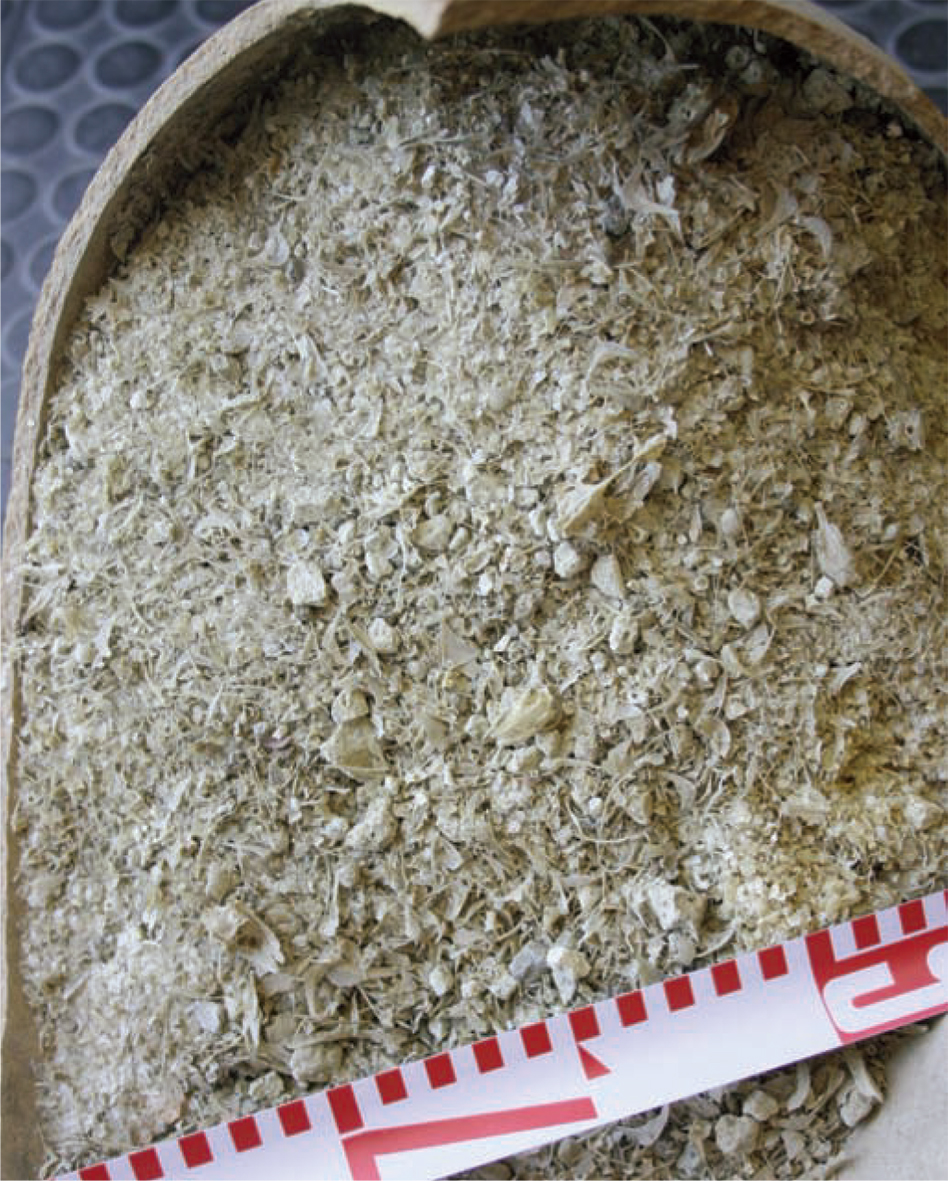
Por último, una de las tareas prácticamente culminada du-rante el año 2008 ha sido el estudio de las ánforas de las primeras excavaciones estratigráficas en el foro de Pompeya, realizadas en 1980-1981, con motivo de la instalación de la acometida eléctrica en la ciudad, a cargo de P. Arthur. El ya mencionado proyecto de catalogación y estudio de todas las clases cerámicas de estas excavaciones a cargo de la UNIVE y la Universidad de Mattera incluye como primera entrega el volumen dedicado a los envases de transporte, el cual será editado en los próximos meses. En el marco del proyecto se ha procedido a la caracterización de residuos orgánicos adheridos a las paredes de las ánforas, a cargo de A. Pecci, de la Universidad de Siena, así como al estudio arqueométrico de las pastas cerámicas de los talleres del Círculo del Estrecho de los cuales podrían proceder algunas de las series anfóricas púnico-gaditanas detectadas en estas excavaciones arqueológicas.
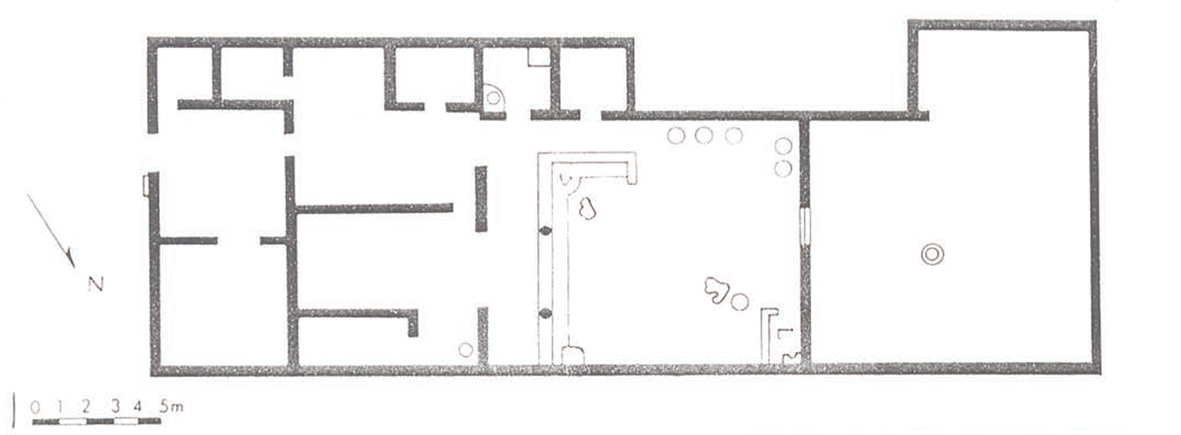
Fig. 8 Planimetría esquemática de la “Tienda del Garum” según Curtis (1991, 94, fig. 6).
Actividades arqueológicas en Herculano
El proceso de documentación y estudio en Herculano ha sido similar al acometido en Pompeya, incluyendo una concatenación de actividades consecutivas (estudio bibliográfico; vaciado de archivos; inventario y estudio en almacenes….), por lo que en general las mismas consideraciones metodológicas aplicadas en el caso de Pompeya son válidas para esta otra ciudad vesubiana. Sí es cierto que los trabajos no han sido tan complejos como en Pompeya, debido a la centralización de los almacenes y dependencias administrativas en este caso. La cantidad de datos bibliográficos recabados y las informaciones procedentes de los Giornali dei Nuovi Scavi di Ercolano han sido notables, documentando como la zona más interesante de todas la parte baja de la ciudad en contacto con la línea de costa, en la cual se recuperaron restos de una embarcación y restos óseos de una treintena de individuos, algunos de ellos posibles pescadores. Se realizó un inventario preliminar de un conjunto aproximado de 500 piezas de interés, incluyendo especialmente pesas —buena parte de telares—(233 ejemplares), anillos plúmbeos (117), restos malacológi-cos (77), anzuelos (55), urcei cerámicos (31), ánforas (19), lanzaderas (18) y en menor medida arpones, agujas o elementos con representaciones iconográficas de tipo marino. De especial utilidad ha sido la consulta de la base de datos y de los archivos gráficos existentes en Herculano, con 4435 registros inventariados en las fechas de consulta. Se ha podido iniciar el estudio arqueológico de parte del material conservado, consistente básicamente en lanzaderas, anzuelos, pesas de red plúmbeas y algunos urcei completos, catalogación preliminar que deberá ser continuada en sucesivas fases del proyecto. De especial interés ha sido la localización de un palangre o “coffa”, conocida en ámbito vesubiano (Pappalar-do, 1990, 202, Fig. 5 A) pero cuya trascendencia en ámbito científico había sido nula. Se trata por el momento del único palangre conocido en todo el Mediterráneo, correspondiente con una cesta circular con tapadera, en cuyo interior se han documentado multitud de anzuelos broncíneos y restos físicos de las fibras que los unían (Fig. 9).
A través del estudio radiológico se ha confirmado la existencia de multitud de anzuelos de pequeñas/medianas dimensiones, que se encon-traban fijados al cabo madre y plegados en el interior de la cesta en el momento de la erupción. Debido a su interés se han muestreado todas las fibras y los restos orgánicos existentes, además de haber procedido al dibujo, pesado y descrip-ción de esta singular arte de pesca, en proceso de estudio actualmente.
Documental “Aprendiendo a excavar en Pompeya”
De manera complementaria al proyecto, se consideró de interés realizar un audiovisual sobre metodología de investigación arqueológica, dada la práctica inexistencia de este tipo de productos multimedia en el mercado actual, al menos documentales bien estructurados desde el punto de vista académico y científico. Su ejecución permitiría disponer de un recurso audiovisual en material arqueológica para ser utilizado por instituciones universitarias, máxime en unos momentos en los cuales el Espacio Europeo de Educación Superior requiere la continua y progresiva implantación de este tipo de recursos auxiliados por las TIC (campus virtual, etc.). Para ello se diseñó un guión tratando de valorar las principales facetas del trabajo de campo —excavación— y de las diversas fases del proceso de investigación arqueológica, desde el planteamiento de la hipótesis a la edición de los resultados. Se aprovechó la ejecución de un sondeo estratigráfico en la Regio V—del que hablaremos sucintamente a continuación— al tratarse de una actividad nueva, ya que no se había excavado en la zona con antelación. Se contó para ello con la empresa BIG THINGS-Colores Virtuales, debido a su dilatada experiencia en temas de museografía y a su intenso contacto con el gremio arqueológico en los últimos años. Un grupo de rodaje de cinco técnicos estuvo con el equipo arqueológico durante dos semanas. Actualmente se dispone de varias horas de filmaciones de materiales arqueológicos diversos, habiendo implicado a diversos técnicos de la SAP para todas las actividades, desde el Superintendente hasta los diversos laboratorios (Restaura-ción, Archivo, Ciencias Aplicadas, etc…) así como a todos los especialistas que colaboraron durante el proceso de investiga-ción arqueológica (sedimentóloga, vulcanólogo, etc…) y, evi-dentemente, a todos los miembros del equipo de investigación hispano-italiano, a cada uno de los cuales se le adjudicó un contenido específico a desarrollar. El trabajo de rodaje ha sido complejo desde el punto de vista logístico, y más aún lo está siendo la producción del documental, que aspira a ser trilingüe (español, italiano e inglés). Se realizó un tráiler del mismo, que fue presentado en octubre de 2008 en la UCA y en noviembre en la Escuela Española de Historia y Arqueología en Roma. Actualmente está en proceso de montaje, estando previsto disponer de la versión definitiva en un futuro cercano.
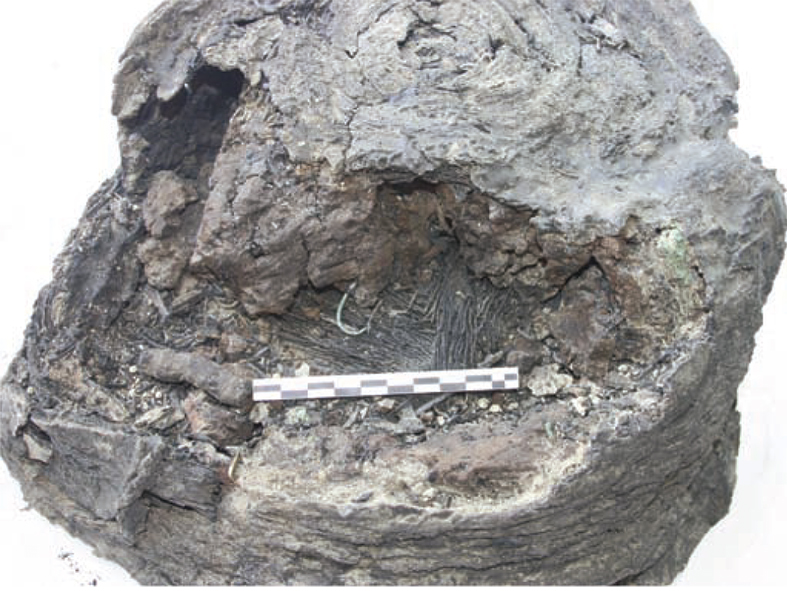
Fig. 9 Palangre de Herculano en el interior de una cesta carbonizada, con múltiples anzuelos y de los cabos de unión entre ellos.
Fig. 10 Vista cenital del Saggio 3 realizado en el marco de la colaboración en el proyecto Regio V (V, 4, 3), con el sistema de drenaje del viridarium (izda.) y las fosas de vertidos (dcha.).
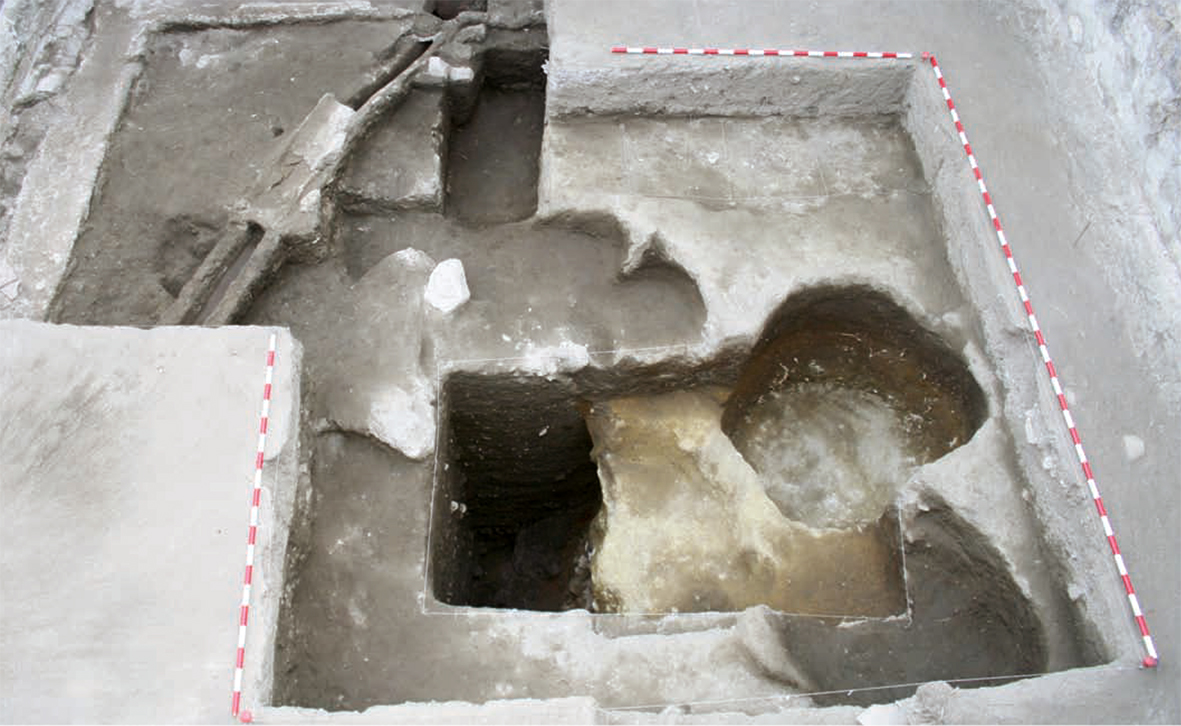
Colaboración en el proyecto Regio V. Resultados del Saggio 3 (V, 4 , 3)
Como se ha comentado en la introducción, se ha ejecutado una intervención arqueológica de excavación en el Civi-co 3 de la Insula 4 de la Regio V, como una colaboración de la UCA en un proyecto dirigido por la UNIVE, centrado en el estudio topográfico-urbanístico y en la valoración de las transformaciones en estos inmuebles pompeyanos en clave diacrónica. Adicionalmente, esta excavación arqueológica ha permitido generar un recurso audiovisual con fines docentes para tratar de explicar de manera didáctica la metodología de investigación arqueológica, potenciando la recurrencia a cola-boraciones multidisciplinares. El sondeo estratigráfico se ha ejecutado en la parte trasera de la casa, ámbito utilizado como huerto/viridarium en los últimos momentos de vida de la vivienda.
Se han definido cinco Fases Históricas muy bien determinadas por los horizontes estratigráficos excavados (Bernal et alii, 2008). Tras momentos geológicos (Fase I), documentados por varios ni-veles de génesis volcánica y otro de matriz arcillosa —asociado a una posible inundación del río Sarno— se detectaron varios paleosuelos de tierra con numerosos restos orgánicos vinculados a áreas de huerto o campos para cultivos. Las evidencias de poblamiento más antiguas (Fase II) se corresponden con materiales cerámicos a mano y elementos de bucchero nero en posición secundaria en estratos posteriores, que denotan una ocupación de esta zona septentrional de Pompeya entre los ss. VI-III a. C., sin que sea por el momen-to posible avanzar más datos ante la ausencia de estructuras o áreas de ocupación bien definidas. La Fase III, fechada entre la segunda mitad del s. II a. C. y finales de dicha centuria o inicios de la siguiente es la mejor documentada, y a ella se asocian diversas actividades: desde la ejecución de una fosa de más de 2,5 mts. de profundidad en el geológico para la extracción de materia prima, a la construcción de la vivienda y del sistema de drenaje de la misma, al tiempo que se utilizó la parte trasera de la casa como área de vertido, como evidencian las múltiples fosas excavadas (Fig. 10), algunas de ellas con restos de malacofauna resultado del consumo de recursos marinos en época tardosamnítica. En época posterior la parte trasera de la vivienda fue utilizada como hortus/jardín, ya en el s. I a. C., y así permaneció hasta la fecha de la erupción (Fase IV). De estos últimos momentos han sido excavados y localizados diversos huecos de raíces, así como un parterre que confirma el uso de la zona para la plantación de vegetación, árboles y arbustos que fueron carbonizados en el 79 d. C., como ha podido ser confirmado por la localización de las oquedades totalmente colmatadas por lapilli volcánicos. Actualmente se encuentra en fase de estudio el estudio arqueobotánico de estas evidencias a cargo de A. Staracce, de la Universidad de Lecce. De época contemporánea (Fase V) se han localizado evidencias relacionadas con la excavación de esta insula en las primeras décadas del s. XX así como indicios de un sondeo estratigráfico realizado en el jardín en la segun-da mitad del s. XX, no referenciado en la documentación de la SAP, y restos muebles de las restauraciones acontecidas en estos inmuebles —especialmente en la colindante casa de Lucrecio Frontón— en la segunda mitad del s. XX (Bernal et alii, 2008). Los resultados de la excavación arqueológica han sido muy satisfactorios, y serán publicados conjuntamente con los resultados del proyecto Regio V de la UNIVE, actualmente en fase de redacción.
Difusión y diseminación del proyecto
Durante el mes de octubre del año 2008 se han realizado una serie de actividades para fortalecer los lazos institucionales entre las dos universidades implicadas en el proyecto, ya que el mismo constituye una acción bilateral entre ambas instituciones en Italia. Para ello se realizó un Acto Protocolario oficial en el Rectorado de la UCA en Cádiz para proceder a la firma del Convenio de Colaboración específico entre ambas instituciones, al cual asistieron el Rector de la UCA, Excmo. Sr. D. Diego Sales Márquez y la Excma. Sra. Da. Elide Pita-rello, Prorettore Vicario de la UNIVE, además del Decano de la Facultad de Filosofía y Letras de la UCA y los codirectores del proyecto.
Aprovechando la presencia de las Drs. Cottica y Zaccaria con motivo de dicho evento, se organizó una Jornada de Presentación del proyecto “Pesca y Garum en Pompeya y Herculano”, así como de los resultados científicos de la campaña del año 2008. Todo ello en un acto público en el Salón de Grados de la Facultad de Filosofía y Letras de la UCA, en el cual tuvieron lugar varias presentaciones científicas por parte de los codirectores del proyecto y, al final, la proyección del tráiler del documental. Con una nutrida asistencia, el evento tuvo una notable repercusión en la comunidad universitaria y en el colectivo de investigadores sobre estas temáticas de Historia Económica, algunos de los cuales se trasladaron monográficamente a Cádiz para el evento, que fue oportunamente difundido por los medios de comunicación.
Asimismo, se han realizado algunos avances del proyecto de investigación en diversos foros, españoles e italianos. Inicialmente se presentaron los resultados preliminares tanto en la reunión Excavaciones Españolas en Italia, Diez años de investigación (EEHAR, 18-19 de noviembre de 2008) como en el nº 3 del Boletín Noticias de la Escuela Española de Historia y Arqueología en Roma (Bernal, Cottica y Zaccaria, 2008). Y en ámbito regional se ha incluido una síntesis del proyecto y de su problemática en el nº 55 de la revista Andalucía Investiga, editada por la Consejería de Innovación, Ciencia y Empresa de la Junta de Andalucía. Asimismo, se ha remitido una reseña al nº 6 de Caetaria. Revista del Museo Municipal de Algeciras, de próxima edición. En Italia se publicó una noticia similar en el volumen denominado VI Giornata di Studio. Misioni Archeologiche e Progetti di Recerca e Scavo que tuvo lugar en la Facultad de Filosofía y Letras de la Universidad de Venecia (Cottica, 2008). Con estas actividades, noticias preliminares y con la difusión on line (www.circulodelestrecho.es) se considera bien difundido el proyecto de investigación, en-contrándose el equipo actualmente ultimando diversos traba-jos de investigación específicos para foros científicos especializados.
Valoración y perspectivas de futuro
Durante el año 2008 se ha realizado el rodaje y complementación del equipo de investigación hispano-italiano, que con anterioridad no había tenido la ocasión de colaborar conjuntamente en trabajos de campo más que en ocasiones puntuales. Las numerosas actividades realizadas han confirmado la viabilidad del proyecto y la compenetración del equipo, que actualmente se encuentra totalmente engranado y con un óptimo clima de trabajo. Se han podido cubrir con creces las expectativas planteadas, ya que ha sido posible un primer contacto con la realidad pompeyana-herculanense, lo que se ha traducido en un conocimiento de primera mano de las fuentes documentales disponibles y del grado de accesibilidad de las mismas, además de las fundamentales cuestiones logísticas. Para la segunda campaña de trabajo de campo se tratará de profundizar en una serie de aspectos que a continuación resumimos: — Estudio iconográfico. Continuar y dedicar amplio esfuerzo a la compilación del corpus iconográfico relacionado con temáticas marinas. — Estudio de las potenciales evidencias de acuicultura. Iniciar el estudio de las cubetas, piscinas y otras estructuras negativas potencialmente relacionadas con el mantenimiento del pescado vivo y/o su engorde. — Documentación de materiales muebles en Pompeya y Herculano. Sendos equipos destinados a continuar las tareas de localización, inventariado y estudio arqueológico del material mueble relacionado con la industria pesquero-conservera en dichas ciudades. — Inicio del estudio arqueológico integral de la “Bottega del Garum” (I, XII, 8), que se ha revelado como el ambiente vesubiano de mayor interés para el proyecto, por el momento. En dicho inmueble las prioridades planteadas son las siguientes:
a- Documentación de la acumulación anfórica del patio trasero (Ambiente 13), incluyendo su desmontado, muestreo para analíticas orgánicas, documentación gráfica, restauración y remontaje. Asimismo, intervención en las áreas adyacentes, para valorar la potencialidad de la cubierta sedimentaria y los restos aún en posición primaria.
b- Limpieza a techo de muro y estudio de las estructuras emergentes del Primo Cortile (Ambiente 9) y muestreo de las canalizaciones.
c- Continuación de los estudios arqueo-arquitectónicos (finalización de la planimetría y ejecución de secciones y alzados).
d- Analíticas geoquímicas de pavimentos/estructuras, de cara a la determinación de la atribución funcional de los espacios.
Concluir, por último, indicando que entre las prioridades del proyecto, al emanar de instituciones universitarias, se encuentra la vertiente docente, por lo que la formación se convierte en un elemento clave del mismo. De ahí que hayan sido integrados como miembros del equipo permanente diversos doctorandos y estudiantes españoles e italianos, que han colaborado eficazmente en los trabajos de investigación y han tenido el privilegio de iniciarse en tareas de investigación en este marco geográfico inigualable.
Customer Care
CAN THE CAN uses cookies in order to provide you with a better online experience. By continuing your visit to our site you agree to the use of cookies
Contact
reservations@canthecan.net
info@canthecan.net
T. +351 914 007 100
T. +351 218 851 392
Terreiro do Paço 82/83
1100-148 Lisboa – Portugal
Open everyday from 9:00 AM to 1:00 AM